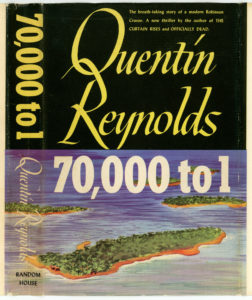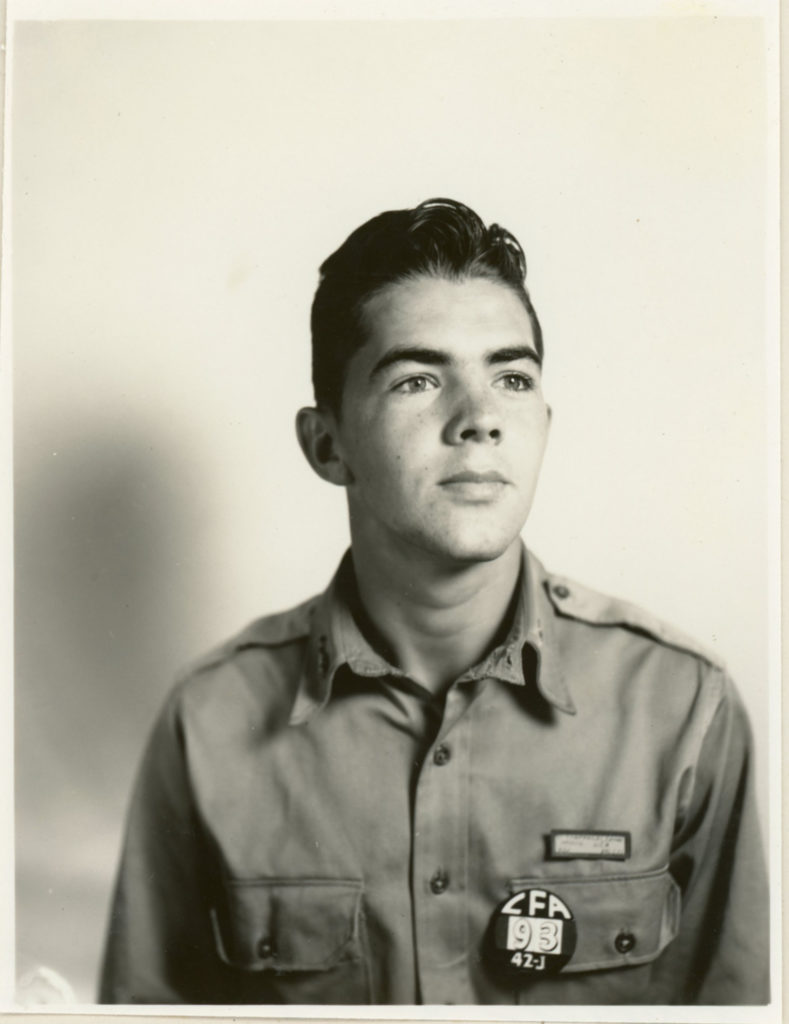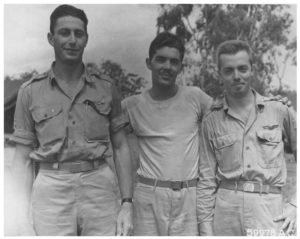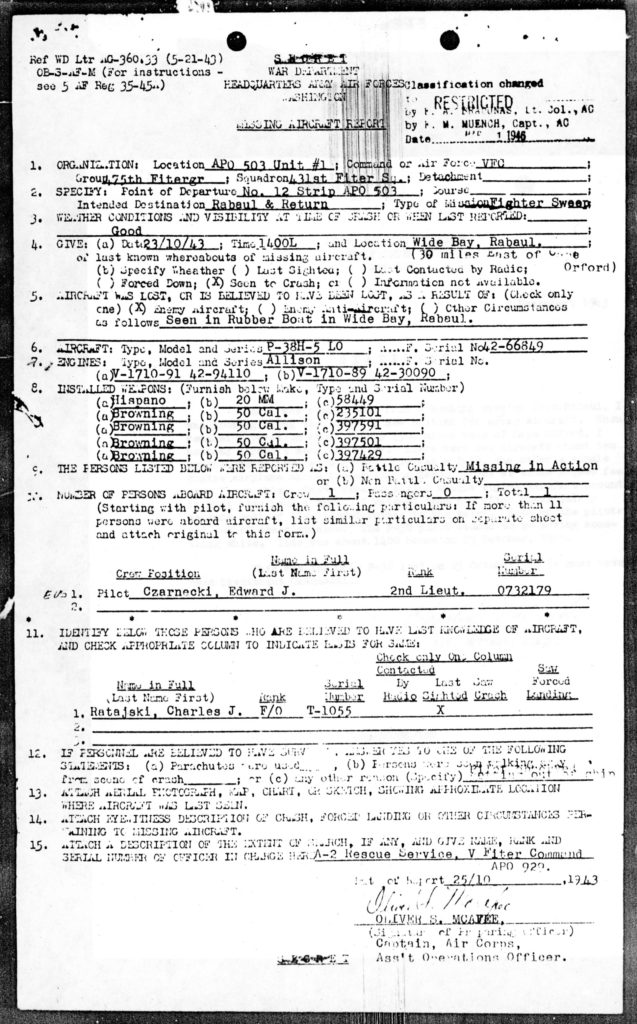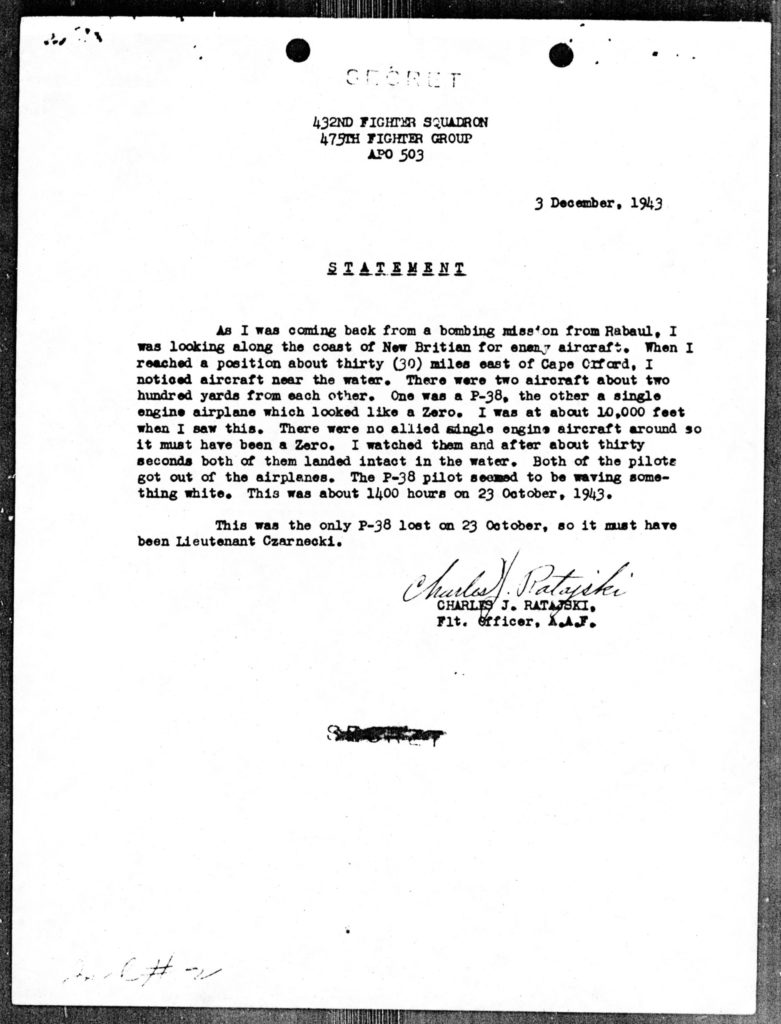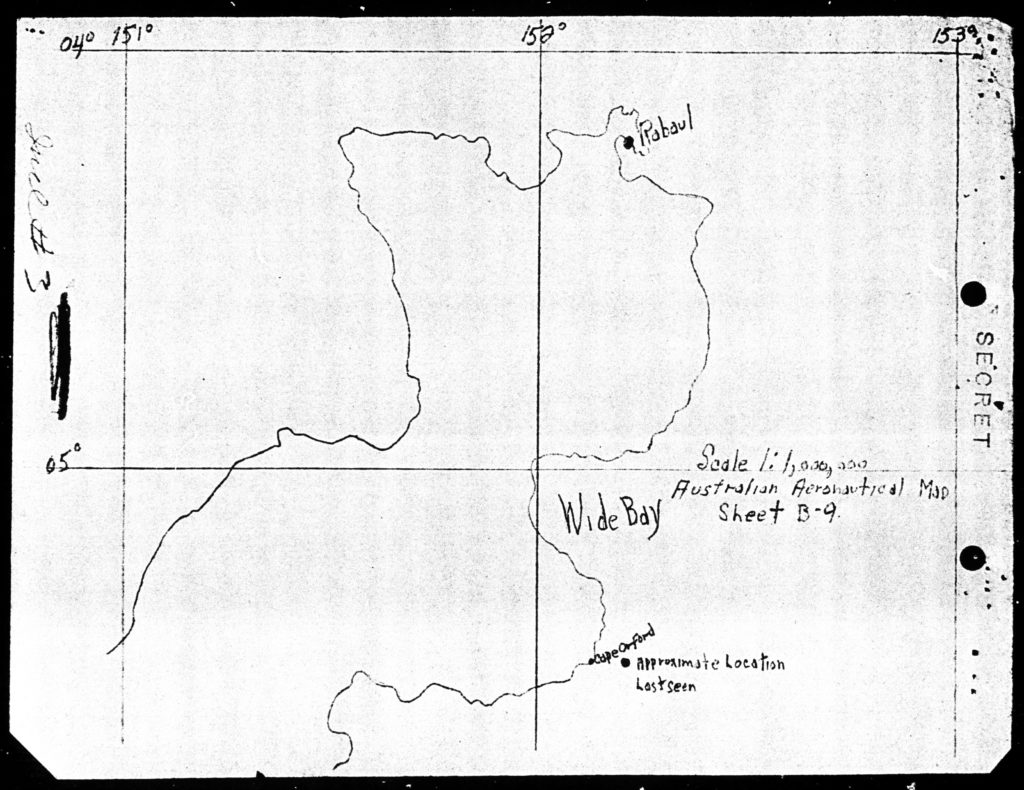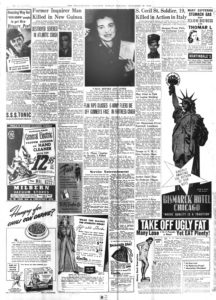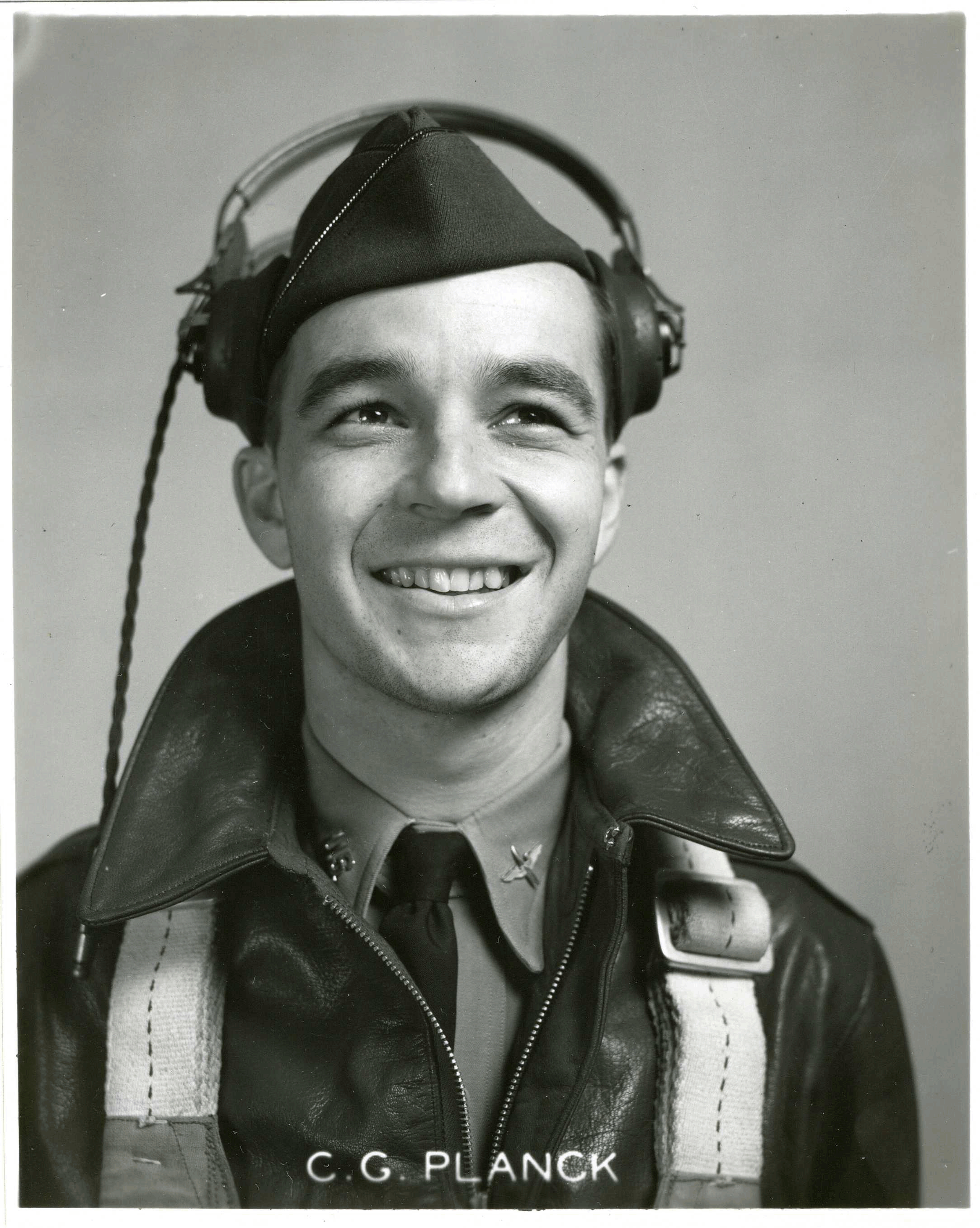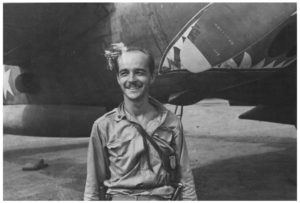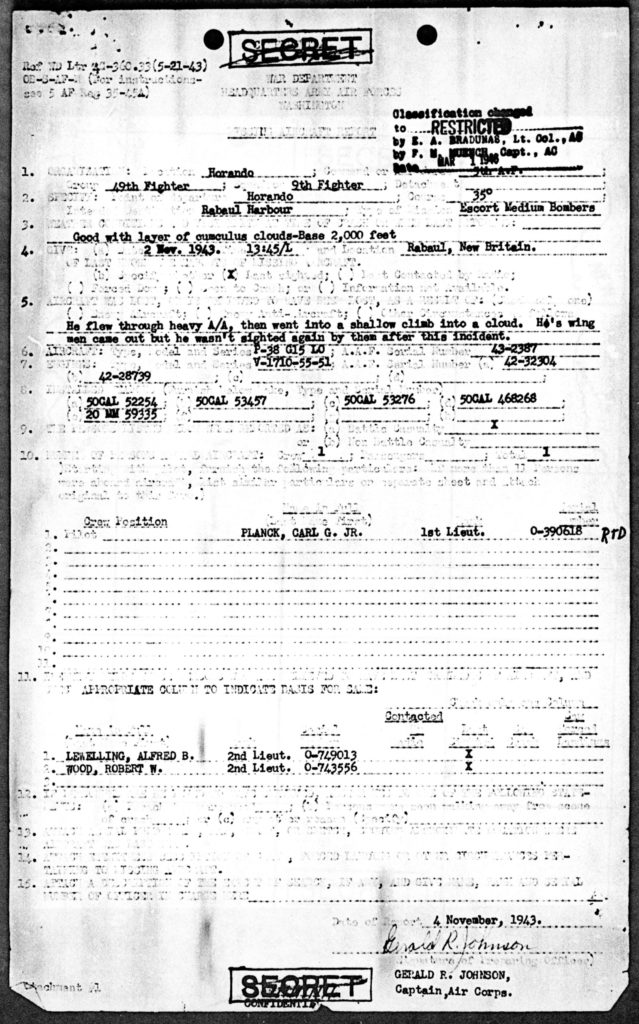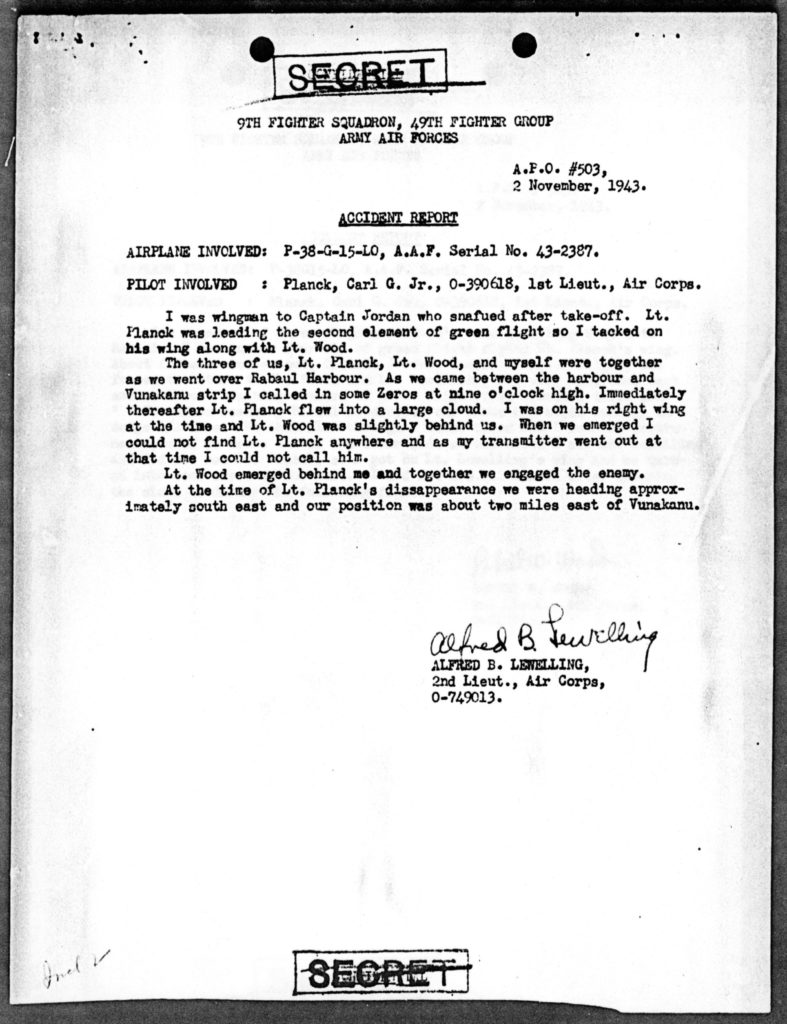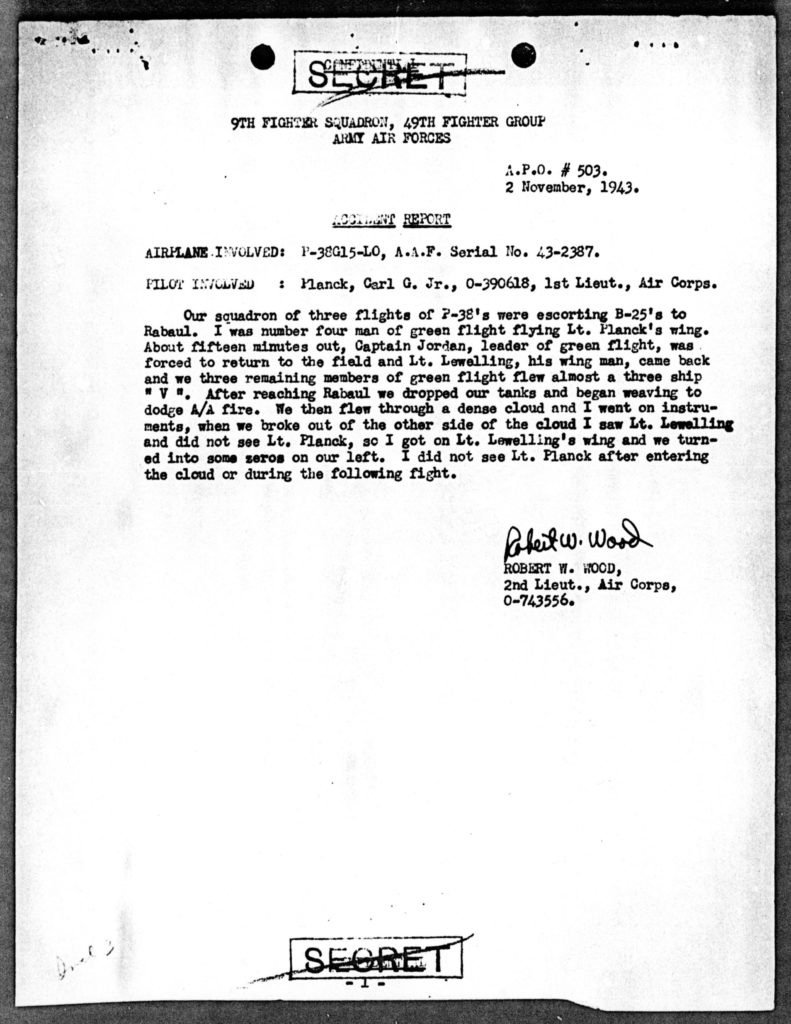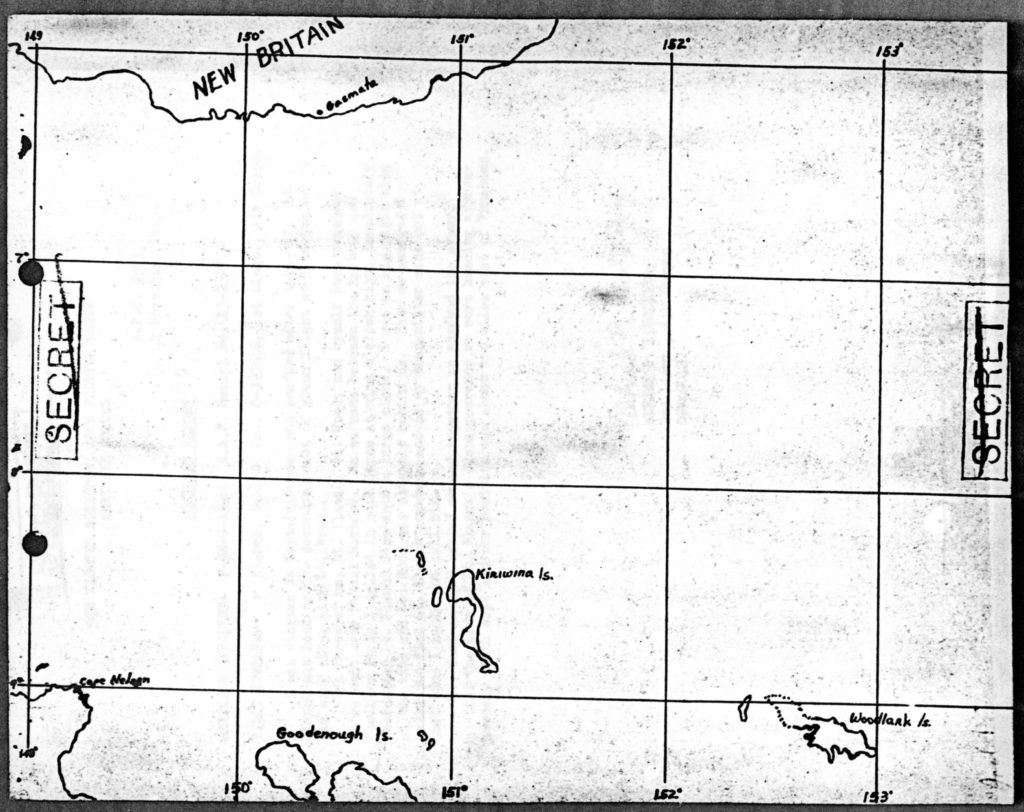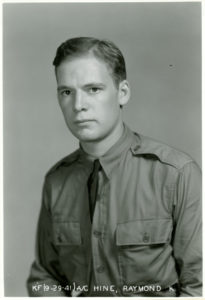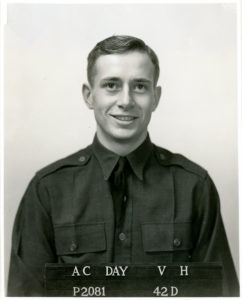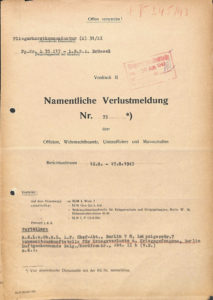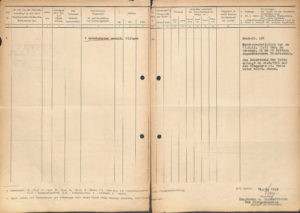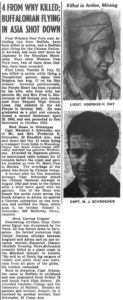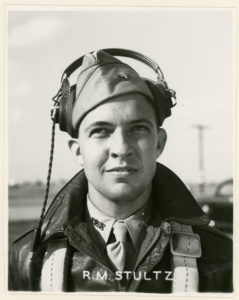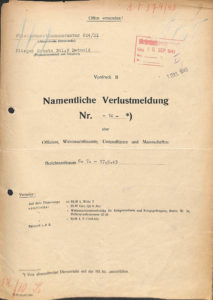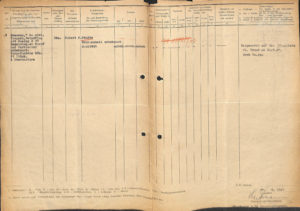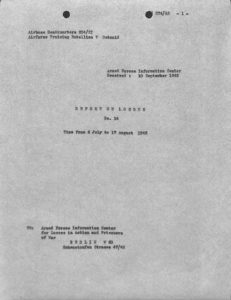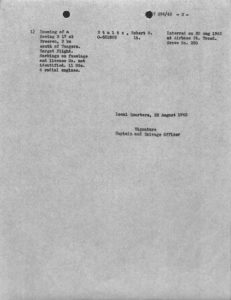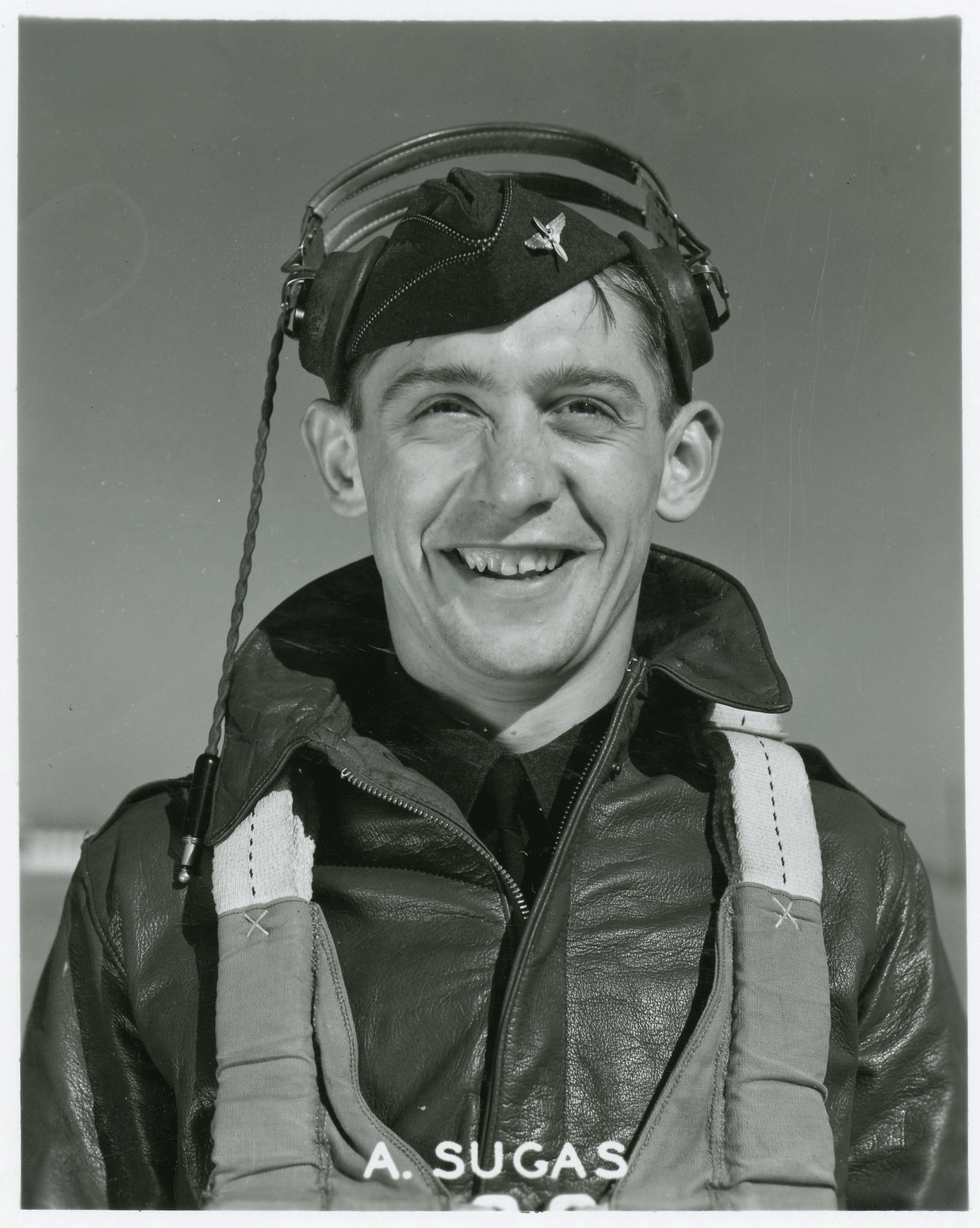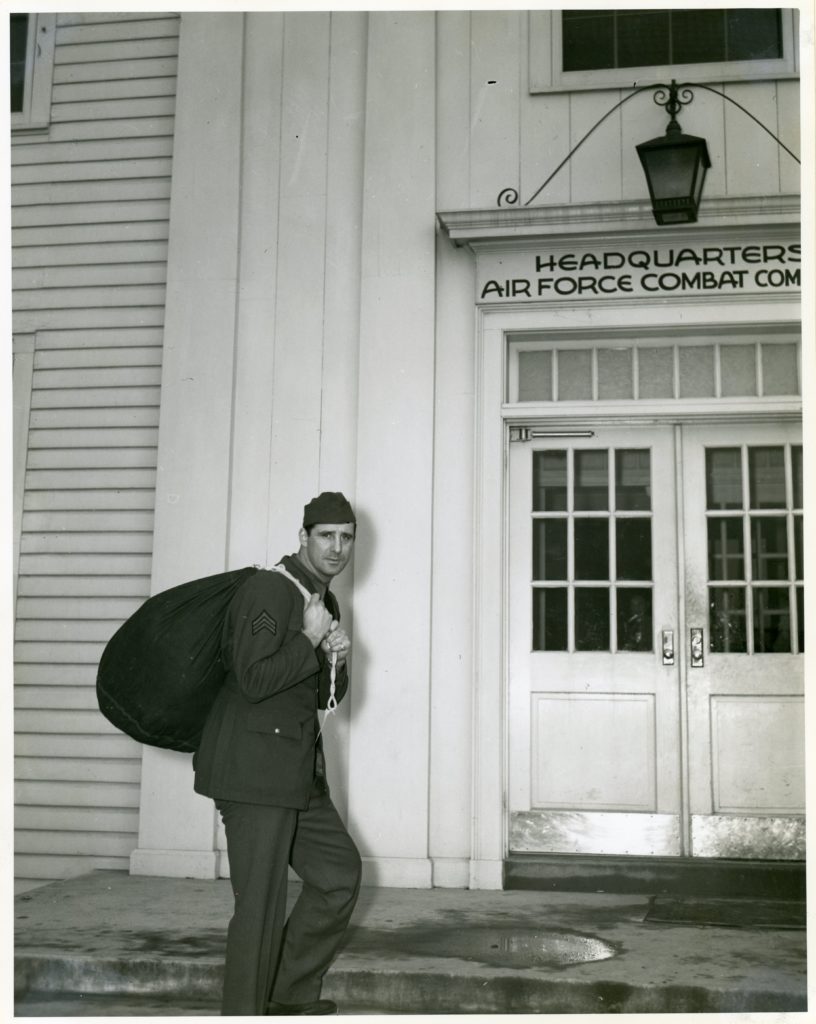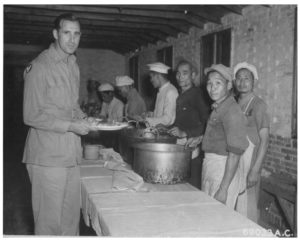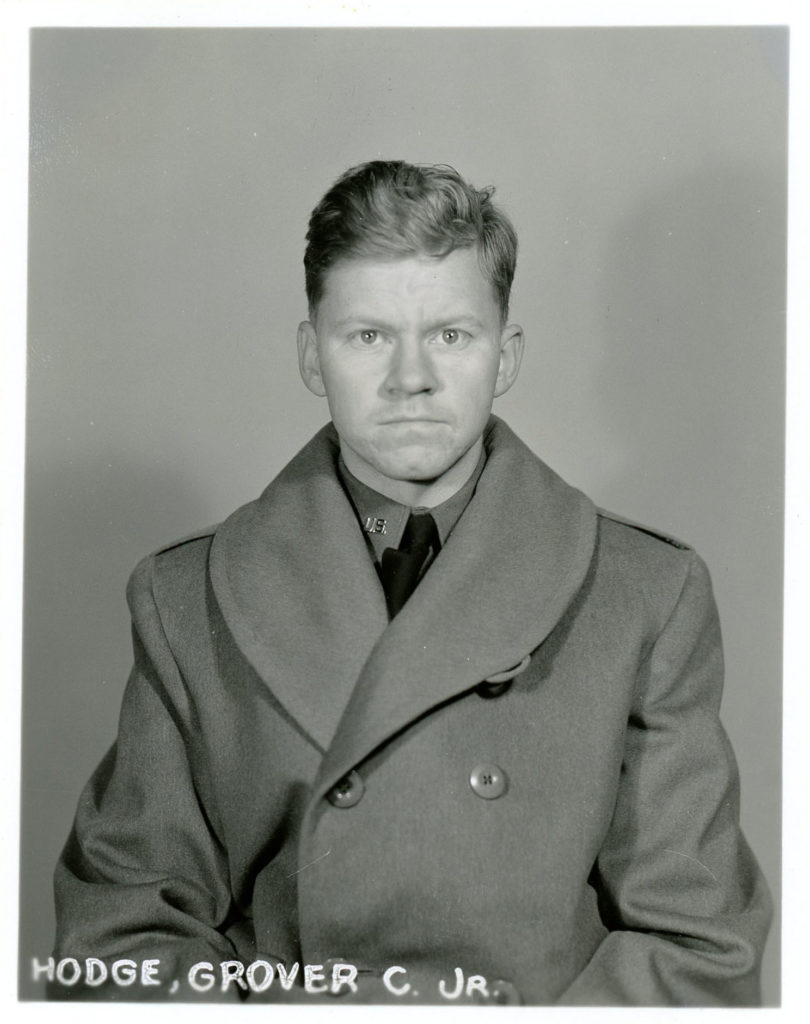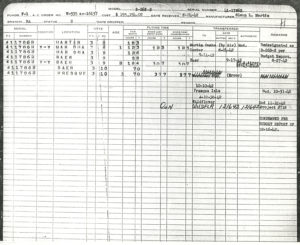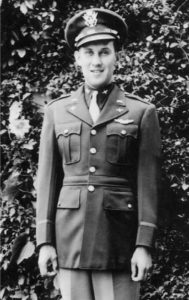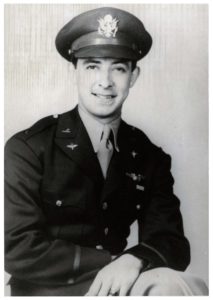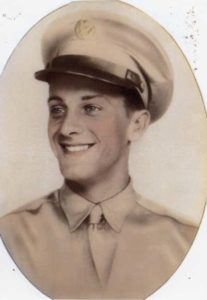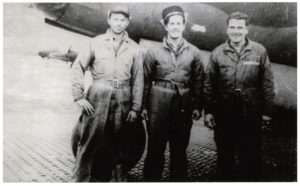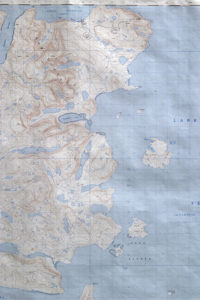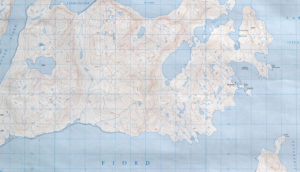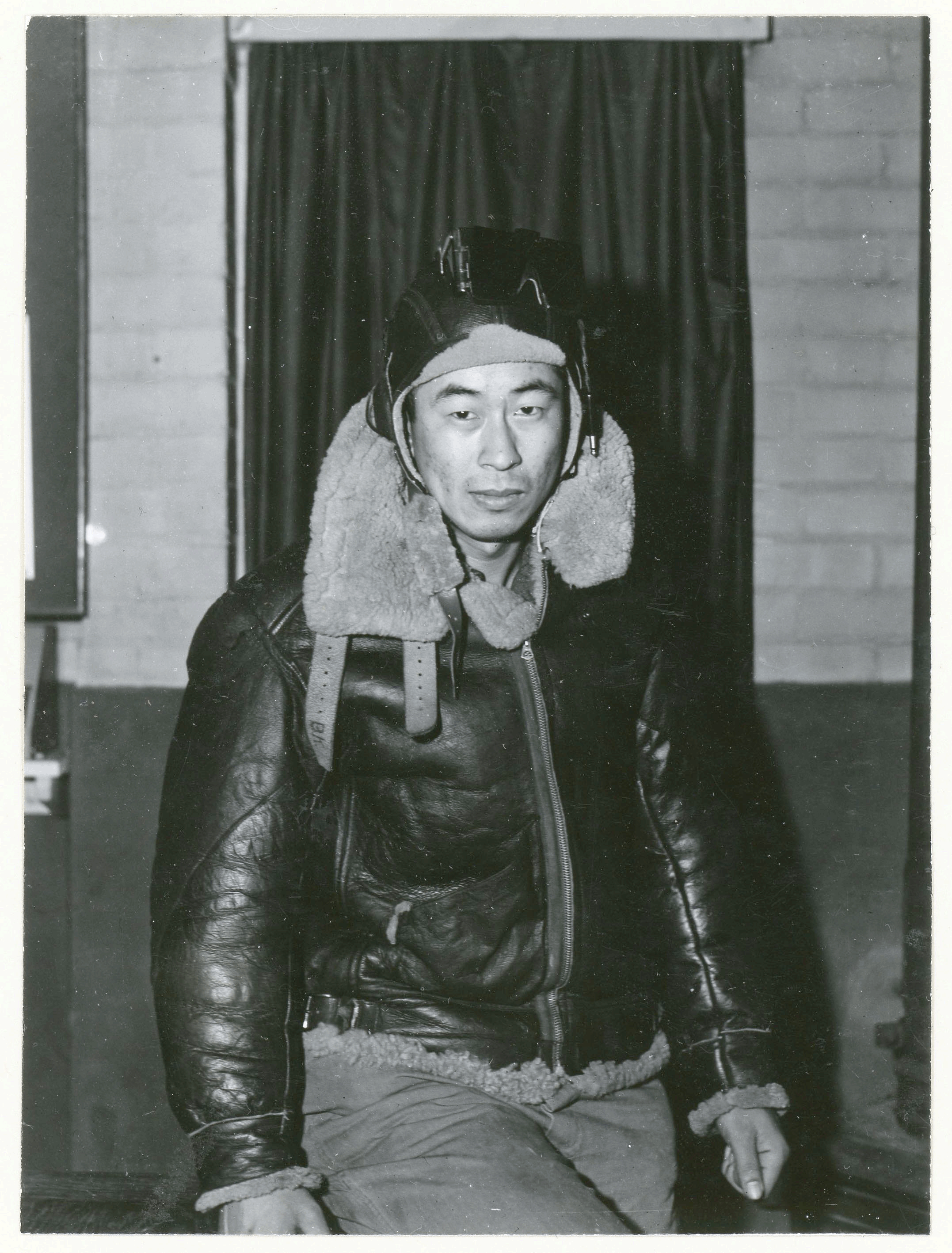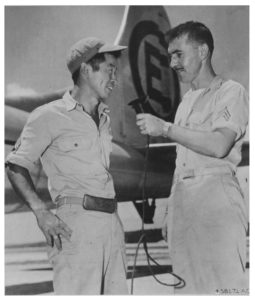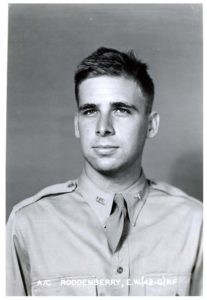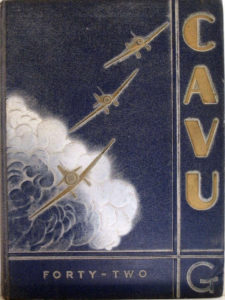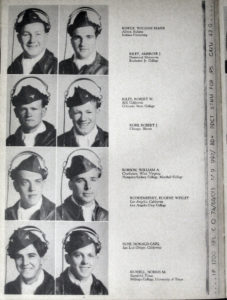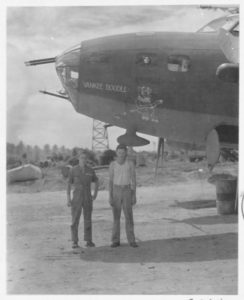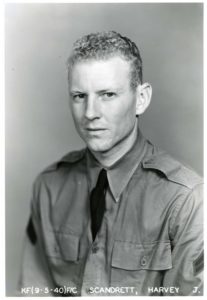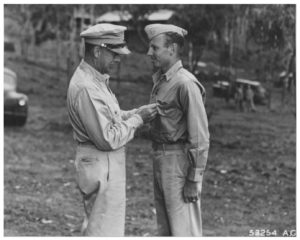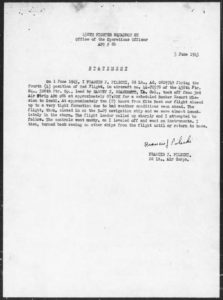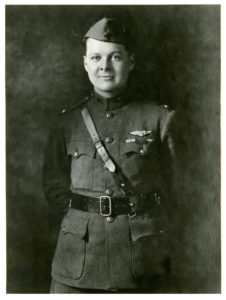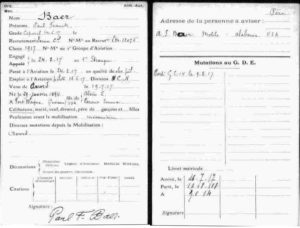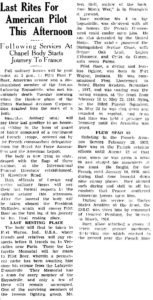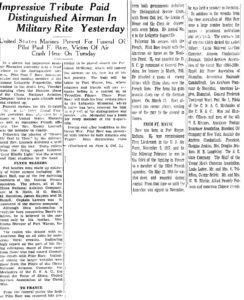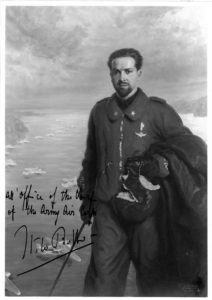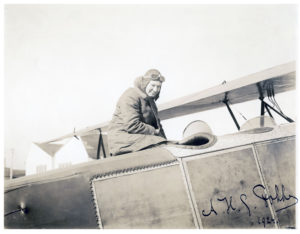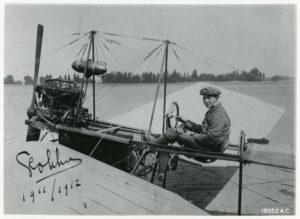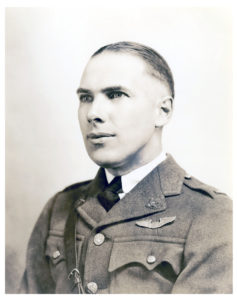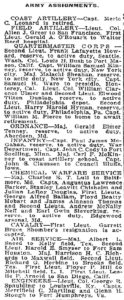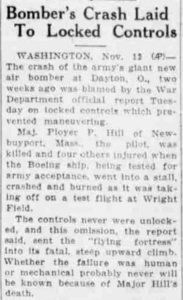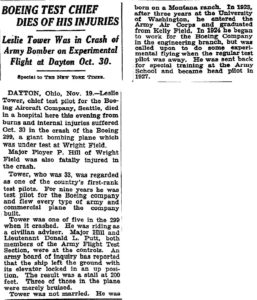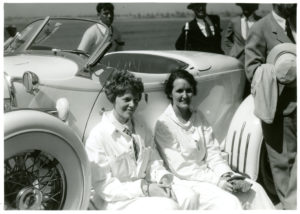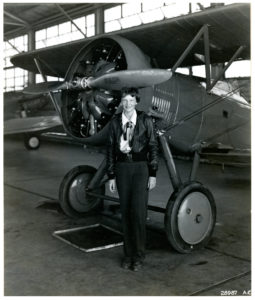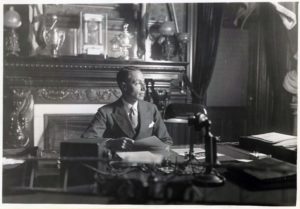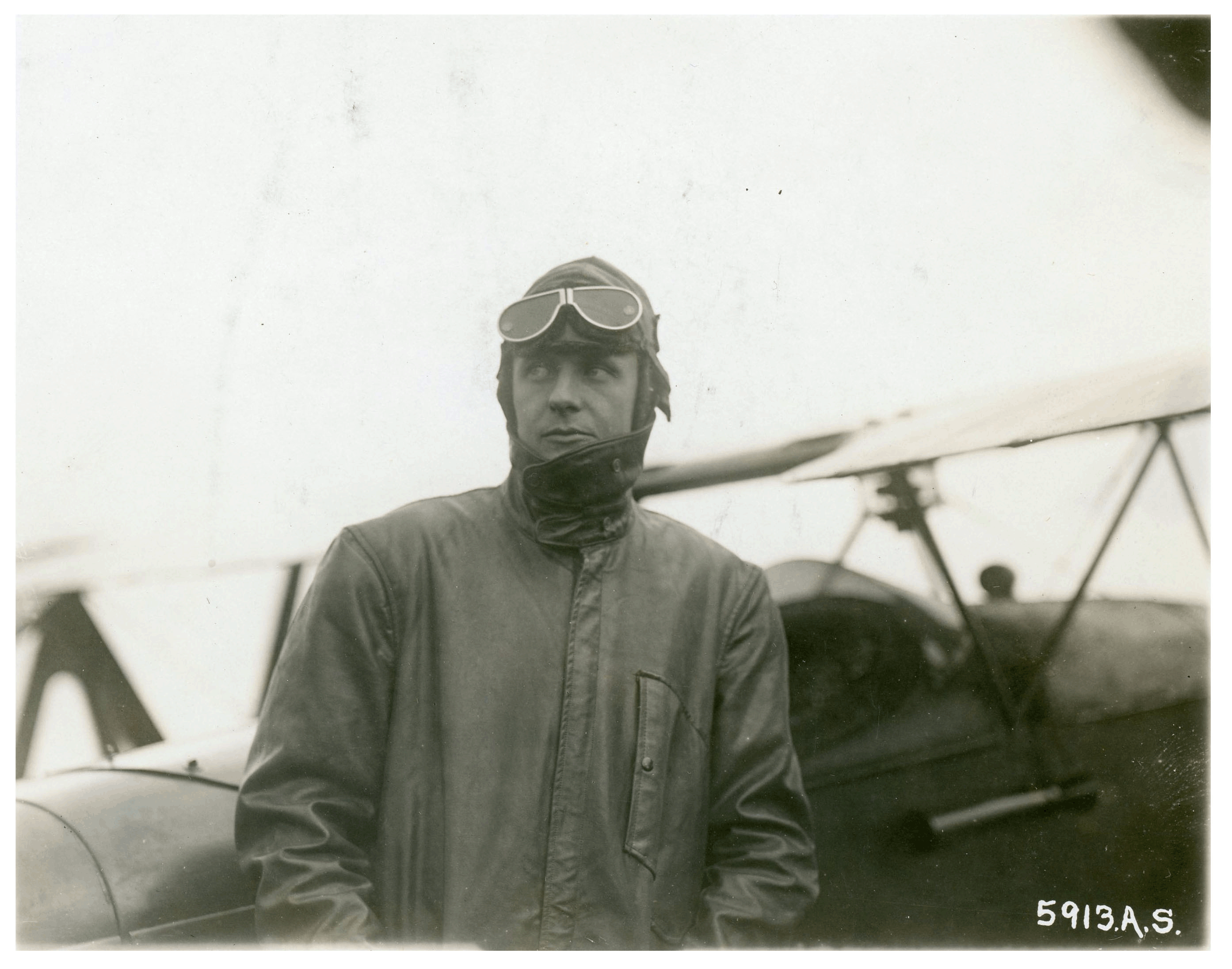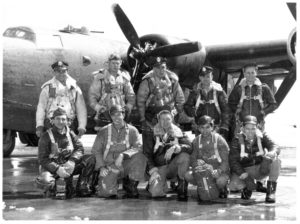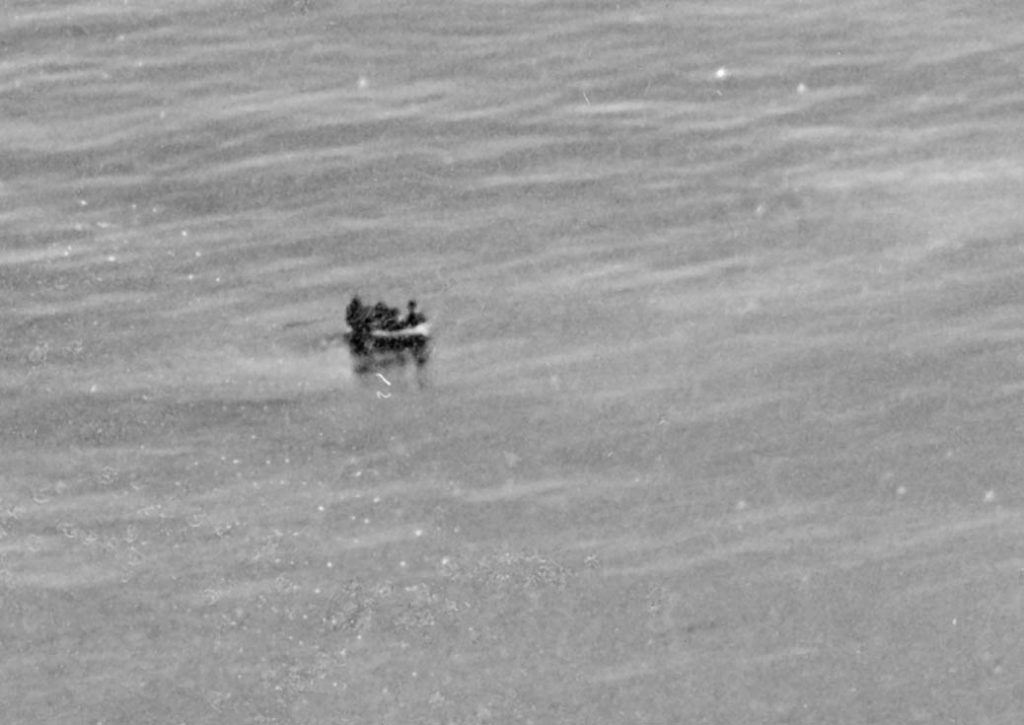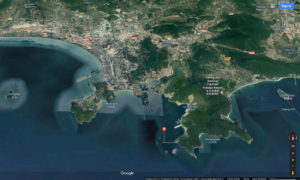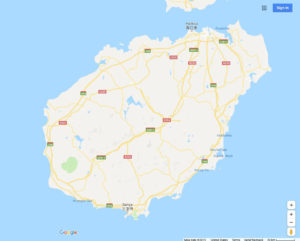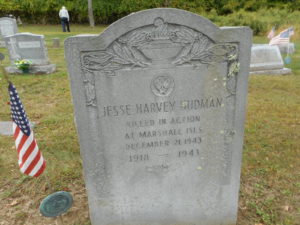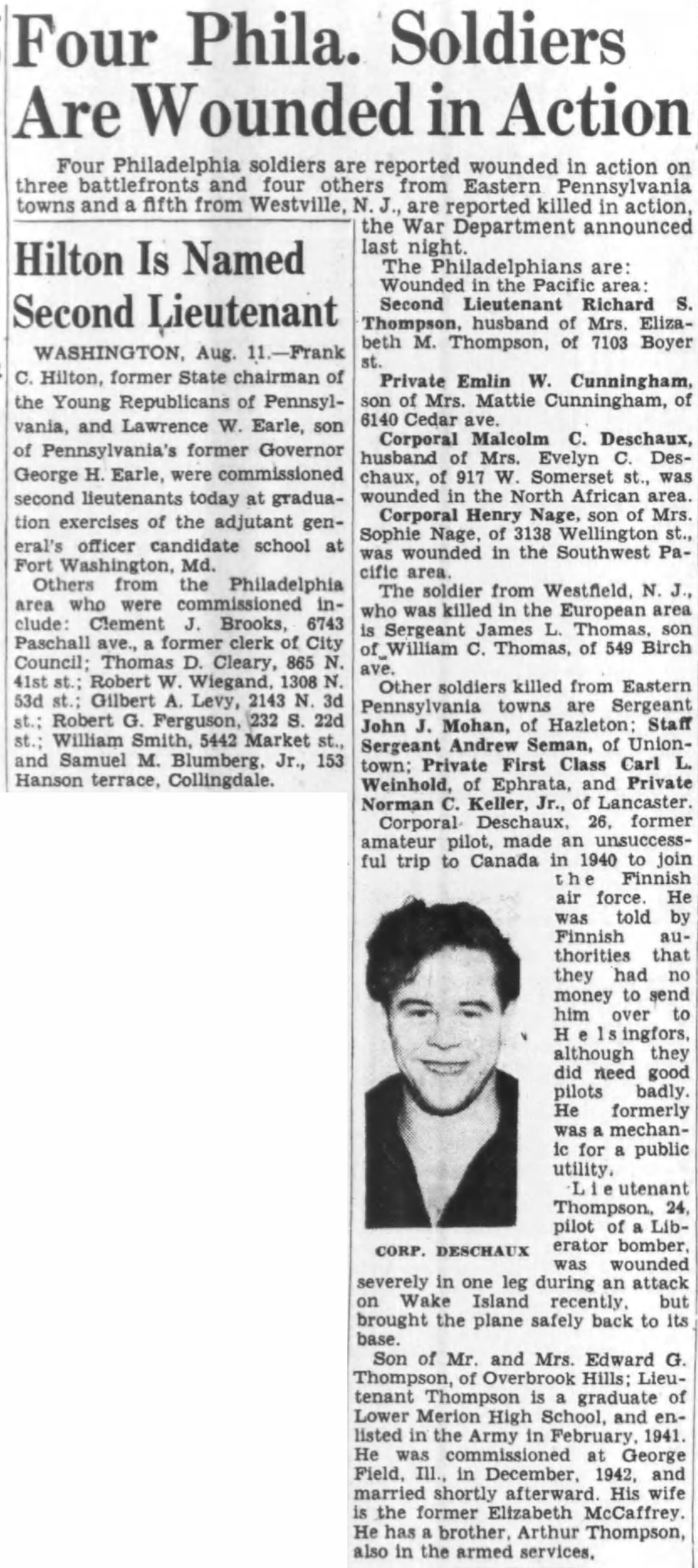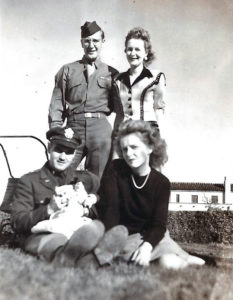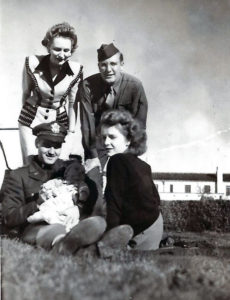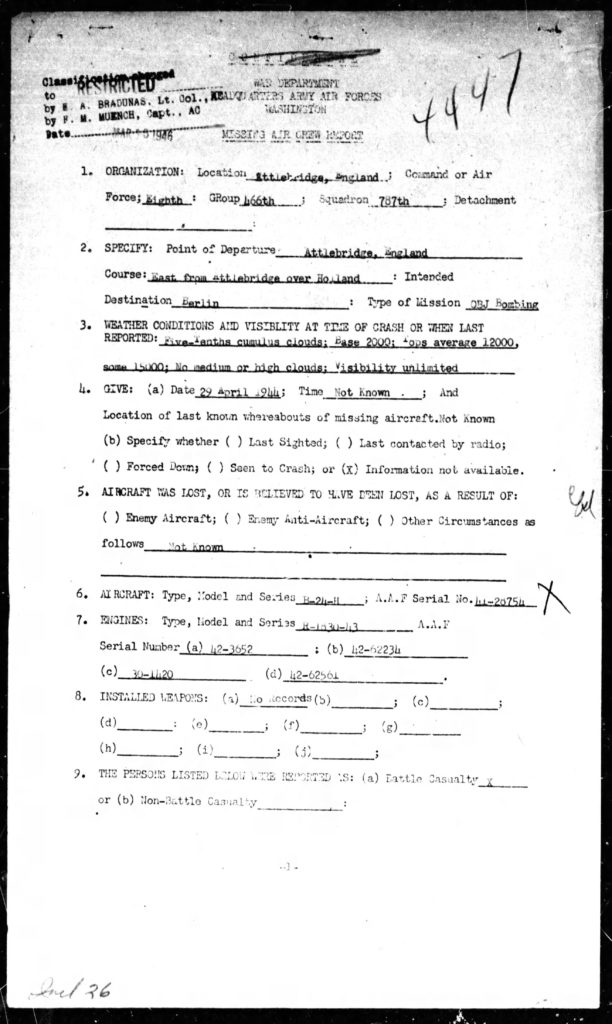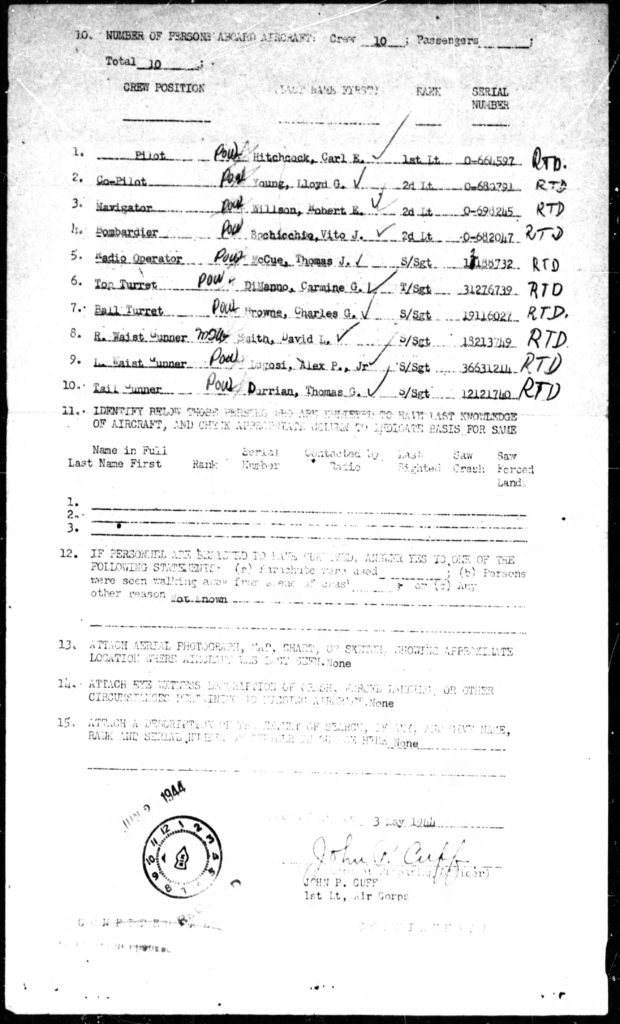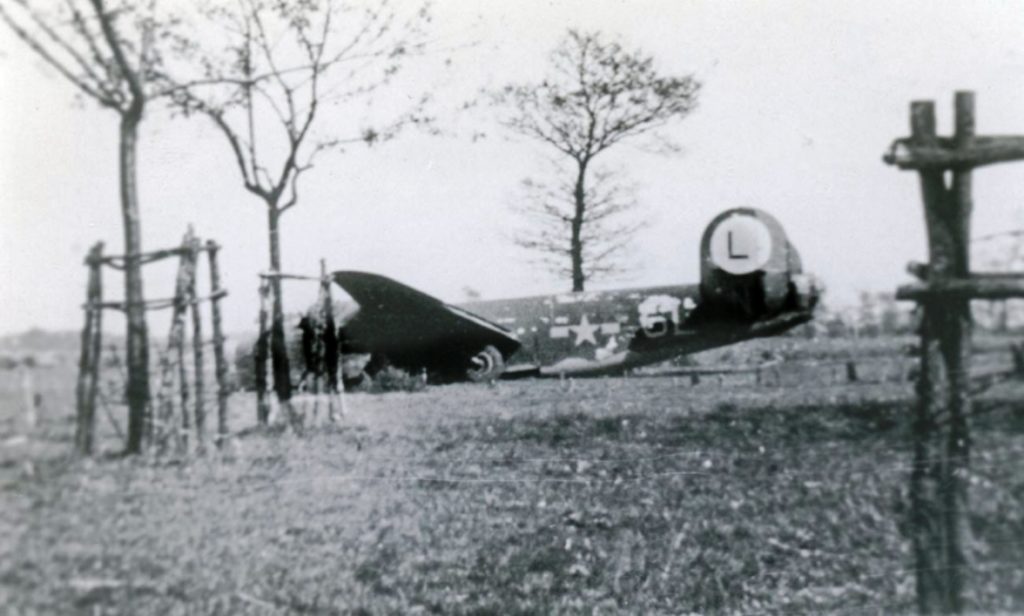I think this was so for me when I first read Quentin Reynold’s 70,000 to 1 in the late 1960s. Among the many books in my father’s library (the number seemed innumerable to me at the time, though in retrospect it was hardly so!), more than once I carried 70,000 to 1, Gene Gurney’s Five Down and Glory, or, William Green’s Famous Fighters of the Second World War (specifically, volume I of Famous Fighters; I discovered Volume II some years later) – to elementary school, where – whenever free time permitted, I immersed myself with curiosity, wonder and not-a-little-awe, within a past that that only recently – just a little over two decades previously – had passed. After all – so yes, this “dates” me – this was in the late 1960s, only two and a half decades after the end of the Second World War.
As so, in 70,000 to I, I read with wonder about the experiences of Sergeant Gordon Manuel of the B-17 Flying Fortress Honi Kuu Okole, incorrectly noted in the book – as I discovered later! – as Kai O Keleiwa. As you can appreciate from Justin Taylan’s book review of 70,000 to 1 at Pacific Wrecks, author Quentin Reynolds combines themes of military aviation, escape and evasion, and wilderness survival, to create a contemporary, fast-paced version of Robinson Crusoe.
A particularly inspiring aspect of the book was Reynold’s account of how Manuel met, and was eventually rescued with, American fighter pilots Owen Giertsen, Edward Czarnecki and Carl Planck. Those names must have left an impression upon me: In 2014, as I reviewed the photos in Photographic Prints of Air Cadets and Officers, Air Crew, and Notables in the History of Aviation – NARA RG 18-PU, I was more than intrigued to discover Czarnecki’s and Planck’s portraits: “So, that’s who they were!”
Their pictures appear below.
______________________________________
But, first (!) here’s the cover of the first (1946) hardback edition of 70,000 to 1, which features art by Miriam Woods. (You can view this and other aeronautically themed book art, and many other examples of cover art from books and pulp-fiction magazines, at my brother blog, WordsEnvisioned. (* Shameless plug *)
Here’s Quentin Reynolds. Specifically, Quentin James Reynolds.
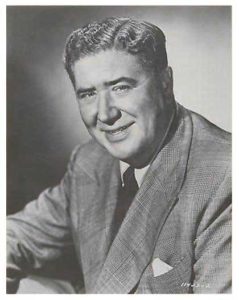
Quentin James Reynods, at Wikipedia
Quentin James Reynolds, at FindAGrave
Gordon R. Manuel, at Pacific Wrecks
_______________________________________
Second Lieutenant Edward John Czarnecki
431st Fighter Squadron, 475th Fighter Group, 5th Air Force
Edward J. Czarnekci, at Pacific Wrecks
P-38H 42-66948, at Pacific Wrecks
Edward J. Czarnecki, at FindAGrave
Here’s an official WW II Army Air Force Photograph of Lt. Czarnecki and two other fighter pilots, undated image 59978AC (A48682). Caption: “This trio of P-38 Lightning pilots knocked down five Japanese Zeros in engagements near Wewak, New Guinea on August 16 and 18, 1943, when more than 200 enemy planes were destroyed. They are, left to right: Capt. William Walderman of Santa Monica, Calif.; 2nd Lt. Edward Czarnecki of Wilmington, Del.; and 1st Lt. Jack Mankin of Kansas City, Mo. Their count: Walderman, one; and two each for Czarnecki and Mankin.”
MACR 1235 for P-38H 42-66849 and Lt. Planck, missing on October 23, 1943. These digital images were scanned from paper photocopies which were themselves made from a fiche copy of the MACR.
Edward Czarnecki’s name appeared within a list of military casualties published in The Philadelphia Inquirer on November 28, 1943. Since northern Delaware and southern New Jersey were (still are) within the Inquirer’s primary geographic area of news coverage (…not that I actually r e a d the Inquirer…I don’t…but that’s off topic…), the names of military casualties from Wilmington, Delaware, the vicinity of Camden, New Jersey, and southern ‘Jersey “in general” not uncommonly appeared in the newspaper.
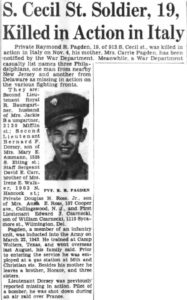
The image below shows “setting” of the above article: Page 2. Unlike The new York Times, where WW II casualty lists – regardless of length – appeared several pages well “into” the body of the newspaper, WW II casualty lists in the Inquirer always appeared or at least commenced on the paper’s first or second pages. As the war progressed and casualty lists inevitably became longer, the “first” part of most lists would typically appear “below the fold” on the newspaper’s front page, and continue a few pages into the body of the paper.
The timing of publication this particular list is actually typical of the appearance of most WW II casualty lists in the (then) print news media: There was usually (usually…) about a month time lag between the date on which a serviceman was killed, wounded, or missing in action, and the appearance of his name within Casualty Lists released by the War Department. Thus, a little over one month transpired between Czarnecki’s shoot-down on October 23, 1943, and his name’s appearance in the Inquirer on November 28.
________________________________________
First Lieutenant Carl G. Planck
9th Fighter Squadron, 49th Fighter Group, 5th Air Force
Here’s Lt. Planck in an official Army Air Force (undated, but obviously (!) pre-November 1, 1943) photo (122747AC (A32518)). Caption: “A member of the United States Army Air Force fighter squadron that destroyed seventy-two Japanese planes in aerial combat in New Guinea from June 1, 1942 to January 8, 1943 shortly after the fall of Buna Mission, is shown here. He is Second Lieutenant Carl G. Planck, 8 Sutherland Avenue, Charleston, South Carolina, with one confirmed victory.”
MACR 1016 for Lt. Planck and P-38H 43-2387, missing on November 1, 1943. Akin to the MACR for Lt. Czarnecki, these digital images were scanned from paper photocopies, made from fiche.
Carl G. Planck, at Pacific Wrecks
P-38G 43-2387, at Pacific Wrecks
________________________________________
First Lieutenant Raymond K. Hine
339th Fighter Squadron, 347h Fighter Group, 13th Air Force
Operation Vengeance – the aerial interception and killing of Admiral Isoroku Yamamoto by P-38 Lightnings of the United States army Air Force (specifically, the 339th Fighter Squadron of the 347th Fighter Group) on April 18, 1943 – has continued to be the subject of a vast amount of attention, commentary, and study. I myself first learned about this story in the Ballantine Books’ paperback Zero, by Masatake Okumiya, Jiro Horikoshi, and – a h e m – Martin Caidin, where the story is covered in Chapter 20. Appropriately headed “Admiral Yamamoto Dies in Action”, the events of that day are presented from both (primarily) the Japanese, and (secondarily) the American vantage points. Therein, in terms of American losses, is found the simple statement, “Our pilots shot down Lieutenant Ray Hine’s P-38; and, we verified later most of the fifteen P-38s which returned to Guadalcanal were badly shot up.” Regardless of the degree of accuracy in the account given in Zero, I was struck by the irony – for lack of a better word – of Hine being the only American pilot not to have returned from the mission. And then, years later, I found his photograph in NARA RG 18-PU. “So, that’s who he was…”
This portrait of Raymond Hine was taken at Kelly Field on September 29, 1941. Two additional portraits of him (one of which also appears at Pacific Wrecks) at can be found in his biographic profile at FindAGrave.
1 Lt. Raymond K. Hine, at FindAGrave
1 Lt. Raymond K. Hine, at PacificWrecks
1 Lt. Raymond K. Hine, at Historynet
]]>However, another aspect of the Mission 84 – certainly recorded; certainly noted; certainly in the historical record – was the loss of three P-47 Thunderbolts of the 56th Fighter Group. As described by Martin Middlebrook in The Schweinfurt-Regensburg Mission – American Raids on 17 August 1943:
“The Americans suffered some casualties. In the 62nd Squadron, Lieutenant Voorhis Day and his wingman, Lieutenant Robert Stultz, were seen to go down on some of the Messerschmitt 110s and, although their voices were heard happily talking about a possible success for Day, neither was seen again by their fellow pilots. It is probable that both were caught by German single-engined fighters. ‘Daisy’ Day’s friends later tried to secure for him the credit for shooting down two Messerschmitt 110s, but confirmation of this was not granted by American authorities. The third American casualty occurred in that part of the 63rd Squadron which had remained aloft, the officer leading two flights of P-47s preferring to stay as high cover well above the battle – much to the annoyance of the other pilots in those fighters. These American fighters were then ‘jumped’ by two German planes coming down from an even greater altitude and the P-47 of Lieutenant Arthur Sugas was shot down. Lieutenant Harold Comstock promptly attacked and shot down one of the Germans but was later disgusted to be fined £5 by his flight leader for breaking formation without orders. Comstock says, ‘My very first enemy aircraft destroyed had cost me twenty bucks! I was sorry to have seen my friend Sugas go down but I have to be honest and say that the elation of my first success was by far the uppermost emotion at that moment. I didn’t know he was dead; I really thought he would get out.’ Lieutenants Sugas, Day and Stultz, all original members of the 56th Fighter Group when it came to England, died. Their P-47s crashed between Liege and Maastricht. Five German pilots from three different Luftwaffe units claimed these American fighters.”
These three pilots were lost in the following aircraft; recorded in the following Missing Air Crew Reports:
1 Lt. Voorhis H. Day, 62nd Fighter Squadron: P-47D 42-7891, LM * M, in MACR 264
1 Lt. Robert M. Stultz, 62nd Fighter Squadron: P-47C 41-6398, LM * H, Joan L. Sullivan, MACR 263
1 Lt. Arthur Sugas, 63rd Fighter Squadron: P-47C 41-6372, UN * S, MACR 265
Something a b o u t the loss of these pilots – three fighter planes and three men, versus sixty bombers and some six hundred men – reminded me of a literary trope not uncommonly found in association with works of literature (typically fiction, but not always fiction) related to military history, pertaining to losses, casualties, and the deaths of soldiers, as viewed through the vastly larger scope of any randomly chosen day’s events. To the effect that, “Our losses were light today. We only lost ‘so-and-so’ number of men.” Maybe so, but not so “light” if you’re one of that number.
And so, when I reviewed the portraits in the collection Photographic Prints of Air Cadets and Officers, Air Crew, and Notables in the History of Aviation – NARA RG 18-PU, at the United States National Archives, and discovered images of Day, Stultz, and Sugas, a bell of recognition rang quietly within my memory.
So, these images appear below.
I’ve included links to the three pilots’ biographical profiles at FindAGrave, and for Day and Stultz, have included images of the German Luftgaukommando Reports reporting the shoot-downs of their planes. These reports aren’t the (perhaps?) more well-known “J Reports”, but instead AV (Amerikaner Vorgaenge [“American Incident”]) reports: AV 245 / 43 for Day, and, AV 374 / 43 for Stultz; there doesn’t seem to be one for Sugas. I’ve also included several Buffalo city newspaper articles about Voorhis Day, found via Tom Tryniski’s Fulton.History website.
Notably, the Wikipedia entry for the Schweinfurt-Regensburg mission mentions the loss of two Spitfires of Number 403 (RCAF) Squadron. These aircraft, both Spitfire IXs, were on afternoon Ramrod 206 to Ghent, Belgium. Aircraft MA615, piloted by F/Sgt. Graham Milton Shouldice, collided with aircraft LZ997, piloted by F/Lt. W.C. Conrad, DFC. MA615 crashed into the sea, but Conrad was able to bail out successfully. Evading capture, he returned to England via Spain by October 10, 1943. Other Fighter Command losses that day were Mosquito VI HX826 of No. 25 Squadron (both crew POWs), Typhoon 1B DN553 of No. 182 Squadron (pilot killed), and a Spitfire IX of No. 341 Squadron (fate of pilot unknown).
And so, the portraits.
________________________________________
First Lieutenant Voorhis H. Day
Voorhis H. Day, at FindAGrave
Amerikaner Vorgaenge (AV) Report AV 245 / 43
Note that at the time of the filing of this report, Voorhis was unidentified.
____________________
Army Air Corps To Train Youth
Buffalo Courier Express
October 27, 1939
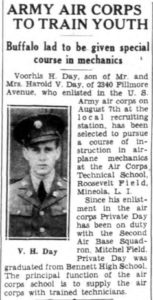
____________________
Buffaloian Graduated From Army Air School
Buffalo Evening News
April 26, 1940
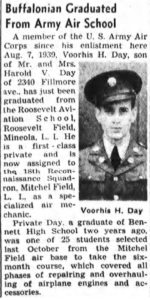
____________________
Day-Zimmerman (wedding)
Buffalo Evening News
June 4, 1942
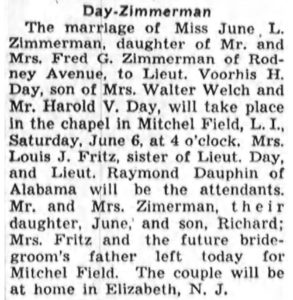
____________________
4 From WNY Killed; Buffaloian Flying In Asia Shot Down
Buffalo Evening News
February 24, 1944
________________
In The Nation’s Service
by Betty Harries
Buffalo Evening News
April 1, 1944
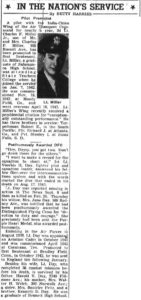
________________________________________
First Lieutenant Robert Mark Stultz
Robert M. Stultz, at FindaGrave
Amerikaner Vorgaenge (AV) Report 374 / 43
Note the English-language translation, below.
________________________________________
First Lieutenant Arthur Sugas
MACR 265
While circling bombers over Ans approximately 30 FW 190’s made a head on attack on the bombers. I was flying Postgate White 4, and Lt. Sugas, Postgate White 3. Two FW-190s closed in on us at about 29,000 feet, and started firing. I tried to contact Lt. Sugas over the R/T, but was unable to reach him. I broke into the E/A and dove down. This was the last I saw of Lt. Sugas. I do not believe he followed me down.
George A. Compton
2nd Lt., A.C.
Arthur Sugas, at FindAGrave
References
Franks, Norman L.R., Royal Air Force Fighter Command Losses of the Second World War – Volume 2 – Operational Losses: Aircraft and Crews 1942-1943, Midland Publishing, Limited, Leicester, England, 1998
Middlebrook, Martin, The Schweinfurt-Regensburg Mission – American Raids on 17 August 1943, Penguin Books, London, England, 1985 (pp. 259-260)
]]>________________________________________
Hank Greenberg (Henry Benjamin Greenberg)
“Nicknamed “Hammerin’ Hank”, “Hankus Pankus”, or “The Hebrew Hammer”, was an American professional baseball player and team executive. He played in Major League Baseball (MLB), primarily for the Detroit Tigers as a first baseman in the 1930s and 1940s. A member of the Baseball Hall of Fame and a two-time Most Valuable Player (MVP) Award winner, he was one of the premier power hitters of his generation and is widely considered as one of the greatest sluggers in baseball history. He had 47 months of military service including service in World War II, all of which took place during what would have been prime years in his major league career.”
A candid shot of Hank Greenberg in NARA RG-18 PU.
Here’s an official Army Air Force photo of Greenberg, image 69033AC (A2336). Caption? “Captain “Hank” Greenberg, famous baseball personality, pauses a minute before continuing through the chow line at a 14th Air Force base in China.” The actual date of the photo is unknown, albeit text on the photo card states, “Orig. 4×5 neg rec’d 27 August 1946 from 14th Air Force thru AAF Historical Office.” However, VintageDetroit states that Greenberg reenlisted in the Army seven weeks after the Japanese attack on Pearl Harbor, “…accepting a position as a sergeant in the Army Air Force, and a few weeks later he finished officer training school and was commissioned a first lieutenant. He stayed in the uniform of the United States military for the next three and a half years. His last position was in the China/India/Burma Theater of Operations where he scouted bombing targets for B-29s. In all, Greenberg served 47 months in the service during World War II, the longest tenure of any ballplayer.”
Hank Greenberg, at Wikipedia
Hank Greenberg, at FindAGrave
National Baseball Hall of Fame
Video
The Life and Times of Hank Greenberg, at Keith’s (Mr. Sports Historian) YouTube channel
________________________________________
Grover Cleveland Hodge, Jr.
Of the five aviators whose images are presented in this post, the names of two – Hank Greenberg (above) and Gene Roddenberry (see below…) – are known to a lesser or greater degree by the general public, while knowledge of another – Ben Kuroki – is probably limited to WW II aviation buffs, historians of American aviation, and scholars of Japanese American history. But, here’s a fourth personality – or much more aptly and succinctly phrased, a person – knowledge of whom is probably limited only to historians of aviation, those knowledgeable about Canadian history, and (especially?) students of wilderness exploration and outdoor survival: First Lt. Grover C. Hodge, Jr.
Lt. Hodge was the pilot of B-26B Marauder 41-17862, otherwise known as “TIME’S AWASTIN”, an aircraft of the 440th Bomb Squadron of the 319th Bomb Group, which crashed near Saglek Bay, Labrador on December 10, 1942, during a planned flight from Narsarsuaq, Greenland to Goose Bay, Labrador. The plane’s compliment of seven crewmen (including Hodge) survived the crash-landing entirely uninjured. But alas, they did not survive.
A few links to information about this story are given below.
Grover C. Hodge, Jr., at FindAGrave
B-26B 41-17862, at Aviation Safety Network
Here’s the accident report for B-26B 41-17862: Accident Report 43-12-10-501. Note that relatively little of the report focuses on the fate and experience of the crew between the time they crash-landed, and, their discovery by an Eskimo several months later. Instead, most of the document is comprised of descriptions of flight activity on December 10, and, weather conditions.
Grover C. Hodge, Jr.’s Diary, at B-26.com
Saglek Airport, at Wikipedia
Crash in the Wilderness, at The DEWLine
Clarence Simonsen has done extensive research about the loss of 41-17862, his lengthy write-up exploring the event in great detail, with tact and sensitivity. He presents the intriguing (and haunting) possibility that Janssen, Josephson, and Nolan may actually have survived their life-raft journey along the Labrador coast, landed in the vicinity of Nain, and hiked into the Canadian wilderness for an unknown distance. Well, we’ll never know. His essay about 41-17862 is “Smilin’ Jack and the “Twin Engine Queenie”, while his blog is “Preserving the Past II – 50 Years of Research About Aviation“)
Oyster, Harold E., and Oyster, Esther M., The 319th in Action (Records of the 319th Bombardment Group as Recorded by Lieutenant William B. Monroe, Jr., Public Relations Officer, and Others), 1976
____________________
Here’s the Historical Record card for B-26B 41-17862. The aircraft was received by the Army Air Force on August 24, 1942.
____________________
Here are images of three of TIME’S AWASTIN’s crew members. For those who already know this story (and others who have yet to become familiar with it), Janssen and Josephson (with Sgt. Charles F. Nolan, a passenger) left the crash site in the aircraft’s life raft on December 23, in search of help; in search of anything. The three men – alluded to just above; their fate yet and perhaps forever unknown – were never seen again. Their names are engraved upon the columns of the East Coast Memorial, in Manhattan.
Co-Pilot: 2 Lt. Paul W. Janssen, at FindAGrave
Tribute page by Mrs. Bernice Ulrich, at National WW II Memorial
____________________
Navigator (Bombardier): 1 Lt. Emanuel J. Josephson, at FindAGrave
____________________
Gunner: Cpl. James J. Mangini, Jr, at FindAGrave
Corporal Mangini remained at the crash site with Lt. Hodge, Cpl. Galm (radio operator), and Sgt. Weyrauch (flight engineer).
Tribute page by Mrs. Lorraine Suter, Cpl. Mangini’s sister, at National WW II Memorial
____________________
Here are links to FindAGrave biographical profiles for the three crewman for whom photographs are unavailable:
Cpl. Frank L. Galm, at FindAGrave
Sgt. Charles F. Nolan, at FindaAGrave
Sergeant Russell Weyrauch, at FindAGrave
____________________
The below image, probably taken by Lt. Josephson, shows three unknown aviators standing before an B-26, at an unknown location.
____________________
These two topographic maps, prepared by the Mapping and Charting Establishment, Canadian Department of National Defence (both 1968 editions) are (upper map) “Cape Uivak – Fish Island – Labrador North District (14L/7.8, Edition 2)”, Newfoundland, and (lower map) “Hebron – Labrador South District (14L/2, Edition 1)”, Newfoundland. The scale of the maps is 1:50,000 and the contour interval 100 feet.
Though I haven’t digitally “connected” images of he two maps to one another via Photoshop, you can see that the lower image, showing Hebron, is geographically continuous with and therefore cartographically “connected” to the upper image. As such, what immediately stands out is that a fjord – the Iterungnek Fjord – lies between the peninsula where Hebron is situated (in the “lower” map) and the peninsula where Cape Saglek and Saglek Airport are situated (in the “upper” map), 41-17862’s crash location being in the vicinity of that present-day airport.
As is immediately obvious, though the straight-line “as the crow flies” distance between the Saglek Lighthouse, south-southeast to Hebron, is a little over 20 miles, that relatively short distance does not at all reflect the topography, the nature of the intervening terrain, or especially – when those two factors are weighed in combination – the obvious lack of any direct path between the crash site and Hebron. Also, given the snow cover when 41-17862 crashed in mid-December, the safest (a very relative term) route between the crash site and Hebron would probably have involved following the highly irregular coastline east and south, along the Labrador Sea. Even if this could have been done, such a journey would have entailed the crew hiking a distance far, far beyond a mere 20 miles, and finally, finding some way to cross the Iterungnek Fjord to reach – on the adjacent peninsula – the village of Hebron.
So, even in the very best of circumstances… If the crew definitely knew their position; if they were all uninjured (well, they were uninjured to start; that’s true); if they were in good health (they seemed to have been in good health, to start); even if they had wilderness training and experience in outdoor survival during winter months in the Canadian North, the prospect of reaching Hebron – in the dead of winter over snow-covered terrain, or, along an icy coastline – would I think have been far more daunting than initially apparent from viewing small-scale maps of the area.
Dating from November of 2010, here’s a song; a ballad – with kind of an air of Gordon Lightfoot’s The Wreck of the Edmund Fitzgerald (in which you know the outcome of the story beforehand, wish that the outcome would have been entirely different, yet are still “drawn” to the story by its haunting and symbolic nature…) about the crew of “TIME’S AWASTIN”, by Ellis Coles, at the YouTube channel of Traprocker123. The song is based upon the diary kept by Grover Hodge from October 15, 1942 through February 3, 1943, while its title, “Diary of One Now Dead”, may (?), have been inspired by the title given to the diary transcript as published in The 319th in Action, in 1976, where Hodge’s diary comprises the final section of the book: “DIARY (BY ONE NOW DEAD).”
________________________________________
Ben Kuroki
“The only American of Japanese descent in the United States Army Air Forces to serve in combat operations in the Pacific theater of World War II. He flew a total of 58 combat missions over Europe, North Africa, and Japan during World War II.”
Here’s Ben Kuroki’s quite candid image in NARA RG 18-PU.
In 1985, Ben’s recollections of his experiences in the 20th Air Force appeared in Chester Marshall’s The Global Twentieth – An Anthology of the 20th AF in WW II. A complete transcript of Kuroki’s essay, as well as its accompanying photo, showing Kuroki in the tail gunner’s position, follows…
THE STORY OF DETERMINATION BY A JAPANESE-AMERICAN TAIL-GUNNER
By Ben Kuroki, Tail Gunner 484th Squadron, 505th Bomb Group
Preface
Ben Kuroki was the only Japanese-American to fly combat missions with the Army Air Force in the Pacific Theatre of War during World War II. And he did it only by sheer determination and persistence – going all the way to the top to get permission. A personal letter to him from Secretary of War Henry Stimson struck down the Air Force regulation prohibiting Japanese-Americans from flying combat missions in the Pacific thus allowing Ben to remain a B-29 crew member.
“Influential friends went to bat for me and I was granted an exception which allowed me to be accepted in the 505th Bomb Group as a tail gunner on a B-29,” Ben said. “Army intelligence officers twice tried to remove me from my crew before we departed the U.S. for the Pacific, making it necessary for me to show my special letter from Secretary of War Stimson.”
In preparing this article, I asked Ben if we could publish the letter from the Secretary of War along with his story. Ben replied: “Much to my dismay, I let my daughter use it in an art exhibit at the University of California at San Diego, and since then, we have not been able to find it.”
Chester Marshall
Here’s Ben’s story:
When I returned to the United States after completing thirty missions in B-24’s in the European Theatre, I was sent to Santa Monica, California for rest and recuperation. Because of a few discriminatory actions against me soon after arriving there, I decided to go to any length to get into B-29’s and the Pacific War.
At Santa Monica I was asked to appear on an NBC radio program featuring the noted singer Jenny Simms. My appearance was cancelled because NBC officials said the Japanese-American issue was too controversial. Later, I was in Salt Lake City, and a man refused to share a taxi with me, saying, “I won’t ride with no damned Jap!” This happened while I was in uniform and wearing the Distinguished Flying Cross with oak leaf cluster and other ribbons.
When my assignment came through placing me in the 48th Bomb Squadron, 505th Bomb Group, 313th Bomb Wing, I was a happy soldier again. I was assigned to a B-29 crew as tail gunner. After training at Harvard, Nebraska, we were scheduled to deploy to Tinian Island in the Marianas where we would join in the great air assault then in progress against the Japanese homeland.
Aerial combat was not new to me. I had completed thirty missions – the twenty-five required plus five – as a tail gunner with the 409th Bomb Squadron of the 93rd Bomb Group in Europe. The 93rd Group, the first B-24 Group to be stationed in England, was known as Ted Timberlake’s “Flying Circus.” One of our toughest missions was the historic low-level attack on the Ploesti oil refineries in Romania. That one still makes the hair rise on the back of my neck!
For my upcoming Pacific tour, I was assigned to Crew Number 84-10 as tail gunner. Other members of my crew were: 1st Lieutenant James Jenkins, airplane commander; 1st Lieutenant Harold B. Wilson, pilot; 1st Lieutenant Joseph Pope, navigator; 2nd Lieutenant Kenneth Neill, bombardier; M/Sergeant Paul Hughes, flight engineer; S/Sergeant Warren Sheck, radioman; Sergeant William Shaffer, radarman; S/Sergeant Bernard Endler, central fire control; Sergeant Jerome Karnoff, right gunner; and Sergeant Leroy Kirkpatrick, left gunner.
We named our plane “The Honorable Sad Saki,” which was a sort of take off on the names of the “Sad Sack” cartoon character and a Japanese drink.
My most unforgettable experience came soon after we landed in Tinian. The ground crews had arrived on the island earlier, and rumors were rampant of enemy stragglers infiltrating the camp. Few of our GIs had previously been in combat, and they were extremely trigger happy. After dark they would open up with their carbines and rifles at the slightest noise, sending bullets whizzing all around the camp. The next day they would find dead pigs and other domestic animals that belonged to the natives. These animals, crunching around in the nearby cane fields, triggered a lot of gunfire from our “protectors” and caused us to fear for our lives. Since I was of Japanese ancestry, I was so worried that one of the trigger happy GIs would take a shot at me that I was afraid to even go to the latrine after dark, preferring to anxiously wait for the sun to rise. I felt that I deserved the Purple Heart for bladder damage!
The rumors also indicated that some enemy stragglers were wearing GI uniforms so I stuck real close to my other crew members – even in chow lines during the day.
During the first couple of weeks when the trigger-happiness was at its worst, I actually felt safer when I was flying combat missions over enemy targets. Although the Japanese anti-aircraft fire and fighter opposition were lighter than I had encountered over Europe, no mission was a milk run. When my buddies kidded me about being my bodyguards back at the base, I sorta got even when we were airborne by joking, “You guys had better be good to me, because if we get shot down, you’ll need my help. I’ll even bring you rice and fish heads.”
Ben and his crew completed 35 missions against the Japanese homeland making him one of the elite few who accomplished the feat of completing a combat tour of duty in both the European Theater of operation and the Pacific Theater of operation.
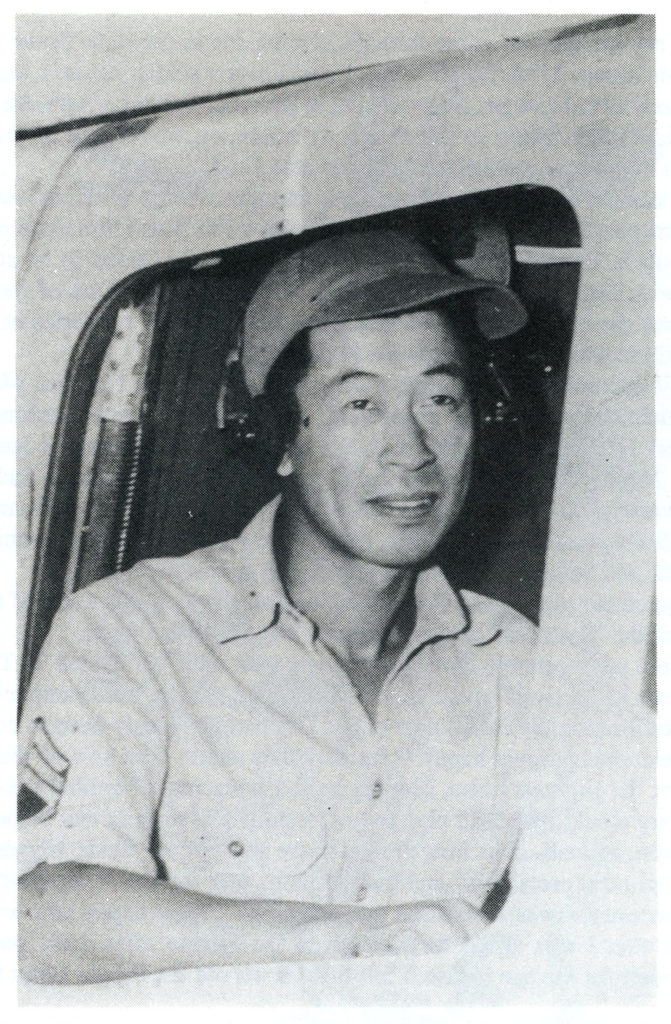
Here’s Ben Kuroki in Army Air Force photo +58171AC (A39047): JAPANESE “AMERICAN TAIL GUNNER OVER TOKYO – American born Japanese T/Sgt. Ben Kuroki, Hershey, Nebraska, a tail gunner with 30 ETO missions, is interviewed on Tinian after completing his 27th mission in the Pacific, by T/Sgt. Hal Brown, Bakersfield, Calif., combat photographer for Gen. H.H. Arnold’s official Army Air Forces weekly radio show, “The Fighting AAF”. Kuroki wears Distinguished Flying Cross and the Air medal with four Oak Leaf Clusters.”
Ben Kuroki, at Wikipedia
Ben Kuroki’s Family Tree
Ben Kuroki, at FindAGrave
American Air Museum in Britain
Ben Kuroki’s Bloot Chit, at National Museum of American History (Behring Center)
And, Chester Marshall’s book…
Marshall, Chester, The Global Twentieth – An Anthology of the 20th AF in WW II, Apollo Books, Winona, Mn., 1985
Here’s a snippet of what is (presumably?!) a much lengthier interview of Ben Kuroki, via the National Japanese American Historical Society.
________________________________________
Gene Roddenberry (Eugene Wesley Roddenberry)
“Television screenwriter, producer and creator of Star Trek: The Original Series, and its sequel spin-off series Star Trek: The Animated Series and Star Trek: The Next Generation.”
Gene Roddenberry, long before the advent of Star Trek, in his photographic portrait from NARA RG-18 PU. Note the white-ink label at the bottom of the photo with the abbreviation “(42-G) KF”. Though I think (?) that would imply graduation from Class 42-G at Kelly Field, Roddenberry actually graduated with Class 42-G at Goodfellow Field, San Angelo, Tx. …
… and, via Army Air Forces Collection, here’s the front cover of his class graduation book, CAVU, Class 42-G, Goodfellow Field, San Angelo, Tx. …
… where his portrait appears on page 69.
As described at Pacific Wrecks, Roddenberry served in the Southwest Pacific with 394th Bomb Squadron of the 5th Bomb Group, eventually retiring from the military with the rank of Captain.
On August 2, 1943 he piloted a B-17E Flying Fortress – 41-2463, “Yankee Doodle” – which crashed on takeoff from Guadalcanal or Espiritu Santo, with the loss of two crew members, Sgt. John P. Krueger and navigator 1 Lt. Talbert H. Wollam. The aircraft can be seen below in Army Air Photo Photo 22847AC (A45620). Caption follows:
“B-17E – “Yankee Doodle”
“Members of a heavy bombardment squadron in the South Pacific have a novel method of chalking up their victories. On the noses of their B-17s they paint Jap flags to indicate planes shot down. Some have downed as many as 15 zeros.
Miniature destroyers or cruisers or transports signify a ship of that class officially sunk. The torpedoes indicate the number of striking missions in which the plane has had a part. A striking mission in the combat area is an attack on a specific enemy target.
Standing under the nose of their Flying Fortress, these two men [names unknown] of the ground crew pause to pose for the Army photographer in the South Pacific. These men are extremely proud of their planes and their victories. Note the string of shells for the machine gun in the nose.”
“Rec’d 1/9/43 thru Director of Photography from South Pacific Theater. Copied 2/16/43.”
Gene Roddenberry, at Wikipedia
Gene Roddenberry, at FindAGrave
B-17E 41-2463 – 13th Air Force, 5th Bomb Group, 394th Bomb Squadron, (Lost August 2, 1943)
Talking About Gene Roddenberry, at Television Academy Foundation
Internet Speculative Fiction Database
________________________________________
Harvey Jackson Scandrett
“The sun glinted off the fuselages of the silvery Mustangs and from my vantage point, they seemed to stretch to the horizon to the front and sides of me. Between 350-400 miles north of Iwo we ran into a gigantic weather front with a solid squall line of cumulonimbus clouds blocking our path. These immense thunder-heads were too high for us to surmount. After we had circled for some time looking for holes without finding a trace of any, I heard Col. Scandrett say over the radio “Proceed with the mission; I take full responsibility.” At this my heart stopped and I know that I was not alone.”
“I realize now that Scandrett had to make a difficult decision without benefit of accurate weather information. He gambled and lost everything.” – Leonard A. Dietz, July 6, 1986
Enlisted in the United States Air Force in 1940, graduating from Randolph Field as a fighter pilot. By 1945, commander of the Headquarters Squadron (Deputy Group Commander) of the 506th Fighter Group. On June 1, 1945, commander of the three 7th Air Force Fighter Groups (15th, 21st, and 506th) assigned for B-29 Superfortress escort mission to Osaka, Japan. One of the 24 7th Air Force P-51 pilots lost that day.
One of the links below will take you to a PDF with the names of the 24 pilots lost on this mission, as well as the three other pilots who – having parachuted over the Pacific Ocean – were rescued. The list also includes aircraft serial numbers and MACR numbers for the aircraft flown by the 24 pilots who didn’t survive. The only similar incident that I’m aware of from the European Theater involved the loss of eleven P-51B Mustangs and pilots – no survivors – of the 363rd Fighter Group (five from the 381st Fighter Squadron, and six from the 382nd) over the English Channel on March 4, 1944, almost certainly caused by a combination of pilot inexperience and (very) bad weather.
Regarding 7th Air Force P-51 losses on the June 1, 1945, mission, unfortunately, aircraft nicknames and plane-in-squadron numbers are known for only a few of these P-51s (and this, it seems, only from private photographs!), for MACRs filed for 7th Air Force fighter losses did not record such information. To be specific, the “space” for aircraft nicknames in such MACRs doesn’t include the individual planes’ actual hand-painted-and-sometimes nose-arted nicknames, the simple and generic word “Mustang” appearing in that data field instead. (?!?)
Missing Air Crew Report 14653
Harvey J. Scandrett, at FindAGrave
Harvey J. Scandrett, at Pacific Wrecks
7th Air Force P-51D Pilot Losses – June 1, 1945
P-51D 44-72607, Madam Wham-Dam / 550 – 7th Air Force, 506th Fighter Group, 458th Fighter Squadron (Lost June 1, 1945), at Pacific Wrecks
506th Fighter Group – Iwo to Japan
506th Fighter Group – 1 June 1945 Black Friday
A book! (A good book, at that…)
Lambert, John W., The Long Campaign – The History of the 15th Fighter Group in World War II, Sunflower University Press, Manhattan, Ks., 1982 (see pages 121-126)
A magazine (…from years ago…)
Blake, Steve, “The 363rd Fighter Group in WW II – Part I”, Fighter Pilots in Aerial Combat, Summer, 1982, Number 5 (pp. 15-22)
]]>pilots
photographed
professionally –
– pictures
preserved
in perpetuity?
(Possibly. (Possibly.))
A particular aspect of this blog being historical photography, one of my first posts – Five Pilots in December: Photographic Portraits of American Fighter Pilots Who Lost Their Lives at Pearl Harbor – dating from November of 2016 (gadzooks, has it been that long?!) focused (* no pun intended *) on photographic portraits of Army Air Corps pursuit pilots Samuel W. Bishop, Hans C. Christiansen, John L. Dains, Gordon H. Sterling, Jr., and George A. Whiteman. The five images featured in that post are among the many, many such images in the collection Photographic Prints of Air Cadets and Officers, Air Crew, and Notables in the History of Aviation – NARA RG 18-PU, at the United States National Archives.
Though the overwhelming majority of these portraits and images in that collection directly pertain to members of the United States Army Air Service, the United States Army Air Corps, and its successor, the United States Army Air Forces, a few of these images are of personalities in aviation history who are either American civilians, or (even fewer in number) citizens of other countries, who had interaction with or relation to American aviation, or who were simply prominent in the field of aeronautics, per se. As such, “this” post displays images of the following aviators: First Lieutenant Paul F. Baer, Marshal Italo Balbo, Anthony Fokker, Major Ployer P. Hill, Ruth R. Nichols and Amelia Earhart, Philip A.G.D. Sassoon, and Lawrence B. Sperry. More such posts will follow.
Given the prominence of these individual in the field of aviation – let alone history in general for Fokker and Earhart – and the abundance of information about them, I’ve decided not to “reinvent the wheel” and write lengthy essays about them, recreating what’s been written previously. Rather, each image is simply followed by links to relevant sources of information. These references are primarily Wikipedia (yeah, I know, I know … it’s Wikipedia, but still, you can find valid information there) and FindAGrave, the latter site often featuring valuable genealogical information and photos. The photographs of Frank F. Baer and Ployer P. Hill are supplemented by images of newspaper articles, while the portraits of Balbo, Nichols, and Sassoon feature videos.
I hope you find these images interesting.
More to follow!
____________________________________
First Lieutenant Paul Frank Baer
“American World War I flying ace credited with nine confirmed victories and seven unconfirmed victory claims. He was the first ace flying for [specifically] American military aviation. He also scored the initial victory for an American military unit.”
____________________
Here’s a document about Paul Baer’s military training and service in the Service Aéronautique of the French Army during World War I. The document can be found at the Database of Military aircraft personnel for WW I, within the Database of navigators and ground personnel of the air force during the Great War, of the SGA (Secretary General for Administration), at – Mémoire des hommes – Portail Culturel du Ministere Des Armees. (“Memory of men – Cultural Portal of the Ministry of the Armed Forces”).
The Illustrated Daily News
September 27, 1919
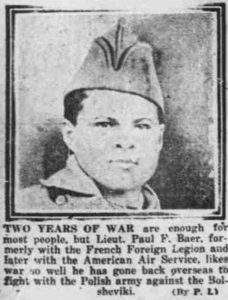
____________________
Body of Ft. Wayne War Ace Arrives Home From China
The Muncie Morning Star
December 31, 1930
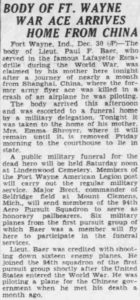
____________________
Bury World War Ace at Ft. Wayne Today
The Muncie Morning Star
January 3, 1931
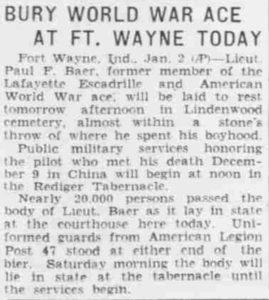
____________________
Last Rites for American Pilot This Afternoon
Following Services At Chapel Body Starts Journey to France
The China Press
December 11, 1930
Full military honors will be paid today at 3 p.m. to Pilot Paul F Baer, American aviator and a distinguished member of the famous Lafayette Esquadrille, who met his untimely death Tuesday morning when the Hankow plane of the China National Aviation Corporation crashed into the mast of a junk.
Shanghai military units will say their last goodbye to an honorary soldier in the form of guard of honor contingent of French troops, ordered out of the French commandant delegation from the Royal Air Force Association and the American Legion.
The body is now lying in state, draped with the flags of three nations, at the International Funeral Directors’ Establishment, 71 Kiaochow road.
High officials of foreign and native military forces will pay their last respects to the gallant aviator this afternoon. After the funeral the body will be taken aboard the President McKinley, which will convey Pilot Baer on the first leg of his journey to his last resting place.
LAST RESTING PLACE
The body will be taken to Fort Wayne, Ind., where friends and relatives will pay respects before it travels to Versailles near Paris. There the Lafayette Memorial will lay claim to Pilot Baer, wherein a permanent niche has been awaiting him since his release from the Lafayette Esquadrille. The Memorial has a tomb for every member of the Esquadrille, and only a few of these still remain unoccupied. One of the surviving members of the famous fighting group. Mr. Bert Hall, author of the book “One Man’s War,” is in Shanghai at present.
Baer, ranking No. 4 in the Esquadrille, was showered with all the honors the French Government could confer upon him. He was also decorated by the United States. The aviator possessed the Distinguished Service Cross, with Bronze Oak Leaf; Legion d’Honneur, and Croix de Guerre with seven Palms.
Pilot Baer, a daring and fearless fighter, was born in Fort Wayne, Indiana. He was commissioned First Lieutenant in United States Aviation, November 5, 1917, and was soaring over the roaring cannon at the front from February 18 to May 22, 1918, flying for the 103rd Pursuit Squadron. On May 22 he was shot down and wounded in combat, and from that time was held a prisoner in Germany until the Armistice was signed.
FLEW SPAD 80
Enlisting in the French Aviation Service February 20, 1917, Baer was in the French aviation schools until August 12 of that year, when he was given a Spad 80 and started his maneuvers at the front. He fought for the French until January 14, 1918, and during that time brought down nine enemy planes. Baer showed such daring and skill in all his combats that France conferred numerous honors upon him.
During his service in United States Aviation at the front, the D.S.C. was given him by command of General Pershing, for bravery in March, 1918.
Baer, alone attacked a group of seven enemy pursuit machines, destroying one which crashed to the ground near the French lines.
____________________
Impressive Tribute Paid Distinguished Airman In Military Rite Yesterday
United States Marines Present For Funeral Of Pilot Paul F. Baer, Victim Of Air Crash Here On Tuesday
The China Press
December 12, 1930
In a simple but impressive manner Shanghai yesterday paid a final tribute to the distinguished airman, Pilot Paul F. Baer, American aviator and ranking member of the famous Lafayette Esquadrille, who crashed to his death here Tuesday morning when the Hankow plane of the China National Aviation Company failed to gain altitude and was cracked up.
Funeral services for the ill-fated aviator, at the International Funeral Directors were attended by [company] of United States Marines as well as numerous French officials. The Rev. Emory Luccock was the minister in charge.
Following the playing of “Nearer My God to Thee,” by the military band. Rev. Luccock delivered a brief euology over the bier. Three volleys from the firing squad followed. “Lead Kindly Light” was the second and final rendition by the band.
FLYER BEARERS
Pall bearers were made up entirely of fellow airman including Mr. Bert Hall, one of the few surviving members of the famous French squadron. The others, all of the China National Aviation Company, are: M.S. Halin, H.G. Smith, M. Hamilton, James Hayden and M. Hamill. Captain Lawson was in command of the marine company.
Although little information is available here concerning Baer’s relatives, he is believed to be survived only by his mother, Mrs. Emma Shroyer of Fort Wayne, Indiana.
The casket was draped with an American flag on all sides by numerous floral wreaths. Indicating high regard on the part of his flying colleagues, many of these came from those who had soared through the clouds with Pilot Baer. Included among the large wreaths were those from the Pilots of the China National Aviation Company, the Mechanics of the C.N.A.C., the Royal Air Force of China, United Services Association of the Great War.
TO FRANCE
From the funeral parlor the body of Pilot Baer was removed late yesterday to be placed aboard the President McKinley, which will convey the airman on the first leg of his last journey. The body will be taken to Fort Wayne, Ind., where relatives and friends will pay respects before it is carried on to Versailles, France. There Pilot Baer will find his final resting place in the Lafayette Memorial, where a niche has been reserved for him as a result of his distinguished war service. The Memorial has a tomb for every member of the Esquadrille.
During and after hostilities in the Great War, Pilot Baer was showered with honors by both America and France. High decorations came from both governments including the Distinguished Service Cross, with Bronze Oak Leaf, the Legion of Honor and the Croix de Guerre, with seven palms. He ranked No. 4 in the Lafayette Esquadrille.
Following his services with the French, Pilot Baer fought with the American air forces on the Western Front. He was awarded the D.S.C. by command of General Pershing, for bravery in March, 1918. He attacked a group of enemy planes while flying alone over the French lines. Fire from his guns brought down one of the German planes. On March 15, bare attacked two enemy planes, sending one of the pair to the ground in flames.
FROM FT. WAYNE
Baer was born in Fort Wayne, Indiana. He was commissioned First Lieutenant in the U.S. Air Force, November 5, 1917, and by the following February he was in the thick of the fighting in France as a member of the 103rd Pursuit Squadron. On May 22, 1918 he was shot down and wounded during combat. From that time on until the Armistice was signed in November, he was a prisoner in Germany.
In addition to the wreaths from the close association of Pilot Baer were a large number bearing the names of prominent institutions and individuals. The complete list of wreaths which decked the casket follows: China National Aviation Company, Anciens Combattants Francais, United Services Association of the Great War (1914-1918), Royal Air Force Association of Shanghai, Association Nazionale Combattenti, Les Aviateurs Francaise de Shanghai, American Legion, Shanghai, General Frederick Townsend Ward Post No. 1, Pilots of the C.N.A.C., Mechanics of the C.N.A.C., Nan and Blanche, Officers and men of the 4th U.S. Marines, American Foreign Insurance Association, Standard Oil Company of New York, Amicale des Anciens Combattants Francaise, Douglas Jenkins, Mrs. Douglas Jenkins, H.B. Longfelloy, the S.E. Gale Company, The Staff of the Young Men’s Christian Association, Louis Ladow, Mr. and Mrs. E. Tollefsen, George Sellett, Mr. and Mrs. W.W. Ritchie, Alfred Pandely Patterson and numerous Chinese friends.
____________________
Paul F. Baer, at Wikipedia
Paul F. Baer, at FindAGrave
China National Aviation Corporation
Book: Hoosier Aviator Paul Baer: America’s First Combat Ace, by Tony Garel-Frantzen
________________________________________
Italy: Maresciallo dell’Aria (Marshal of the Air Force) Italo Balbo
“Italian fascist politician and Blackshirts’ leader who served as Italy’s Marshal of the Air Force, Governor-General of Libya and Commander-in-Chief of Italian North Africa. Described as the “heir apparent” to Italian dictator Benito Mussolini, often seen as one of his most probable successors.”
Note Marshall Balbo’s signature and salutation at bottom left.
Italo Balbo, at Wikipedia
Italo Balbo, at FindAGrave
Newspaper Clippings about Italo Balbo, in 20th Century Press Archives of the ZBW
Italian Air Armada Stirs New York Aka Balbo Arrives In New York (1933), at British Pathé YouYube Channel
________________________________________
The Netherlands: Anthony Gerard Fokker
“Dutch aviation pioneer, aviation entrepreneur, aircraft designer, and aircraft manufacturer. Most famous for the fighter aircraft he produced in Germany during the First World War such as the Eindecker monoplanes, the Dr.1 triplane and the D.VII biplane.”
Note that both of these images bear Anthony Fokker’s signature.
(Image 18-PU-137-1)
“Anthony G. Fokker in one of his airplanes about 1911-1912.” (Image 18-PU-137-2)
Anthony G. Fokker, at Wikipedia
Anthony G. Fokker, at FindAGrave
The National Aviation Hall of Fame
Newspaper Clippings about Anthony G. Fokker, in 20th Century Press Archives of the ZBW
At Oogle Books:
“Tony Fokker Wizard Of Flight“, Popular Science, May 1931
“Tony Fokker And The World War“, Popular Science, June 1931
“Tony Fokker Captures America“, Popular Science, July 1931
________________________________________
Major Ployer Peter Hill
“Pilot and an officer with a varied career, best known for his abilities as a test pilot. In an aviation career that spanned eighteen years, Hill piloted nearly 60 of the Army Air Corps’ newest aircraft, testing and evaluating their capabilities for service.”
____________________
Army Assignments
The Washington Post
May 29, 1925
____________________
Big Bomber Falls in Ohio, Killing 1
Major P.P. Hill Dies As the Boeing ‘Fortress’ Crashes at 200 Feet in Tests
The New York Times
October 31, 1935
____________________
Bomber’s Crash Laid to Locked Controls
Albuquerque Journal
November 13, 1935
____________________
Boeing Test Chief Dies Of His Injuries
Leslie Tower Was in Crash of Army Bomber on Experimental Flight at Dayton Oct. 30
The New York Times
November 20, 1935
Leslie Ralph Tower, at FindAGrave
Ployer P. Hill, at Wikipedia
Ployer P. Hill, at FindAGrave
Model 299 (NX13372) Crash, at National Museum of the United States Air Force
Model 299 (NX13372) Crash, at Aviation Safety.net
________________________________________
Ruth Rowland Nichols (and Amelia Mary Earhart)
“American aviation pioneer. The only woman yet to hold simultaneous world records for speed, altitude, and distance for a female pilot.”
“Miss Amelia Earhart Putnam and Miss Ruth Nichols. Taken at National Air Races – Los Angeles, Cal. July, 1933.” (Image 18-P-228, 267)
Ruth R. Nichols, at Wikipedia
Ruth R. Nichols, at FindAGrave
Ruth NIchols Home Movies 1935 – Women Pilots Ruth Elder Aviatrixes 70390 HD, at Periscope Film
Ruth Nichols reaches Valley Stream from Los Angeles in 13 hours and 22 minutes, at Critical Past
____________________
Amelia Mary Earhart
Amelia Earhart, at Wikipedia
This image of Amelia Earhart (28987AC) is dated July 30, 1936. The serial number of the Boeing P-12C behind Amelia, painted on the aircraft’s propeller blade, is 31-156. According to Aviation Archeology, this aircraft was assigned to first the 95th, and then the 43rd, Pursuit Squadrons, in which it was involved in landing accidents on December 24, 1930, and November 26, 1935, the pilots having been Carl B. Fry and Jerome E. Blair, Jr. (eventually Colonel Jerome Edward Blair, Jr.), respectively. The aircraft in the background is probably a Consolidated PB-2. (Image 18-P-228266)
________________________________________
England: Philip A.G.D. (Albert Gustave David) Sassoon
“Sir Philip Albert Gustave David Sassoon, 3rd Baronet, GBE, CMG (4 December 1888 – 3 June 1939). British politician, art collector, and social host, entertaining many celebrity guests at his homes, Port Lympne Mansion, Kent, and Trent Park, Hertfordshire, England. Secretary of State for Air, Sassoon was Honorary Air Commodore of No. 601 (County of London) Squadron. “
Philip A.G.D Sassoon, at Wikipedia
Philip A.G.D. Sassoon, at FindAGrave
Sir Philip Sassoon (1925), at British Pathé YouYube Channel
________________________________________
Lawrence Burst Sperry
“Third son of the gyrocompass co-inventor, Elmer Ambrose Sperry and his wife Zula. Sperry invented the first autopilot, which he demonstrated with startling success in France in 1914. Sperry is also credited with developing the artificial horizon still used on most aircraft in the early 21st century.” (Image 5913 AS)
Lawrence B. Sperry, at Wikipedia
Lawrence B. Sperry, at FindAGrave
Lawrence Sperry: Genius on Autopilot, at History.net
]]>Recently, I received the following communication from aviation historian Brian Lindner:
Your story on Lt. J.C. Wood’s crew and their fate is truly excellent. I have been researching their story at NARA and other sources and found your article completely accurate.
I am writing a book that will center around the fates of the crewmen from about 25 famous aviation photos at NARA. My hope is to complete the research phase in late 2020 or early 2021.
Would it be possible to obtain permission to quote from your article? If yes, how should it be credited?
Thank you in advance for your consideration.
PS: The link to the photo showing Hodge and Platt doesn’t work.
I want to thank Brian for his very nice compliments about my post(s).
By all means, they certainly can be quoted from!
As far as crediting my work goes, hmmm, that’s a good question…
…perhaps the bibliographical reference should be in the format:
“Far Away, So Close: The Fall of a B-24 Liberator Off the Coast of Italy” (Parts I, II, and III), at ThePastPresented.com, December 29, 2016, accessed on such-and-such-calendar-dates(s)
(Thanks for the tip about the hyperlink: It’s repaired!)
On a related note, Brian has a story – Unwraveling the Mystery of the ‘Little Warrior’ – at the July, 2009 issue of Wicked.local, concerning Lt. Sidney Benson, a co-pilot in the 862nd Bomb Squadron, 493rd Bomb Group, 8th Air Force. Lt. Benson’s plane, B-24H Liberator 42-94812 (“Little Warrior” – “8M * X”), piloted by 2 Lt. John H. Hansen, was shot down by flak on June 29, 1944. The plane’s loss is covered in MACR 6721 and German Luftgaukommando Report KU 2389.
Brian’s article is based on an official Army Air Force photo which I’m sure is very well known to those familiar with WW II aviation history, and just as much – WW II history – “in general”, for the photo has appeared in books and magazines over the past several decades. For a time in the 1990s (?) the image (sans any explanatory information) was even used as a header illustration for advertisements for some sort of military book club, which appeared in the magazine section of some Sunday newspapers.
Akin to the image of Marty the Rubble Maker, I similarly first saw this photo in Steve Birdsall’s Log of the Liberators. In 2012, I was able to scan (at 600 dpi) the official USAAF photo (53708AC) at the National Archives. The picture is shown below.
The perspective of the image is deceptive, for the USAAF photographic print is actually a cropped view from the original image, the latter revealing that the bomber is actually making an abrupt bank to the right rather than being in level flight. A clue: The dark object in the upper left is actually the leading edge of the port fin of the B-24 from which the photo was taken.
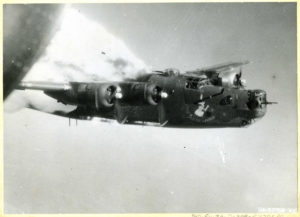 Of greater importance than the plane is her crew.
Of greater importance than the plane is her crew.
None returned.
So, here are the men of the “Little Warrior”…
2 Lt. Jerome Levy, 0-703639, Navigator, Camden, N.J.
2 Lt. Sidney A. Benson, 0-818558, Co-Pilot, Marblehead, Ma.
2 Lt. John W. Hansen, 0-693976, Pilot, New York, N.Y.
2 Lt. Malcolm M. Stich, 0-697746, Bombardier, Brooklyn, N.Y.
T/Sgt. Vernon J. Polzin, 38367667, Flight Engineer, Taylor, Tx.
Front, L-R:
S/Sgt. Cyrus R. Aidala, 32707915, Ball Turret Gunner, Brooklyn, N.Y.
“Sandy Saunders, Top Turret Gunner”
(Same as S/Sgt. John E. Sanders?, 18191467, “Flexible Gunner”, Goose Creek, Tx.?)
S/Sgt. Walter A. Boykowski, 13171280, Tail Gunner, Pittock, Pa.
“Sgt. Ramos, Radio Operator” (not in crew during mission of June 29)
S/Sgt. Sylvanus G. Haksell, 39297646, Nose Gunner, El Centro, Ca.
Not in photograph:
S/Sgt. Billy B. Gomillion, 38424702, Radio Operator, Wichita Falls, Tx.
From my reading of the MACR, I realized that Lt. Benson escaped from the plane (how?) but didn’t survive. I always had my “suspicions” but didn’t know – until reading Brian’s Wicked Local story – what actually happened to him after he safely parachuted to earth.
Alas, the story is sad; appalling; infuriating.
Yet, well told: Brian has done fine research, and relates the tale in a compelling manner. You can also read about his research at the Boston Globe.
His forthcoming book should be interesting…!
The outcome of the mission was reported as follows:
Our pilots and crews took off again to slap the little Jap off the map. Nine B-25Gs took off at 0713L to blast out barges, possible large hideouts and buildings from Alexishafen south of Bogadjim, New Guinea. Fighter cover was effected over Nadzab at an altitude of 3500 feet. The fighter escort consisted of P-47s. The flights were of three planes each and were led by the flights of the 822nd Squadron. 28 x 500 lb. 4-5 second delay demolition bombs were dropped in specific targets. Many of the bombs scored direct hits on barges along the coast. 1 bomb dropped safe due to rack failure and 3 bombs were returned to base due to mechanical failure. 82 rounds of 75mm were fired on runs with a number scoring hits and the remainder with no visible results. Villages and hideouts were thoroughly strafed with 6100 x .50 calibre and 1300 x .30 calibre ammunition. Photos were taken of the strike.
Next followed remarks covering events experienced by specific aircraft and crews, focusing on battle damage, and, the loss of B-25G 42-64850:
The ack-ack encountered was moderate inaccurate and heavy coming from Madang, Alexishafen and Erimhafen Plantation. Plane no. 769, piloted by Remshaw, received a hole in the bomb bay door from fragment of 20mm. Plane No. 874, piloted by Shulich, received large hole in left vertical stabilizer from undetermined type of shell. Plane No. 850, the crew of which were Smith F/O pilot, Newland O.T. co-pilot, Chapin R.D. navigator, Anagos T. radio man, Boykin J.R. gunner crashed in water between Bili Bili Island and mainland. Cause unknown but thought due to loss of power due to damage from ack-ack. All five crew members last seen in life raft, apparently uninjured, rowing toward Bili Bili Island.
Throughout the attack no interception was encountered. The remaining eight planes landed at Durand at 1135/L.
The next day – November 4 – no combat missions were flown by the 823rd Bomb Squadron. This brief pause in operations gave the squadron historian time to ponder the fate of the missing crew, his brief notes encompassing the hope for their rescue against their more likely fate as captives of the Japanese. Specifically:
All crew members express deep sorrow for the five crew members who were last seen in a life raft heading toward Bili Bili Island. What will become of them no one knows. Let’s hope that they are safe.
Alas, they were not safe.
They would never return.
Today, the five crew members of B-25G #850 – Smith, Newland, Chapin, Anagos, and Boykin – remain among the over 73,000 American servicemen still missing from the Second World War. Barring a fortuitous archival or archeological discovery, they will probably ever remain as such: “Missing in Action”.
But, the historical record of this crew’s loss is singularly different from the overwhelming majority of accounts of Allied World War Two aviators lost in either the Pacific or European Theaters of War. This is because the Missing Air Crew Report covering the crew’s loss – MACR 1087, to be specific – includes a photograph of the crew (albeit, as viewed from a distance) as last seen by fellow members of the 823rd Bomb Squadron en route back to the 38th Bomb Group’s base at Port Moresby.
The photograph was first discovered as I was reviewing MACRs via Fold3.com, which database / website many readers of this post are probably well familiar. The Fold3 version of this image is shown below:
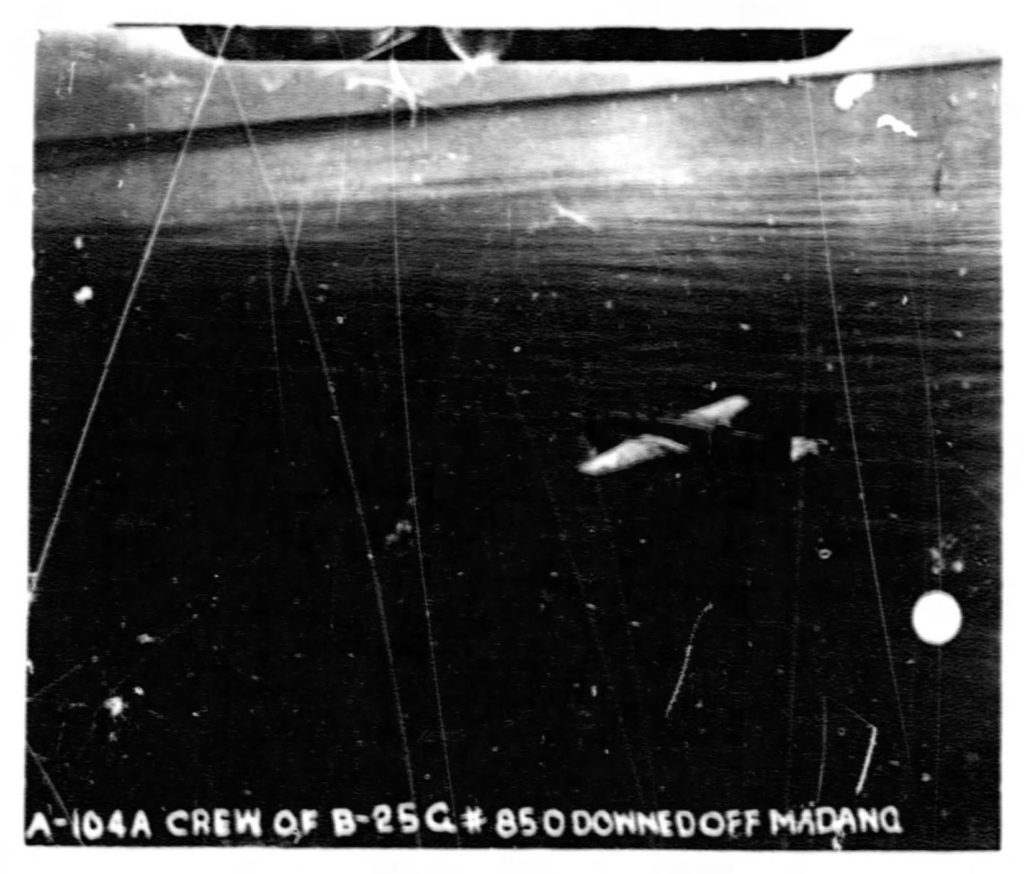
In August of 2014, I had the rare opportunity, during a visit to the National Archives in College Park, of viewing and digitizing the original (?) “physical” (!) MACR and the included photograph (see “The Missing Photos”).
So, here is the above image, as copied via an EpsonPerfection V600 scanner.
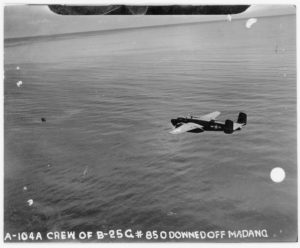
______________________________
The “first” page of MACR 1087, covering the loss of B-25G 42-64850, a 75mm cannon-equipped ship – is shown below:
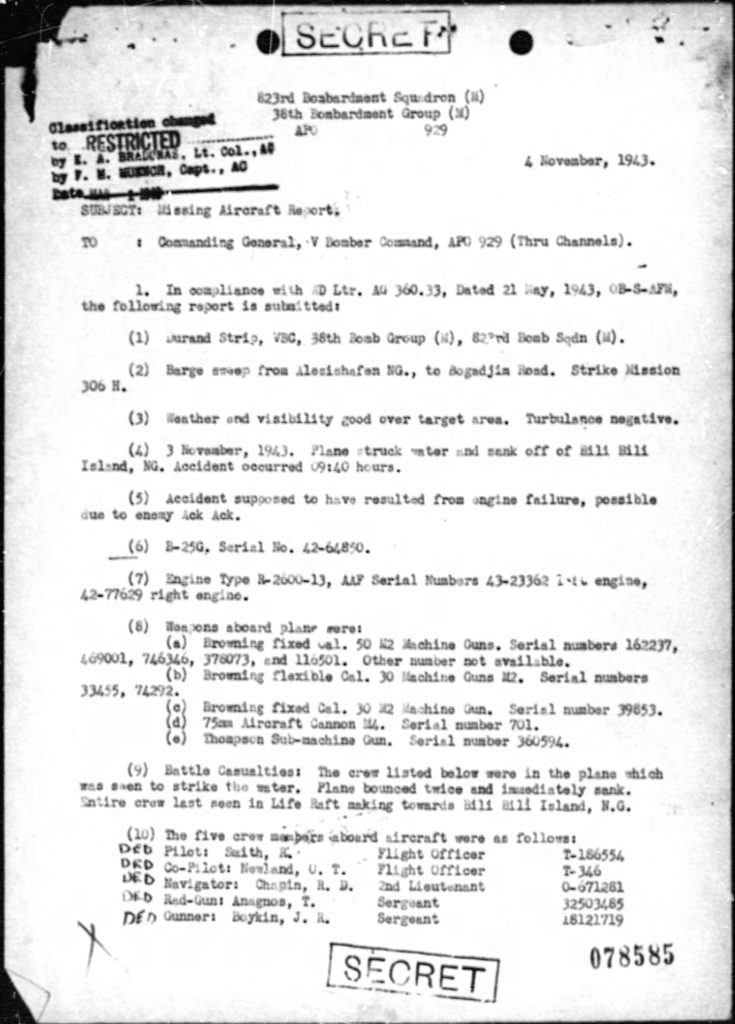 The following comments were recorded by the 823rd Bomb Squadron’s Statistical Officer, 2 Lt. Homer L. Cotham, and appear on the “second” page of the MACR:
The following comments were recorded by the 823rd Bomb Squadron’s Statistical Officer, 2 Lt. Homer L. Cotham, and appear on the “second” page of the MACR:
(12) Plane, while flying formation at low altitude over target, suddenly lost altitude striking water. The plane bounced twice, then sank immediately. Entire crew seen in Life Raft making for island in near vicinity of accident.
(13) Plane crashed in water four miles south of Madang, three-quarters of a mile off shore, in near vicinity of Bili Bili Island, N.G.
(15) Extent of search: Catalina flying boat attempted to reach vicinity of accident or crash the night of October [sic] third. This attempt was incomplete due to weather.
The plane’s loss was described by Squadron Operations Officer Capt. William Brandon, who stated:
While flying on Mission number 306 H, Alexishafen to Bogadjim Road Barge Sweep, I was leading flight number one. Flight Officer Smith was flying number three left wing position at the time that I took my flight in over the target. When next I looked to check the planes in my formation I saw Flight Officer Smith’s plane in the water.
Circling the plane as it sank I dropped a life-raft. This life-raft sank but the crew of the sunken plane were able to safely board the raft from their own plane.
When last sighted all members of the crew were observed aboard life-raft making towards the vicinity of Bili Bili Island, N.G., course undetermined.
______________________________
Unlike MACRs which specify the last-known latitude and longitude of a missing aircraft, the location of B-25G #850’s loss is simply given in words: “Off Bili Bili Island.”
To give you a frame of reference of the location of Bili Bili Island, here are two Google Maps – each having Google Maps’ red location pointer centered upon Bili Bili Island – showing the location of that tiny geographic feature.
This first map shows New Guinea and northern Australia, with – moving west to east – the Arafura Sea, Gulf of Carpentaria, and Coral Sea between the two land masses. Bili Bili Island is located approximately 360 miles west-southwest of Rabaul, just off the eastern coast of New Guinea, and south of Madang.
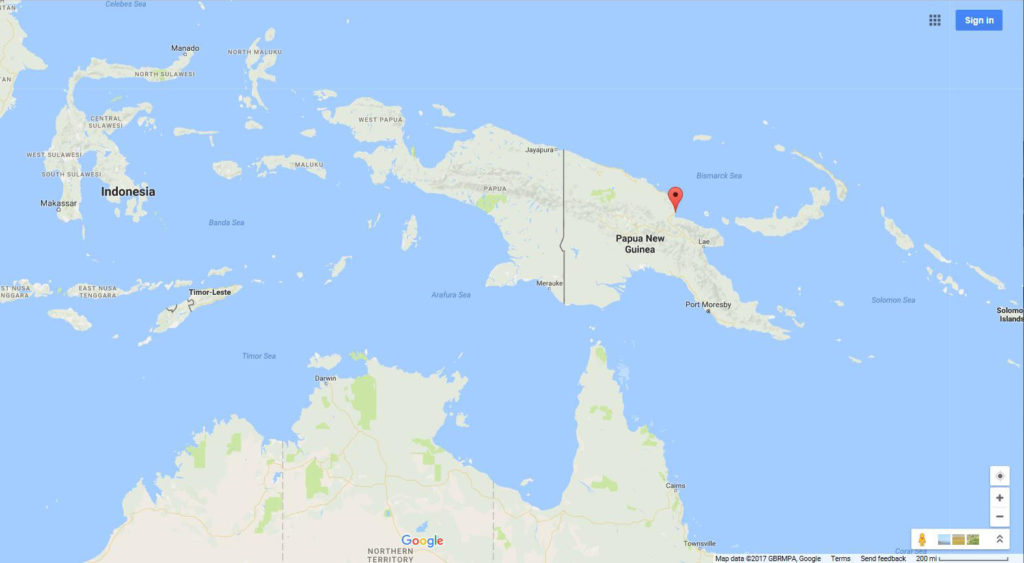 ______________________________
______________________________
In this second map, Bili Bili Island is not visible, but locations mentioned in the MACR – Alexishafen and Madang – are. These towns lie along the western shore of Astrolabe Bay, which body of water remains unlabeled.
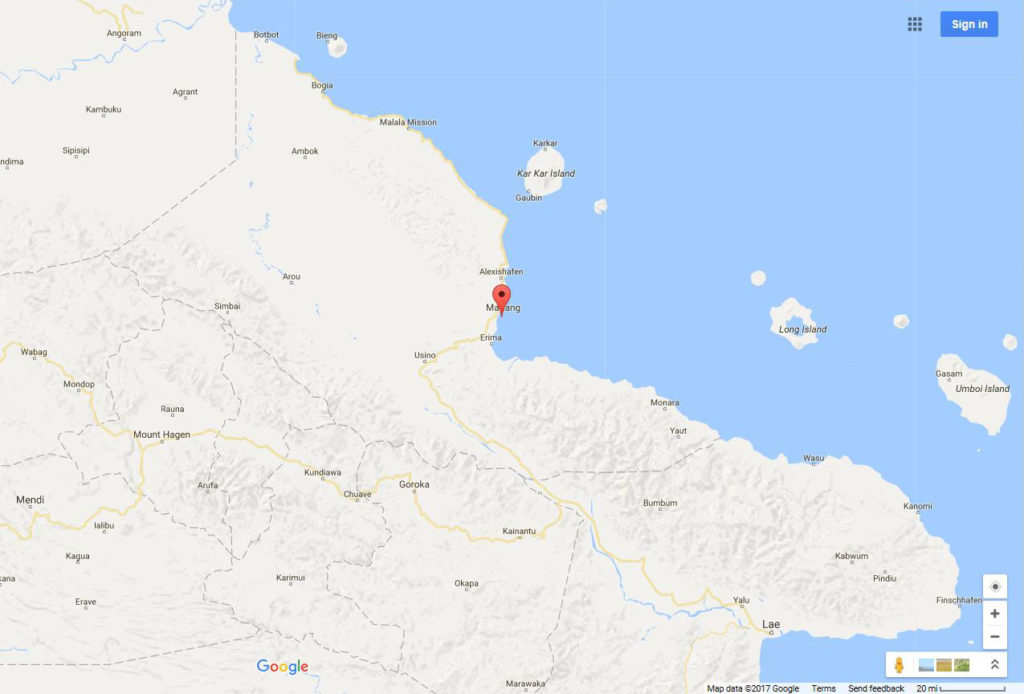 ______________________________
______________________________
Moving from the pixels of 2017 to the paper of 1943, MACR 1087 includes C.I.U. (Central Interpretation Unit) Map No. 36 of the Alexishafen area. The location of the B-25’s loss, about half-way between Bili Bli Island and the New Guinea coast, is denoted by an “X” within a small circle.
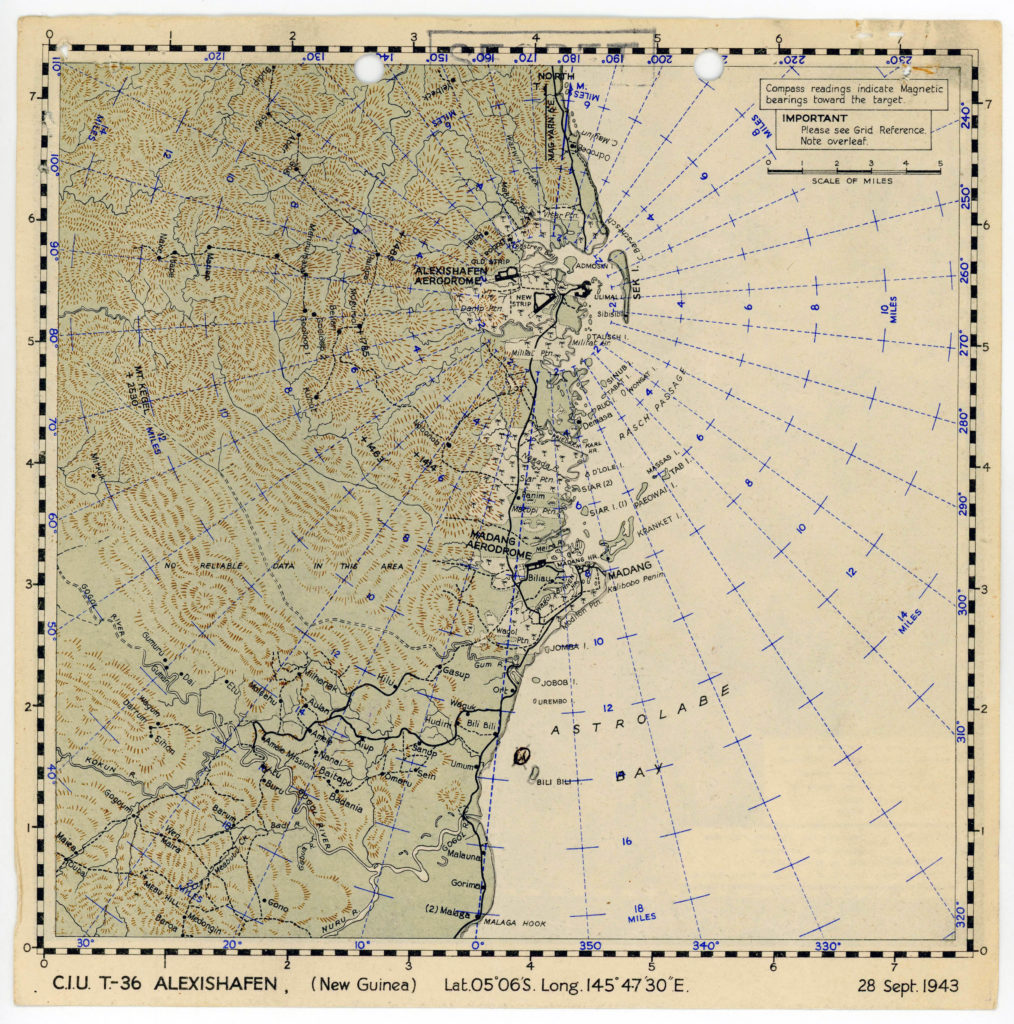 (By way of comparison, here’s the map as it appears at Fold3.com.)
(By way of comparison, here’s the map as it appears at Fold3.com.)
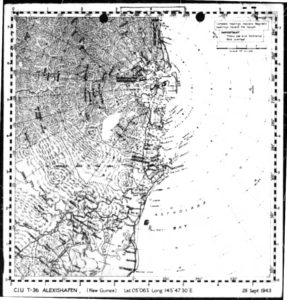 ______________________________
______________________________
At a slightly larger scale than the C.I.U. map is the Google map below. This closer view reveals that Bili Bili Island is approximately 3 miles south of the southern limits of Madang, and about 1.3 miles east of the New Guinea mainland. Oddly, Google Maps leaves the island un-named, with the designation “Bil-Bil” superimposed on the opposite shoreline. Is there a village by that name at this location?
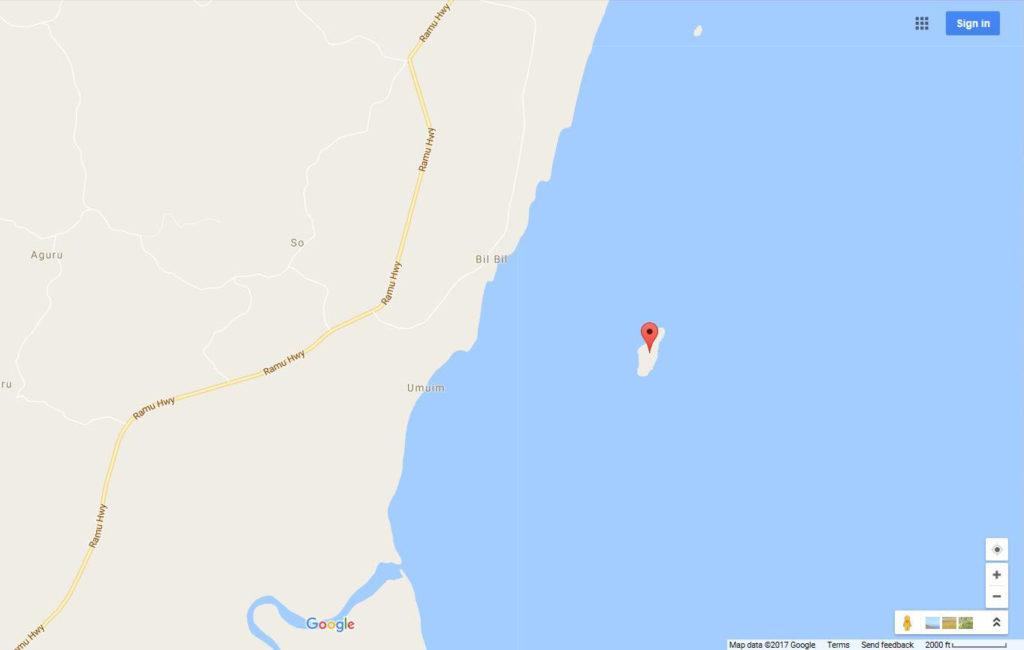 ______________________________
______________________________
Finally, at the same scale as the preceding map, we come to a Google Earth view of Bili Bili Island and Astrolabe Bay.
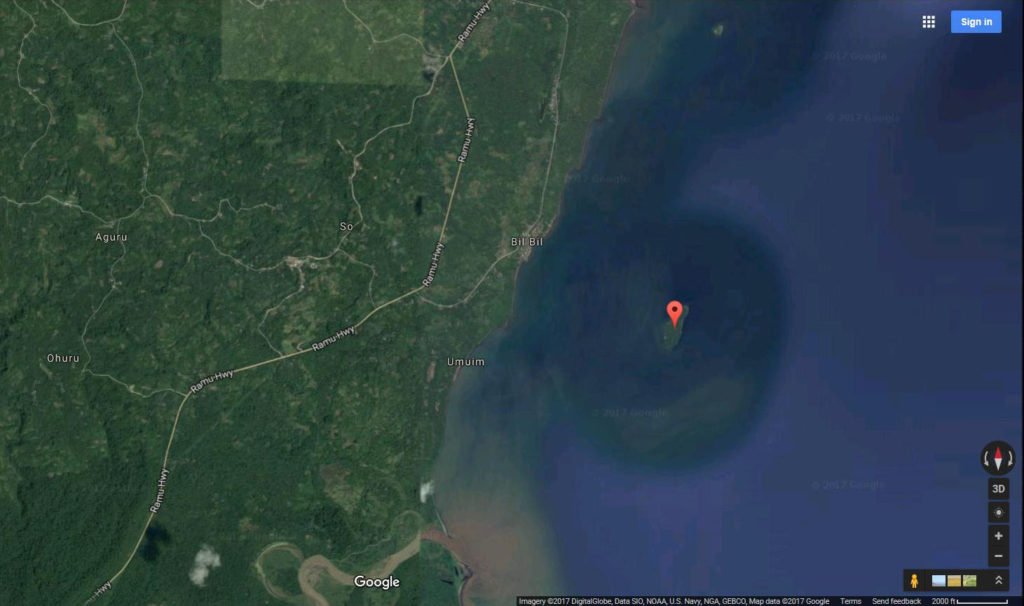 ______________________________
______________________________
Pacific Wrecks clearly describes the loss of un-nicknamed B-25G 42-64850, surmising that the men were captured and died in captivity, while the Pacific Wrecks essay concerning the fate of allied POWs at Amron, New Guinea (Death at Amron – by Undersea Explorer / Documentary Film-Maker Walter Deas) suggests that the Smith crew may have murdered at that Japanese base, a “hilltop high-ground 16 kilometers north of Madang,” which served as a Japanese Army headquarters and Kempeitai facility.
Pacific Wrecks’ history of the Japanese Army base at Amron, which served as a lookout point and headquarters for the 18th Army and Kempeitai, lists the names of eleven Allied airmen (nine Americans and two Australians) who were confirmed to have been murdered at that location, and, five others who probably suffered the same fate, all between June, 1943 and April, 1944.
However, the members of the Smith crew are not listed among the sixteen.
______________________________
The Capture of the Smith Crew
The Smith crew were definitely captured. This information comes from three sources.
In reverse chronological order, these comprise the 2011 book Sun Setters of the Southwest Pacific Area – From Australia to Japan: An Illustrated History of the 38th Bombardment Group (m), 5th Air Force, World War II – 1941-1946, As Told and Photographed by the Men Who Were There (by Lawrence J. Hickey, Mark M. Janko, Stuart W. Goldberg, and Osamu Tagaya); 1944 newspaper articles in (unidentified) Buffalo area newspapers, and most strikingly, transcripts of English-language Japanese propaganda broadcasts to the western United States covering the mens’ capture
In 2011
As described in Sunsetters: “Capt. Bill Brandon led the 823rd Squadron, and when his flight of three planes reached Bili Bili, roughly halfway between Alexishafen and Bogadjim, he and his wingmen dropped their bombs between the area’s plantation and Bili Bili Island, just off the coast. As his bomb bay doors were closing, Capt. Brandon looked out his window and was shocked to see that Flight Officer Richard Smith’s plane was in the water.
Brandon circled back and dropped a life raft to the downed crew. Smith’s plane sunk immediately after hitting the water, but he and his crew escaped and climbed into the raft. The men were last seen rowing toward Bili Bili Island, where they were captured and interrogated by the Kempei Tai, the Japanese Military Secret Police. Major Nakamoto, the 18th Army Staff Intelligence Officer, led the interrogation, which lasted roughly a week. Afterward they were taken a mile southwest to a POW compound, then transported to Wewak. They were never heard from again.” (Unfortunately, there no bibliographic reference for the source of this information.)
Pacific Wrecks history of the Wewak POW Camp (Kreer POW Camp) lists the names of three airmen (members of Captain William L. “Kizzy” Kizzire’s crew, about whom see more below) who were confirmed as having been POWs there. Neither they, nor any other Allied POWs presumed to have been held captive at that location – the Smith crew among them? – survived the war.
Late 1943 and early 1944
News items concerning F/O Smith from The Buffalo Evening News.
The first news item simply mentions Smith’s “Missing in Action” status.
Flight Officer Richard Smith
Overseas since last March, Flt. O. Smith has been stationed in New Guinea and had been piloting a bomber. His last letter to his mother was written Nov. 3, the day on which he was reported missing while on a mission over New Britain. Graduated from District School 3, West Seneca, and West Seneca High School, he was a carrier for The Buffalo Evening News before entering the employ of the Bethlehem Steel Company. He enlisted in the Air Forces June 28, 1941.
News about F/O Smith’s capture was published in February or March of 1944, in the context of news about the death of his cousin and fellow Buffalo resident, Army Private Floyd C. Smith.
WAR-SERVICE FLAG HONORING 4 SMITHS NOW HAS GOLD STAR
Patrolman Wayne Smith, a grizzled veteran of 20 years’ service as a West Seneca policeman, went about the sad task of replacing one of the four blue stars in the family’s service flag with a gold star today. He has just been notified by the War Department that his son, Pvt. Floyd C. Smith, 19, who had been previously reported missing in action in Italy, now is known definitely to have been killed.
What makes the news even more tragic for the smith family is that over on the other side of the world Flight Officer Richard Smith, 23, a nephew of Patrolman Smith, is a prisoner of the Japs. Richard is the son of Albert Smith, an electrician, of 17 Klass Ave., West Seneca, and was taken prisoner last Nov. 3, when a twin-engine bomber he was flying was forced down on a flight from New Guinea to New Britain.
Two other members of the Smith family are in the nation’s service. One is Pvt. Wayne Smith Jr., 21, a brother of Floyd, who has been unheard of in recent weeks and is believed to be overseas, and the other is Seaman First Class Milton D. Smith, 38, an uncle of Floyd and Richard, who is now at sea. Milton’s home address is 80 Hayden St., Buffalo.
“I guess the war is proving kind of hard on the Smiths,” commented Patrolman Smith in his home at 25 Harlem Rd., West Seneca. “But I guess the same thing is happening to the Smiths all over the country. I wish I were a little younger I’d go in and take Floyd’s place. The last word we received from Floyd was about seven weeks ago when he wrote that ‘everything is swell’. Shortly after that he was reported missing. But we didn’t give up hope until the second telegram came.”
Floyd was inducted in the Army in April 1943 after he had been working at the Curtiss-Wright Corporation airport plant for about five months. He was a native of West Seneca and was in his third year at West Seneca High School when he left school for war work. Assigned to an infantry unit, he had been in North Africa before going to Italy.
News of his death has been kept from his grandmother, Mrs. Fannie Smith, who is ill and also lives at 25 Harlem Rd., West Seneca. (1)
A particular sentence in the article stands out: “Richard … was taken prisoner last Nov. 3, when a twin-engine bomber he was flying was forced down on a flight from New Guinea to New Britain.”
How was this known by early 1944?
Probably through English-language radio broadcasts transmitted from Tokyo, and beamed to the Western United States and Latin America, from…
November of 1943 through April of 1944.
Entitled “Message From the Front”, these broadcasts pertained to American aviators – members of the Marine Corps and Army Air Force – who had been captured in the Southwest Pacific between early 1943 and early 1944.
Transcripts of these broadcasts are among records in the National Archives and Records Administration’s “Records of the Foreign Broadcast Intelligence Service.”
The “Message From the Front” broadcasts were transmitted at 0330 hours, albeit transcripts of the programs don’t specify if “3:30 hours” means Greenwich Mean Time, the Western time zone of the United States, or, Tokyo Time. The transcripts are headed by a surname, presumably that of the person who monitored and transcribed the program as it was received and monitored, in “real time”. These people were Berman, Bernstein, Hanson, Keller, Litwin, Roth, Sachter, Searl, and Teel.
Though varying greatly in content and length, the broadcasts follow a generally similar “script,” albeit with substantial variation. They generally commence with an introduction covering political or social effects of the war on American Society, as a whole. Sometimes, emphasis is placed on the contrast between the hardships endured by American soldiers and civilians, in contrast with the attitude – as it were – of American military and political leaders.
Then, the broadcasts focus upon the POWs themselves.
In all cases, the bulk of the broadcast is devoted to a presentation of detailed – quite detailed; very detailed – biographical information about the Prisoner of War, and may cover such topics as the circumstance under which he was shot down and captured, the type of aircraft he was flying, and his biography, the latter including his education and civilian vocation. In virtually every case the broadcast concludes with a recitation of highly personal, information about his next of kin, comprising names and addresses of family members – whether wives, parents, or siblings – the material, financial, or emotional challenges they’re contending with, and, other facets of their lives.
In some cases – disquieting to read; still disquieting to contemplate, even decades later – special focus is accorded to the physical, psychological, and emotional reaction of the POW to captivity, sometimes including quotations of statements allegedly made by the POW to his captors.
It’s conjecture on my part, but I suppose that the information in the “Message From the Front” broadcasts was extracted from transcripts of interrogation sessions endured by the POWs, then provided to officials in the Japanese media responsible for disseminating propaganda. The original text was edited to varying degrees for maximum dramatic effect.
In that sense, a consistent and unsurprising facet of the broadcasts is the complete absence of information about American military technology or tactics. Unsurprising, in that the purpose of the broadcasts was probably psychological warfare: To influence public opinion and therefore contribute to a sense of demoralization. If this was so, this rested on an extremely naive understanding of the nature of American society. (At least, as it existed eight decades ago. But, that’s another subject.)
In terms of the Smith crew, “Message From the Front” broadcasts pertain to Sgt. Boykin (February 9, 1944), Sgt. Anagos (February 16, 1944), Lt. Chapin (March 8, 1944), and F/O Smith (on March 29, 1944). There is no record of a broadcast concerning F/O Newland.
For the purpose of this post, two transcripts will suffice.
Here is the broadcast covering Sergeant Anagos, transmitted on February 16, 1944, as transcribed by “Roth” and “Teel”:
A MESSAGE FROM THE FRONT
Your subject for today is the Boeing bomber that flew on without a pilot. Hello listeners, this time Radio Tokyo presents an eye-witness report from a member of the Japanese army press participating at a certain front in the New Guinea sector. Yes, it is a very strange story. It is worth coming under the category of believe it or not. It is an unusual story for the outsiders but it is [stunning] news for no other person than Mrs. Phyllis Anagnos, whose address is eight-four-one-seven North Military Avenue, Detroit, Michigan. Should it happen that Mrs. Anagnos is listening to this broadcast, radio Tokyo advises here to keep up [word]. It is so far from being good news, but a very depressing [two words] can be seen. Well, she may feel easy that her husband Sergeant Theodore Anagnos is no by means dead. Instead of ending his life, he has been taken prisoner by the Japanese forces, [and being a prisoner] of war, he cannot return to his beloved wife so long as America does not make unconditional surrender to Japan. If Mrs. Anagnos wishes to see her husband, she had better write a letter to Mrs. Eleanor Roosevelt asking for help. No doubt the sympathetic Mrs. Roosevelt might take it that she might be under the circumstances with the wife of [few words]. Mrs. Roosevelt [three words] cell every day at the White House wailing bitterly before President Roosevelt and insisting upon the release of Theodore Anagnos. Well, wait a moment, Mrs. Theodore Anagnos is yet happy because her husband is enjoying good health at a prisoner’s camp of the Japanese Army. One day he told a member of the Japanese Army [press], that he saw at a certain American movie show [three words] featuring Clark Gable. He said Gable was [wonderful]. He went on to say I have a wife but to tell you the truth, I have [few words] how marvelous it would be if I could see [several words]. It is as if I am playing the very same role as Gable was in this film. Sergeant Anagnos [few words]. Mrs. Anagnos can depend upon it that her husband is quite [jovial]. Radio Tokyo is not responsible for his relationship with [two words]. That is a matter for Mrs. Anagnos to conduct a cross examination of her husband in person, in the event he should come back to America.
[Remainder of commentary unintelligible.]
Here’s the broadcast covering Flight Officer Smith, transmitted on March 29, 1944, as transcribed by “Hanson”:
MESSAGE FROM THE FRONT
Once again we bring you information of the officers and men [seven words inaudible].
Radio Tokyo proposes to give you details that are not available from any other source. Many of the folks back home are not told that a large number of their boys are being held prisoners of war in Japanese hands. These boys are spending their daily life in an entirely different frame of mind – I say different in the sense that their outlook of life in general at the time when they sallied forth from the United States is no longer apparent. Having become accustomed to their new environment, they have regained their presence of mind. Yes, they have come down to earth. They are now able to see through the realities of things in general. Like an ancient philosopher, they have had an ample opportunity to reflect on the past and quietly analyze the present.
Here is the story of one of the men as brought to us by a Japanese Army correspondent. His name is Richard Smith. To be more concise, Richard Smith is a Second Lieutenant belonging to the Twentieth Bomber Squadron, and the Fifth Bomber Group of the United States Air Corps. Smith is twenty-four years old and hails from Buffalo, New York. The address is Seventeen Klaas Avenue, Buffalo, New York. Second Lieutenant Richard Smith was a pilot at the time of his capture.
Anyone listening on this broadcast will be doing a great favor for Richard and his folks if he, or she, would notify Mr. Albert Smith, the father of Second Lieutenant Richard Smith, at Seventeen Klaas Avenue, Buffalo, New York, that his son is in good hands under the care of the Japanese army authorities. The War Department at Washington may have listed him as missing, as they have done to hundreds of others. But as far as Second Lieutenant Richard Smith is concerned, he is very much accounted for, and in good shape, as a prisoner of war of Japan.
One of the things that Second Lieutenant Richard Smith inquired of our Japanese army correspondent is whether or not there were other officers in active service who come from Annapolis. By the way, I mean to add that Second Lieutenant Richard Smith is an Annapolis man. He would like to know why it is that there were no other Annapolis men on the front line. The officers that had come across were all reserve officers. Second Lieutenant Smith is anxious to know whether it is the policy of the War Department at Washington to spare the services of all full-fledged academy men. One can fully appreciate the complaint on the part of Smith of being placed on the front line while his colleagues are being given posts in [such safe] positions well to the rear.
Another point brought out by Second Lieutenant Richard Smith was the fact that there is too much favoritism given to the pilots over the ground troops. One of his friends at Port Moresby was a member of the regular [crew]. According to Smith, the pilots are given two weeks furlough after serving two and a half months on the front lines; whereas, the ground forces are allowed but one week after four solid months of drudgery.
Here is a tip from Second Lieutenant Richard Smith to the young men back in the States. “If you are ever counting on serving the United States Air Corps, stick to the flying end and steer clear of any jobs oiling and repairing planes, which one has no chance of flying [himself].” Of course, as Smith would put it you are taking chances against one of the toughest enemies, the Japanese Zero fighter. Whether you care to agree with Second Lieutenant Richard Smith or not, the fact remains that there is a wealth of difference between being a pilot and being just one of the boys in the ground force.
Another factor pointed out to our Japanese Army Correspondent by Second Lieutenant Smith that once you are sent out on the [word] front, there is no chance of knowing just what the score is. It is common knowledge that the United States Army Air Corps is a fanatic stickler for the “hush hush” policy of keeping all things under cover. I mean among the officers and men themselves. According to Second Lieutenant Smith, he knows the name and rank of his squadron commander but he has yet to hear the name of his group commander. Worse than that, he has never seen the face of his group commander. None of his comrades seem to know for that matter. Where is there any army that knows not the identity or the name of his superior officer? Second Lieutenant Richard Smith is in dead earnest, as anyone can tell that he wasn’t telling a lie. He really doesn’t know. Here is the great American mystery of an officer who does not know, or rather, he is not told just who are his comrades even in [his adjoining fortress].
Asked why he could not become more intimate with the other officers, Second Lieutenant Richard Smith said that he had been warned by his superiors to avoid mixing with the other officers. Hence, he had no knowledge as to the number or the designation or what had become of many of the officers once they [leave] [word or two]. The question naturally arises, “Why are the American air officers forbidden to associate with each other?” The answer is simple. It is the policy of secrecy. The authorities are on pins and needles in trying to keep all information as to the personal losses from reaching the ears of the men. Any divulgence of actual losses incurred by the United States Army Air Force [several words] would no doubt unbalance the morale of the rank and file. So there you are. It’s a mighty wise policy for a [word] which has lost quite a number of his valuable men to keep that information under a tight lip. What chances are there for the people back home to know just what has become of their boys? At least, the folks of Second Lieutenant Richard Smith can congratulate themselves on the fact that their boy is [quite safe and sound].
Though these two “Message From the Front” broadcasts were transmitted on February 16 and March 29, that fact does not imply that the POWs were still alive at that time. Some “Message From the Front” broadcasts were transmitted on dates after the POWs to which they pertained were no longer alive.
For example, 1 Lt. Joseph W. Hill (husband of Roberta Hill, of 602 Palmetto Ave., De Land, Florida) of the 70th Fighter Squadron, 18th Fighter Group, lost on August 26, 1943, while flying P-40F 41-19834.
Captured and held captive at Rabaul, he was the subject of a broadcast on April 29, 1944. Nearly two months before, on March 4 or 5, 1944, he was one of the 32 American and Australian POWs (19 USAAF, 5 USMC, and 8 RAAF) who were murdered during the “Tunnel Hill Incident”. Lt. Hill’s flight school portrait, one of the thousands of similar images in the National Archives’ collection “Photographic Prints of Air Cadets and Officers, Air Crew, and Notables in the History of Aviation – NARA RG 18-PU”, appears below:
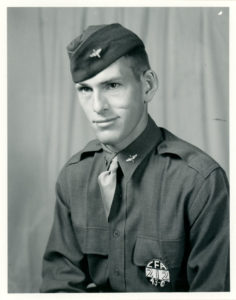 As for the Sunsetters, only one member of the Group survived captivity. He was Major Willison Madison Cox, of Knoxville, Tennessee. (3)
As for the Sunsetters, only one member of the Group survived captivity. He was Major Willison Madison Cox, of Knoxville, Tennessee. (3)
______________________________
What then, of the Smith crew?
Akin to MACR 1423 for the crew of the 7th Air Force B-24D Liberator Dogpatch Express, covered in my earlier posts, “Upon An Endless Sea” and “Portraits of the Fallen: The Crew of the Dogpatch Express, in Photographs”, MACR 1087 (like many “early” (and not only “early”) Missing Aircrew Reports covering multi-place aircraft) carries neither the home addresses nor the names of the crewmens’ next-of-kin.
The men are “anonymous”; they are simply names and serial numbers, without real identities.
However, akin to the crew of Dogpatch Express, it’s been possible to “reconstruct” nominal biographical information about these men. This was done using War Department Bureau of Public Relations Press Branch Casualty List issued on 13 December, 1943 (from the United States National Archives) and especially – particularly – various databases at Ancestry.com. Using these resources, the identities of the men’s next-of-kin, and wartime places of residence could be identified.
So, briefly, this is who they were:
Pilot: Smith, Richard, F/O, T-186554
Mr. and Mrs. Albert R. [Died June 7, 1965] and Mary (Hellinger) Smith (parents), 17 Klass Ave., Buffalo, N.Y.
Mentioned in Buffalo Courier-Express December 14, 1943. Mr. Albert Smith’s obituary appeared in the same newspaper on June 10, 1965.
Co-Pilot: Newland, Otis Terrell, F/O, T-346
Born 1920, in Texas
Mr. and Mrs. Cam Alexander and Catherine C. Newland (parents), Joe L. Newland (brother), Route 3, Lone Oak, Tx.
Navigator: Chapin, Robert Dudley, Jr., 2 Lt., 0-671281
Born 1921
Lt. Cdr. and Mrs. Robert Dudley [May 20, 1876 – 1945] and Sara (Newton) [1882 – August 21, 1961] Chapin (parents); Linda Chapin [1907 – September 30, 1916] (sister), Cynthia (Chapin) Taylor (sister) [April 1, 1917 – September 12, 1982], 20 Huntington St., Hartford, Ct.
The above genealogical information about the Chapin family is by FindAGrave contributor C. Greer, whose memorial / biographical profile for 2 Lt. Chapin includes a photograph of his parents’ tombstone, on which the younger Chapin’s name is inscribed.
Due to uncertainty about copyright, I won’t display the photo “here”! Rather, you can view the image at this link.
Radio-Operator / Gunner: Anagnos, Theodore, Sgt., 32503485
Born 1914, in Oregon
Mrs. Phyllis H. Anagnos (wife), 8417 North Military Ave., Detroit, Mi.
Mr. and Mrs. Speros and Evangeline Anagnos (parents), George and Peter (brothers), 1301 Hart Ave., Detroit, Mi.
Gunner: Boykin, Johnnie Rayford, Sgt., 18121719
Born May 27, 1922, in Swenson, Texas
Mrs. Berna Dean (Stephens) Boykin (wife) (Born July 28, 1925, Mountainair, N.M. – Died November, 1982)
Johnnie Dean Boykin (son; born August 18, 1943 – died 2007) Dexter, N.M.
Mr. and Mrs. Roy Hammel and Lillian (King) Boykin (parents), Lee Roy Boykin (brother), Hagerman, N.M. / 408 W. 6th St., Roswell, N.M.
Some Observations
Born in the 1910s and 20s, they were, unsurprisingly and typically, all “young” men, with Sgt. Anagos – born in 1914 – having been the oldest.
Akin to radio operator Johnnie Boykin (yet unlike pilot Smith, co-pilot Newland, and navigator Chapin) Anagos was married.
Johnnie Boykin (assuming I’ve interpreted records at Ancestry.com correctly – well, I think I have!) became a father while overseas. His son, Johnnie Dean Boykin, was born in August of 1943. Only two and a half months old by November 3, 1943, father and son would never meet. Johnnie Dean died in 2007, while his mother, Berna Dean, passed away in 1982.
Though I have no knowledge of the numbers of sorties flown by the crew, their ranks (the pilot and co-pilot were Flight Officers) and the identical military awards received by each crew member (according to the ABMC website, each aviator was awarded the Air Medal and Purple Heart) suggest (?) that they were a relatively “new” crew, having flown – either as a unit, or individually – no more than ten combat missions.
To signify that these men were more than “data”; more than mere names and serial numbers; more than statistics, here’s the one portrait I was able to find of a crew member: Sergeant Boykin. His photograph and biography are among World War Two Records of the State of New Mexico, which can be accessed at Ancestry.com.
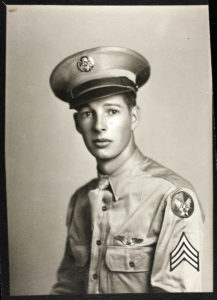 ______________________________
______________________________
The airmen’s names are memorialized on the Walls of the Missing at the Manila American Cemetery in Luzon.
The ABMC website gives each man’s date death as December 15, 1945, which likely reflects a date arbitrarily established by the Army upon the closure of the postwar investigation of the crew’s fate.
______________________________
But, what of the impetus for this post – the photograph itself…?
Scanned at 1200 dpi, it’s shown below.
 The image has several notable qualities.
The image has several notable qualities.
In a purely photographic sense, the picture is comprised of three “elements” that “balance” one another:
B-25G 42-64851 captured in flight, in the right center. (2)
A glassily calm sea extending to the horizon, a vague curtain of clouds suspended above, in the distance.
And both significantly and ironically, the smallest element in the image: The Smith crew, in their raft, can be seen at center left, probably headed for Bili Bili Island. Of particular note, the silhouette of the aviator on the right (it looks like he’s wearing his Mae West) is clearly distinguishable against the surface of a remarkably smooth sea.
Whether by chance, skill, or both – unfortunately, the MACR doesn’t list the photographer’s name! – the combination of composition, focus, lighting, and perspective is remarkable.
Given that neither the mainland nor the island are visible, the “direction” towards the horizon (as opposed to the direction of flight of the overlying B-25) is probably either to the north-northeast (so Bili Bili island is out of view to the “right”), or … south-southwest (thus, Bili Bili Island is out of view, to the “left”).
In this, the image is strikingly reminiscent of and similar to a photograph – below (in Lawrence Hickey’s Warpath Across the Pacific, from the Melvin L. Best collection) – showing the crew of Captain William L. Kizzire standing atop the rear fuselage of their B-25D Mitchell (41-30046 – Impatient Virgin) after their plane was ditched during a low-level attack mission to Boram Strip, near Wewak, a little over three weeks later: on November 27, 1943.
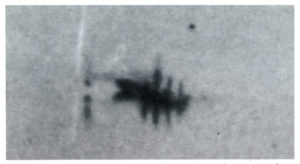 As listed at both Pacific Wrecks and Warpath, the men are:
As listed at both Pacific Wrecks and Warpath, the men are:
Pilot: Capt. William L. “Kizzy” Kizzire, 0-726787, Greybull, Wy.
Co-Pilot: 2 Lt. Charles G. Reynolds, 0-661563, Bridgeport, Oh.
Navigator: 1 Lt. Joseph W. Carroll, Jr., 0-665898, Dallas, Tx.
Flight Engineer: S/Sgt. Wilfred J. Paquette, 31127441, Northampton, Ma. (Killed while POW)
Radio Operator: S/Sgt. Roy E. Showers, Jr., 18075424, Pampa, Tx. (Killed while POW)
Gunner: S/Sgt. Fred D. Nightwine, 13085578, Slippery Rock, Pa. (Killed while POW)
Akin to members of F/O Smith’s crew, three members of Captain Kizzire’s crew – Sergeants Nightwine, Paquette, and Showers – were the subject of radio propaganda broadcasts, transcripts of which are available at Pacific Wrecks’ Radio Tokyo Broadcasts in English. (4)
______________________________
Finally, two photographs.
First, an April 2010 image of Astrolabe Bay – looking east towards the Bismarck Sea – by Jan Messersmith, from his blog Madang – Ples Bilong Mi: A Daily Journal of a Permanent Resident of Paradise. Perhaps the crews of the Sunsetters saw a vista akin to this – actually, strikingly beautiful – on the third of November in the year 1943.
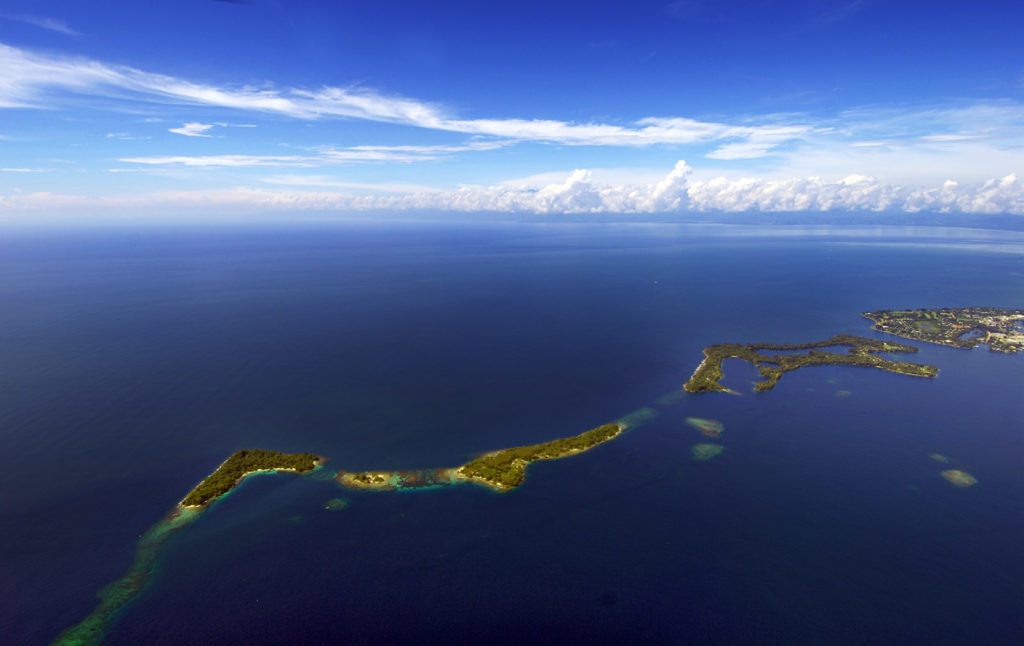 Second, to close the story – though its ending will likely ever remain uncertain; it will probably never be fully “closed” – the Smith crew, in their raft, floating between the New Guinea mainland and Bili Bili Island.
Second, to close the story – though its ending will likely ever remain uncertain; it will probably never be fully “closed” – the Smith crew, in their raft, floating between the New Guinea mainland and Bili Bili Island.
I’m not in possession of Individual Deceased Personnel Files for members of the Smith crew, but considering that the definitive fate of the crew has never been established, I would suppose that those documents would offer little to resolve the men’s fate.
Well, it may be a trite expression, but it’s true: Times marches on – and it proceedes quickly.
Now 2019, only twenty-four more years remain until the year 2043. By then, a century will have transpired since the November day when crew of B-25G #850 flew into history. It would be as predumptuous as it would be naive (and probably inaccurate, to boot, though it would be intriguing!) to predict the nature of “that” world, for who in 1943 could have predicted the nature of “our” world; of 2019?
But, despite changes in technology, economics, and science, one constant will remain, and has always remained: That of human nature. And part of that nature is the need; actually very necessity, to remember the past and those who were part of it.
(1) Pvt. Smith, a soldier in the 133rd Infantry Regiment of the 34th Infantry Division, was killed in action on January 28, 1944. He is buried at the Sicily-Rome American Cemetery in Nettuno, Italy, at Grave 56, Row 10, Plot I.
(2) Well, enlarged, the serial number of the overflying B-25G seems to be 42-64851! A check of the Aviation Archeology database (unfortunately inaccessible for some time), and a hunting expedition at DuckDuckGo reveal no information about this aircraft.
Fortunately, a review of B-25s assigned to the 823rd Bomb Squadron, listed in Appendix III of Sunsetters of the Southwest Pacific, reveals the following for this aircraft: “Possibly flown overseas by 2 Lt. George J. Maturi crew. (August, 1943) Transferred to 4th Air Depot (January 8, 1944), Townsville, then to 822nd BS.” The plane is consequently listed among B-25s assigned to the 822nd Bomb Squadron, specifically on February 26, 1944. After a mid-air collision on August 1, 1944, the aircraft was transferred to the 376th Service Squadron for salvage.
In this 1200 dpi scan, the pilot is clearly visible, while the head of the gunner can be seen within the dorsal turret. Other details of the plane – such as the plexiglass tail-cone, which seems to have been strangely truncated, and open to the air – are also evident.
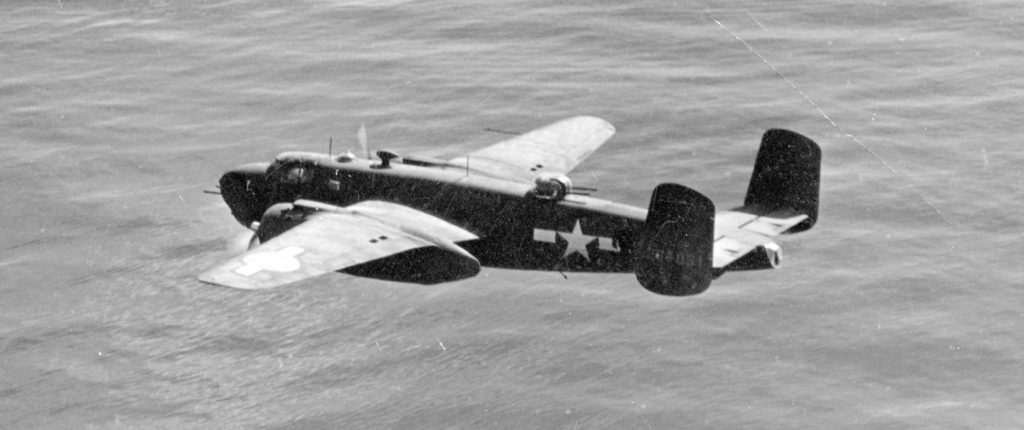 (3) The pilot of B-25D 41-30118 (Elusive Lizzie / Miss America, covered in MACR 16113) Major Cox’s was shot down during a mission to Madang on August 5, 1943. One member of his crew, S/Sgt. Raymond H. Zimmerman, was killed when the aircraft crashed. The four remaining crewmen were captured, and eventually murdered at Amron. Portraits of Major Cox and his navigator, 1 Lt. Louis J. Ritacco (from Port Chester, N.Y.) are shown below. Akin to the portrait of Lieutenant Hill, their pictures are from NARA’s “Photographic Prints of Air Cadets and Officers, Air Crew, and Notables in the History of Aviation – NARA RG 18-PU”.
(3) The pilot of B-25D 41-30118 (Elusive Lizzie / Miss America, covered in MACR 16113) Major Cox’s was shot down during a mission to Madang on August 5, 1943. One member of his crew, S/Sgt. Raymond H. Zimmerman, was killed when the aircraft crashed. The four remaining crewmen were captured, and eventually murdered at Amron. Portraits of Major Cox and his navigator, 1 Lt. Louis J. Ritacco (from Port Chester, N.Y.) are shown below. Akin to the portrait of Lieutenant Hill, their pictures are from NARA’s “Photographic Prints of Air Cadets and Officers, Air Crew, and Notables in the History of Aviation – NARA RG 18-PU”.
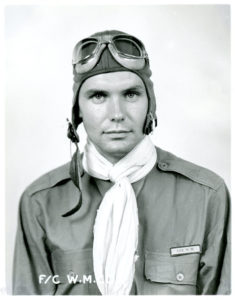 Flight Cadet Williston Madison Cox, Jr.
Flight Cadet Williston Madison Cox, Jr.
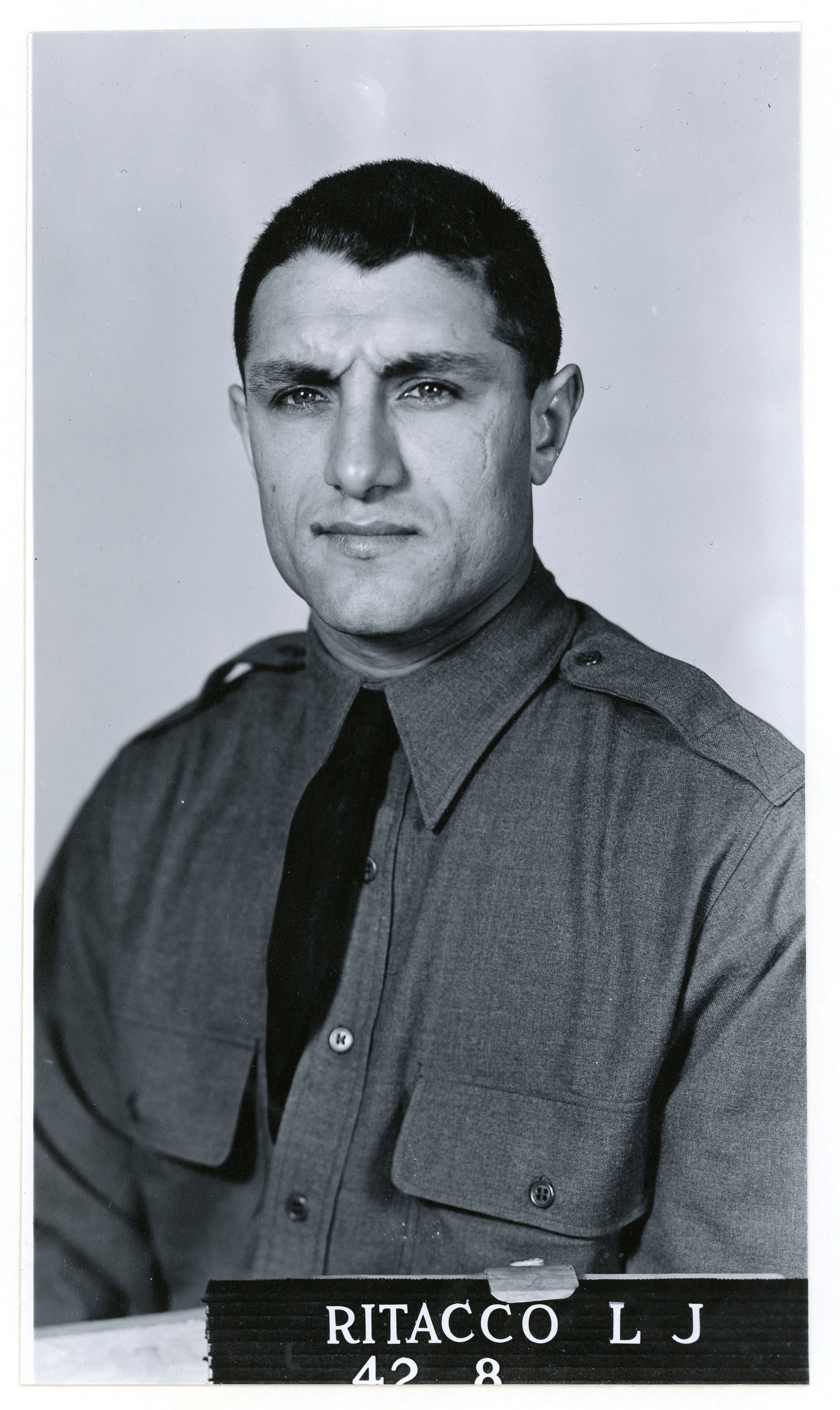 Cadet Louis James Ritacco
Cadet Louis James Ritacco
Major Cox’s loss is given notable attention in Garrett Middlebrook’s Air Combat At 20 Feet, the cover art of which I hope to (some day!) display in my brother blog, WordsEnvisioned, illustrating cover and interior art in books and pulp magazines from the 40s and 50s (and even more…).
(4) Of the numerous members of the 345th Bomb Group – the “Air Apaches” – who were known to have been taken captive, eight survived the war.
Listed by date of capture, they were:
McGuire, James, 1 Lt., 0-674314, Pilot (Grants Pass, Or.)
Captured March 30, 1945, while piloting B-25J 44-29350 (500th Bomb Squadron), covered in MACR 15450.
A remarkable and chilling photograph of Lt. McGuire’s B-25, on fire and diving towards Yulin Kan Bay, at the southern tip of Hainan Island, is shown below. This image, from the collection of Samuel W. Bennett (via Kevin Mahoney) appears in Lawrence Hickey’s Warpath Across the Pacific.
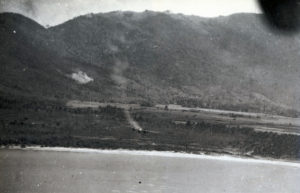 The latitude and longitude coordinates given for 44-29350’s loss are listed in the 500th Bomb Squadron Mission Report for the March 30 mission, as 18-10-20 N, 109-33-00 E, but they’re not given in the crew’s postwar “fill-in” MACR, which was filed on 10 April, 1946,
The latitude and longitude coordinates given for 44-29350’s loss are listed in the 500th Bomb Squadron Mission Report for the March 30 mission, as 18-10-20 N, 109-33-00 E, but they’re not given in the crew’s postwar “fill-in” MACR, which was filed on 10 April, 1946,
When plugging this location Google Maps, the location generated is about halfway between “Shendao” and “Jinmu Corner”, just off the point of land projecting west.
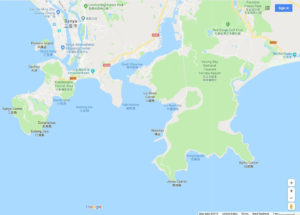 The 3-D aerial view below gives you a better idea of the crash location, which is identified by Google Maps’ red pointer. Intriguingly, the location (of course, the coordinates should be understood as being approximate), appears to be at the very end of a breakwater / jetty projecting west into Yulin Bay, between Shendao and Jinmu Corner.
The 3-D aerial view below gives you a better idea of the crash location, which is identified by Google Maps’ red pointer. Intriguingly, the location (of course, the coordinates should be understood as being approximate), appears to be at the very end of a breakwater / jetty projecting west into Yulin Bay, between Shendao and Jinmu Corner.
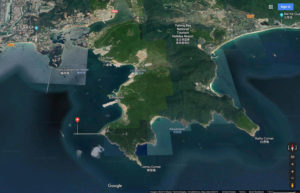 The elevated terrain to the west of the “Yalong Bay National Tourism Holiday Resort” (the dark color of terrain, compared to the light-colored low-lying terrain just to its west, may simply be an artifact of image processing) might correspond to the ridge visible behind the descending B-25, in the Bennett collection photo shown above.
The elevated terrain to the west of the “Yalong Bay National Tourism Holiday Resort” (the dark color of terrain, compared to the light-colored low-lying terrain just to its west, may simply be an artifact of image processing) might correspond to the ridge visible behind the descending B-25, in the Bennett collection photo shown above.
Finally, for completeness, here’s a map of Hainan Island…
Lawlis, Merritt E., Capt., 0-432168, Navigator (Indianapolis, In.)
Muller, Benjamin T., S/Sgt., 18090388, Radio Operator (El Paso, Tx.)
Captured April 3, 1945. Crew members of 1 Lt. William P. Simpson, from B-25J 43-27888 “Pensive” (500th Bomb Squadron), covered in MACR 14225.
________________
Shott, John, Cpl., 33421756, Tail Gunner (Aliquippa, Pa.)
Captured May 17, 1945. Crew member of 2 Lt. James T. Lackey, from B-25J 44-30164 (500th Bomb Squadron), covered in MACR 14447.
________________
Hart, Ted U., 2 Lt., Oak Park, Il., 0-771709, Pilot (Oak Park, Il.)
Gatewood, Henry, 2 Lt., 0-812542, Co-Pilot (Holly Springs, Ms.)
Ehlers, Karl L., 2 Lt., 0-1017008, Navigator (Niagara Falls, N.Y.)
Beck, Theron Kenneth, Cpl., 15364114, Radio Operator (Louisville, Ky.)
Captured May 27, 1945. Aircraft B-25J 44-28152 “Apache Princess”, (501st Bomb Squadron), covered in MACR 14524.
______________________________
A Digression: Missing Air Crew Reports and the Destiny of Historical Documentation
The historical importance of Missing Air Crew Reports has been apparent since the declassification of these records in the 1980s. Though obviously of central use in resolving the fate of missing WW II Army Air Force personnel, the information in these reports extends to areas as military technology, aerial combat tactics, air-sea rescue, outdoor survival (in all manner of terrains and climates), escape and evasion, the experiences of POWs, war crimes, and even in a subtle way – perhaps inevitably, though indirectly – the postwar readjustment of veterans and military casualties to civilian life, and genealogy.
As presented in my earlier post, The Missing Photos: Photographic Images in Missing Air Crew Reports, I was very fortunate in 2014 to have had the opportunity to examine Missing Air Crew Reports in their “original” physical – print – format, ultimately making digital copies of a small number of these documents: specifically, those MACRs which include photographs.
Having first learned about MACRS in the mid-1980s, this was a marked change from the way I’d previously accessed and studied these documents. That effort was first done using microfiche copies purchased from NARA, next through visits to the National Archives in College Park, and finally, in digital format, via Fold3.
It was through latter format that I conducted the bulk of my research into these documents. Ironically, though the nominal ability to access and study MACRs via Fold3 has been extraordinarily convenient (and hey, fewer road trips via I-95 – ugh! – to College Park) and productive (searching by MACR number, surname, or aircraft serial number is extremely useful), I discovered that the potential value of digitized MACRs on Fold3 is severely hampered by the quality of images of the MACRs, and, the design of the Fold3 MACR database.
This problem was described by aviation historian Frank J. Olynyk in a 2012 post at the 12oclockhigh forum, which is worth reading in detail.
I can verify Mr. Olynyk’s observations.
As he described, many Missing Aircrew Reports,are simply; completely absent from Fold3. (An example: Try searching for MACRs 3500 and 3631, for B-24H 42-95064 (464th BG, 778th BS) piloted by 2 Lt. Edward J. Barres, or, search by the bomber’s serial number. Good luuuck…!) This is even true for reports far “higher” in the numerical sequence of the documents than the mid-3000 range.
In addition, the quality of some scans, primarily among low-numbered MACRs (and even among some higher numbered MACRs) is extremely poor – sometimes so much as to render some digitized MACRs to be, well, er, uh…useless.
This is particularly ironic in light of Fold3’s company history, which states, “The concept for Fold3 is rooted in the company’s years of experience in the digitization business as iArchives, Inc. Starting in 1999, iArchives digitized historical newspapers and other archive content for leading universities, libraries and media companies across the United States.
From the beginning, the iArchives team developed a unique understanding of the value of creating an online repository for the world’s original source documents. Leveraging the proprietary systems and patented processes built for the digitization of paper, microfilm and microfiche collections, the management team made a strategic decision: Use the iArchives platform to provide access to these historically significant and valuable collections.”
Uh? Okay.
Conjecture: These problems seem to have resulted from two factors.
First, the primary source material seems to have been the fiche version of the MACRs, rather than the original documents themselves.
Second, perhaps the low-numbered documents (er … um … I mean fiche) comprised the start of the learning curve by which the processors (who? where? when? how?) became familiar with procedures for digitization. If so, once digitizing and data entry had been systemized, any poor quality scans eventuating from the initial efforts at scanning – of low-numbered MACRs – were never replaced by a “second round” of suitable, better quality images. Similarly, errors or gaps from the processing of higher-numbered MACRs were likewise not corrected.
(Admittedly, conjecture on my part.)
What’s not uncertain is the potential – in terms of ease of searchability and quality of both images and information – that could have resulted from a better-designed and implemented effort at document processing and scanning. Given what I observed of the physical quality of the original MACRs (they’ve held up very well over nearly eight decades) the original documents could have been (carefully; conscientiously) scanned at high resolution, and, in color. Paralleling this, the database by which the MACRs are accessed could have been designed with an altogether different primary key (as per Mr. Olynyk’s suggestion), or, multiple primary keys.
In this, I’m reminded of the database of the National Archives of Australia, or that of the Commonwealth War Graves Commission, which in terms of aesthetic design, ease of use, presentation of results to the user, and quality of digital files, are very, very (very) impressive.
While obviously Fold3’s MACR collection is only one of numerous repositories of digital documents available through that website (owned by Ancestry.com since 2010), not a stand-alone collection with a dedicated website, the potential held for something much better.
In summary, though this digital resource is certainly valuable and useful, it is absolutely nowhere near what it could have been – in terms of quality, usability, and accuracy – had the design and creation of the product really been undergirded by measures of thought, planning, and quality control.
References
Books
Grover, Roy C., Incidents in the Life of a B-25 Pilot, AuthorHouse, October 19, 2006
Hickey, Lawrence J.; Janko, Mark M.; Goldberg, Stuart W., and Tagaya, Osamu, Sun Setters of the Southwest Pacific Area – From Australia to Japan: An Illustrated History of the 38th Bombardment Group (m), 5th Air Force, World War II – 1941-1946, As Told and Photographed by the Men Who Were There, International Historical Research Associates, Boulder, Co. (and) The 38th Bomb Group Association – (or) Albert A. Kennedy, Sr. (or) David Gunn, 2011
Hickey, Lawrence J., Warpath Across the Pacific: The Illustrated History of the 345th Bombardment Group During World War II, International Research and Publishing Corporation, Boulder, Co., 1984
Maurer Maurer, Air Force Combat Units of World War Two, Office of Air Force History, Washington, D.C. (Reprint from United States Government Printing Office, 1961), 1983
Middlebrook, Garrett, Air Combat At 20 Feet – Selected Missions From A Strafer Pilot’s Diary (A World War II Autobiography), Garrett Middlebrook, Fort Worth, Tx., 1989
“Message From the Front” – Japanese Radio Broadcasts from Tokyo to Western United States. Transcript within Records of the Foreign Broadcast Intelligence Service
Aircraft Histories
B-25D 41-30018, at Pacific Wrecks
B-25G 42-64850, at Pacific Wrecks
38th Bomb Group
823rd Bomb Squadron, 38th Bomb Group
Missing in Action and Prisoners of War
Japanese Military Installation at Amron, New Guinea
United States Defense POW / MIA Accounting Agency
Australian War Memorial
Alexishafen, New Guinea, Central Interpretation Unit (C.I.U.) Maps, at Australian War Memorial
United States National Archives
Records of the Foreign Broadcast Intelligence Service
Records Group 262, Entry 3, 530/17/11-13/00, Box 699.
War Department Bureau of Public Relations Press Branch Casualty Lists of 13 December, 1943
]]>First released in mid-August of 1940, Parade (edited by A.W. Parsons and Captain D.H. Flockhart) was published by the “Inter-Service Publications Directorate for the Joint Publications Board”. The magazine was printed in Cairo by the firm of Al Hilal, which was – according to the masthead – the magazine’s “Sole Distributor for Egypt, Sudan, Syria, Palestine and Cyprus”. As indicated by its intended distribution, Parade’s news coverage focused upon British military activity in the Mediterranean Theater, but in time, the magazine expanded its scope to cover news from other theaters of British military action. A central aspect of the magazine was the abundance of its photographic essays about the many national, ethnic, and religious groups of the Middle East, as well as military, cultural, and social news from the British Isles. And (!), the back page of many issues featured a full-page pin-up of a prominent (or not so prominent?!) British film actress.
Though Parade’s military news coverage naturally centered upon the activities of Britain’s military, given the vast scope of the multi-national Allied war effort in North Africa and the Middle East, it was natural that the magazine would also cover military activities and servicemen of other Allied nations.
One such example – the curiously titled photo essay “Pancakes for Breakfast”, about an American P-40 fighter squadron in North Africa – appeared in the magazine’s issue of July 3, 1943.
The anonymous author initially focused upon rations provided to American troops in the context of the American fighter squadron, and then discussed the pilots’ general living conditions, specifically mentioning the reticence of the squadron’s (anonymous) leading (7 victory) ace about discussing his aerial experiences. Based on a review of 65th Fighter Squadron aerial victories, this un-named captain was probably Roy E. Whittaker (0-431582), who attained two victories on Oct. 26, 1942, one victory on Oct.. 27, and four victories on April 18, 1943.
Though the pictures in the article (unfortunately!) have no captions, one photograph provides “the” central clue about the squadron’s identity: An image of the squadron bar shows a placard decorated with swastikas (designating aerial victories), pilots’ surnames, and primarily, a very distinctive painting of cartoon gamecock: The insignia of the 65th Fighter Squadron (Flying Cocks) of the 57th Fighter Group.
Though the roving reporter didn’t specify the date when he visited the Gamecocks, two clues in the photographs reveal the time frame of his visit.
One picture shows a discarded newspaper from Buffalo, New York (amidst a bunch of what are probably British 50 Pound Mark I aircraft bombs) with the fragmentary headline “Nazis in Tunis…” Given that Axis resistance ceased in Tunis occurred by May 13, 1943, this argues for a time-frame of late April to Early May of that year.
Another picture includes a view of the April 23, 1943 issue of Stars and Stripes, with the headline “Nazi Air Convoy Smashed”. This refers to what is commonly known as the “Palm Sunday Massacre” of April 18, 1943, in which the three squadrons of the 57th Fighter Group are credited with 49 aerial victories.
Much more information about that aerial battle is available at the 57th Fighter Group, while the first page of that very issue of the Stars and Stripes (from the 57th Fighter Group website) is shown below:
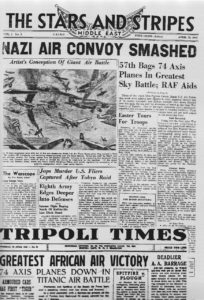 At the time, based on the Movement map of the 57th, the fighter group was based at Hani – or, “Sidi El Hani” – Tunisia, which is location number 15 on the map below (also from the 57th FG):
At the time, based on the Movement map of the 57th, the fighter group was based at Hani – or, “Sidi El Hani” – Tunisia, which is location number 15 on the map below (also from the 57th FG):
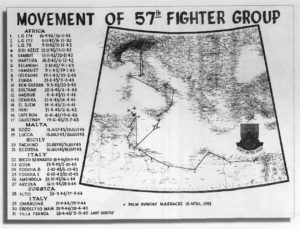 And so, here are the article and photos…
And so, here are the article and photos…
PANCAKES FOR BREAKFAST
How do the U.S. forces differ from the British in the way they spend spare time, the things they eat? A “Parade” reporter visited a U.S. Air Force unit, describes differences he noticed
It was our first visit to the American Air Force, to any Yanks in the field anywhere. There were similarities and there were differences comparing them with the R.A.F. The similarity seemed to spring from complete identity of job; they had the same modesty and sort of involuntary exclusiveness that the airman acquires, his operational element being other. The many differences were superficial. The food, for instance. For breakfast tomato juice, oatmeal (not the same as porridge), or pancakes with syrup, dehydrated eggs, peanut butter and coffee. Lunch menu was ‘Spam’ (meatcake) mealies, a sort of potato, the inevitable peanut butter and cocoa. For dinner hamburgers, vegetables and biscuits (our scones). There is the officers’ mess, where you eat, and the club where you sit and read Life, the American Parade, Stars and Stripes, innumerable shiny covered issues of Pocket Editions Incorporated; where you write letters and play poker, but very rarely drink anything, except, perhaps, iced water (many of these messes have refrigerators). Yanks are addicts to candy (candies are issued in their rations).
The Mess Sergeant
There is and there is not ceremonial. Not much saluting is done, and the officers often wear their metal bars, oak-leaves and other insignia of rank hidden under the collars of their jackets. The mess sergeant is a man of more formidable prestige than with us. You arrive a minute late for a meal and he lets you have it.’ He speaks merrily with officers, a cigar sticking out of the corner of his mouth, a slice of cake in his hand. He looks like a man behind a talkie ice-cream soda bar.
Mess conversation is much the same the world over. A difference among the Americans, though, is the ardour that comes into their voices when they talk about motorcars – automobiles to them. The convertible Cadillac is a name they conjure with indeed. The post-war ambition of one and all.
American airmen do not tell the world about their exploits. The captain I spoke to who was ‘ace’ of his squadron, with seven swastikas on the side of his P.40 fighter, made me feel like an inquisitor. He was waiting to take off on his second patrol that day. He must have been one of the youngest officers in the Wing. Not at all like a pilot in an American film. No more so than American newspapermen run true to their film types. He was quiet, almost self-effacing. These Parade pictures show an average day on a forward landing ground. It’s a dull day, punctuated by 1 ½ hour spells of excitement, perhaps one, perhaps two, perhaps three. Off duty there’s not much to do except read and play cards. Chief humorous item is listening to daily word dose under the auspices of Doctor Gobbels, a sort of fireside talk to Americans in North Africa, a wheedling address. The American airmen had their best opportunity to answer when they helped make hay of those Messerschmitts over Pantelleria.
______________________________
The photos accompanying the article appear below.
These three photographs show pilots of the 65th. Unfortunately (and unsurprisingly!) no names are given.
“Four pilots live in one tent. These three were friends back in their home town before the war so a letter from home – well, most of it anyway – is read out for the other two to hear all the news as they while while off duty.”
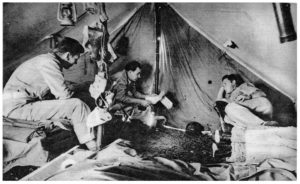 ______________________________
______________________________
These images are two different views of the interior of the squadron’s recreation tent, which also includes the squadron bar.
This “first” image shows as pilot appearing to perform some sort of mission-planning work. Next to him, the above-mentioned (April 23) issue of Stars and Stripes, with the headline clearly visible. Note the tail-fin assembly of a German bomb, to the left of the table, which now serves as a trashcan.
“Between sorties they write letters home, read large variety of magazines and newspapers – “Life,” “New Yorker,” “Reader’s Digest,” are favourites from home – with innumerable shiny issues of Pocket Editions Incorporated.”
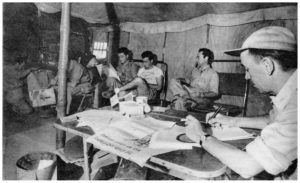 ______________________________
______________________________
For this next mage, the reporter has stepped further into the tent. The tail assembly of a even larger German aircraft bomb serves as the support for a radio (probably of British or (captured) German manufacture) which is attracting the attention of one of the pilots.
Repairing the radio is everybody’s hobby. It is an eight-valve super-heterodyne, but is usually out of order. When it does work they tune in to see what laughs Goebells can provide. Bar serves genuine cold water, a favourite drink.”
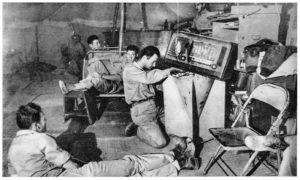 ______________________________
______________________________
“They rest, read newspaper. Crepe boots are preferred to the issue ones.”
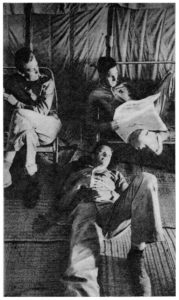 ______________________________
______________________________
Now we come to the squadron bar, which is faintly visible is the upper center of the preceding photo. The 65th Fighter Squadron Fighting Cocks insignia is clearly visible, albeit one of the pilots has carefully positioned himself to hide the squadron logo! Pilot’s names appear at the top of the board, though they’re not actually legible in this image. Unfortunately (deliberately? – accidentally?) the pilots’ names are not legible.
“Swastikas mean German aircraft down; plate was present from R.A.F.”
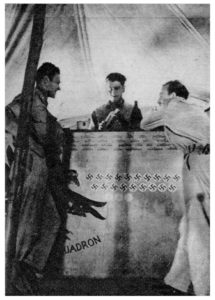 ______________________________
______________________________
A discarded Buffalo newspaper, amidst some British 50-pound Mark I aircraft bombs.
“This was the home town paper of one of the American airmen, eagerly read when it arrived, now forgotten, torn and abandoned amid the coarse scrub.”
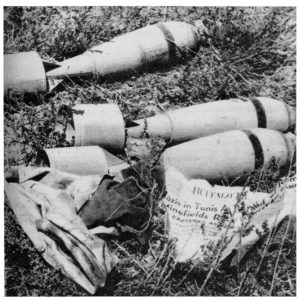 ______________________________
______________________________
But wait, there’s more!…
On December 11, 1942, American newspapers carried the following photograph, which shows an earlier version of the Fighting Gamecocks’ bar. The unattributed image (it’s not an Army Air Force photograph – I checked Fold3 and wrote to NARA!) is captioned:
“OASIS – American officers based in western Egypt pictured as they relax between raids on Axis bases. Left to right seated are: Lieutenant C.F. Costanzo, of Manchester, N.H.; Lieutenant J.L. Morris, of Silver City, N.C.; and Lieutenant A.D. Jaqua, of South Bend, In. Behind bar, left to right are: Lieutenant H.M. Cohn, of Springfield, Ma.; Lieutenant D.F. Smith, of New York; Lieutenant Walter Reed, of Reading, Pa.; Lieutenant Clair D. Knopp, Meadville, Pa.”
Here’s the image, scanned from 35mm microfilm at 300 dpi.
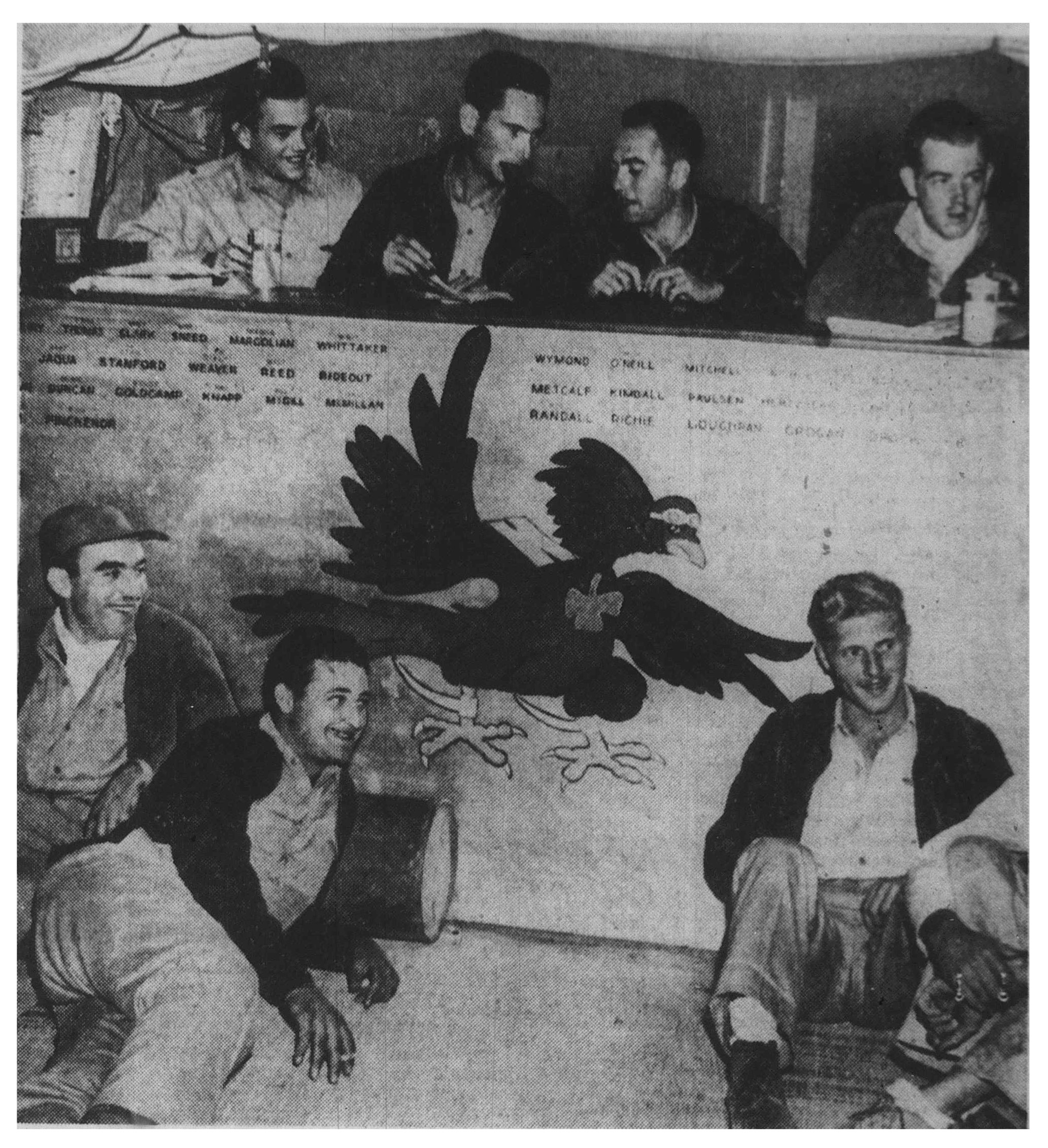 A little more information about the men in the picture. They are:
A little more information about the men in the picture. They are:
Seated
Costanzo, Charles F., 2 Lt., 0-791285; 1 Victory Jan. 11, 1943
Jaqua, Arnold D., 1 Lt., 0-440839; 2 Victories Dec. 8, 1942; KIA March 29, 1943 – No MACR
Behind Bar
Cohn, Herbert M., 2Lt., 0-791283; KIA Dec. 13, 1942, P-40 #93 – No MACR
Reed, Walter H, 1 Lt., 0-441017; 1 Victory April 18, 1943
And…”Knopp” is actually “Knapp“, Clair D., Lt
The resolution of the original print image is very good, such that many of the pilots’ surnames on the bar are legible. The names indicate:
First Row (Top)
__?__
Thomas (Gordon F. or Herbert M.) (If “Gordon F.”, then he was a Major, 0-397559; 1 Victory April 18, 1943)
Clark (Thomas W., Capt., 0-406233; 4 Victories)
Sneed (Marshall M., Capt., 0-427779; 1 Victory Jan. 20, 1943; KIA Feb. 27, 1943 – No MACR)
Margolian (Leon B., Capt., 0-420749; POW Dec. 10, 1942; P-40 #54 “Tiger Lil” – No MACR)
Whittaker (Roy E., Capt., 0-431582; 7 Victories – see above)
Wymond (Gilbert O., Jr., 1 Lt., 0-431591; 3 Victories)
O’Neill (William W., Jr.)
Mitchell (Delbert V., 1 Lt., 0421007; 1 Victory Nov. 7, 1942)
Second Row
Jaqua (Arnold D., 1 Lt., 0-440839; 2 Victories Dec. 8, 1942 – KIA March 29, 1943 – No MACR)
Stanford (Harry H. Jr., 1 Lt., 0-442298; 3 Victories April 18, 1943)
Weaver (Edwin R., 1 Lt., 0-441053; 2 Victories April 18, 1943)
Reed (Walter H., 1 Lt., 0-441017; 1 Victory April 18, 1943
Rideout (Harold C., Jr. – KIA?)
Metcalf (Robert L., 1 Lt., 0-442290; 1 Victory Oct. 26, 1942)
Kimball (Richard W., 2 Lt., 0-442139; 1 Victory Oct. 31, 1942)
Paulsen (Richard B.)
Third Row
Duncan (Harold)
Goldcamp (Robert J.)
Knapp (Clair D., Lt. – see above)
“Migell” – (McGill, William F.?)
__?__
Randall (William J., 1 Lt., 0-727543 – KIA April 18, 1943)
“Richie” (Ritchie, Dudley W.)
Loughran (Fred J.)
Grogan (Charles E., Lt. Col., 0-22355; 1 Victory in 79th FG June 10, 1943)
Fourth Row (Bottom)
Flickenor (George J., Jr.)
Given the presence of Cohn and Jaqua in the image, and, the date of the picture’s publication, the picture was probably taken in Libya during early to mid-December of 1942, at the very latest. If so, the squadron’s then location would have been in Libya, either at Martuba (from November 16 through December 6) or Belandah (from December 2, 1942, through January 9, 1943).
References
USAF Credits for the Destruction of Enemy Aircraft, World War II – USAF Historical Study No. 85, Albert F. Simpson Historical Research Center, Air University, 1978
Maurer, Maurer, Combat Squadrons of the Air Force – World War II,
British 50 Pound Mark I aircraft bombs, at MichealHiske.de
]]>
If this is so during “conventional” times, then vastly more so during a time of war, when the pace, sweep, and nature of events – and the danger inherent to those events – is magnified many fold.
Some 75 years ago, such a situation transpired in the life of the pilot of a B-24 Liberator bomber.
But first, an explanation.
______________________________
In March and April of 2017, I created two blog posts concerning photographs I’d discovered at the United States National Archives in MACR (Missing Air Crew Report) number 1423. This MACR covers the loss of a B-24D Liberator (41-24214 – Dogpatch Express) of the 11th Bomb Group’s 42nd Bomb Squadron, over the Central Pacific Ocean, after a mission to the atoll of Taroa Island, in the Maloelap Atoll of the Marshall Islands, on December 21, 1943.
A particular image appearing in the “first” post is a very high resolution (2400 dpi) cropped scan of one of the photographs, showing the damaged bomber shortly before it crashed into the sea…
 The “second” blog post includes an image accompanying the FindAGrave biographical profile of T/Sgt. Roy T. Gearon, the bomber’s radio operator, via FindAGrave contributor Patrick Maher, Sgt. Gearon’s cousin. The picture shows most of the ill-fated bomber’s crew, as they appeared some months prior to the December twenty-first mission. The image is captioned: “Roy’s crew picture taken a few months before they were shot down. T/Sgt. Roy Thomas Gearon bottom left.” While T/Sgt. Gearon’s FindAGrave profile gives no further information about this image, in light of recently acquired information and photographs (see much more below…), it’s seen that T/Sgt. Gearon is at the far left, standing.
The “second” blog post includes an image accompanying the FindAGrave biographical profile of T/Sgt. Roy T. Gearon, the bomber’s radio operator, via FindAGrave contributor Patrick Maher, Sgt. Gearon’s cousin. The picture shows most of the ill-fated bomber’s crew, as they appeared some months prior to the December twenty-first mission. The image is captioned: “Roy’s crew picture taken a few months before they were shot down. T/Sgt. Roy Thomas Gearon bottom left.” While T/Sgt. Gearon’s FindAGrave profile gives no further information about this image, in light of recently acquired information and photographs (see much more below…), it’s seen that T/Sgt. Gearon is at the far left, standing.
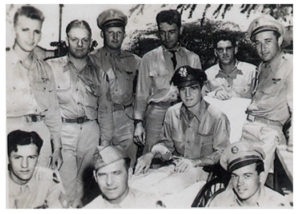 Though my prior posts list the names of the plane’s crew members (from MACR 1423 – the first sheet is below), in the absence of other information it was then impossible to attach “names to faces”.
Though my prior posts list the names of the plane’s crew members (from MACR 1423 – the first sheet is below), in the absence of other information it was then impossible to attach “names to faces”.
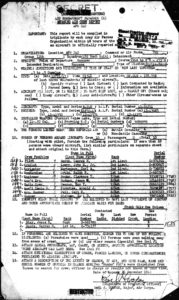 Thus, the men in the photograph remained, in senses both symbolic and very real, “unknown”.
Thus, the men in the photograph remained, in senses both symbolic and very real, “unknown”.
______________________________
Well, time passes.
Sometimes; all too often (especially in the world of 2018) time can drape a veil of forgetfulness over history.
But, on occasion, the passage of time can actually bring the past into clarity, memory, and awareness. Fortunately, such has happened with the names of the crewmen of Dogpatch Express.
Recently, I was contacted by Richard “Rich” Thomspon, Jr., through whom I learned that the officer in the center of the above photo – the fellow seated in the wheelchair – was his father, Second Lieutenant Richard (“Dick”) Sydney Thomspon, Sr. At the time the image was taken, Dick, severely wounded during the 11th Bomb Group’s mission to Wake Island, on July 24, 1943, was recovering from his injuries, probably at Oahu, Hawaii. As indicated by Roy Gearon’s FindAGrave biography, Dick indeed was being visited by his crewmen.
All but two of the men in the photo – aboard Dogpatch Express five months later – would not survive the war.
Rich has created a detailed, profusely illustrated, and well-written account of his father’s military experiences and postwar life, entitled Wicked Witch, which he has kindly shared with me. A few of the many evocative images from this document appear below.
As a result, through Rich’s assistance and enthusiasm, I’m now able to “attach” names to faces, and, casting aside time’s anonymity, definitively identify each airman. The mens’ identities have thus become more than the nominal information – “name, serial number, and next of kin” – typical of Missing Air Crew Reports and Casualty Lists.
______________________________
Dick Thompson was born in Boston on December 9, 1918. His family eventually moved to Pennsylvania, residing at 25 Rolling Road in West Park Station, a suburb of Carrol Park, near Philadelphia’s Overbrook Park section.
Dick entered the military in 1941 (prior to which time he’d been an iron-worker), before Japan’s attack on Pearl Harbor. He was eventually assigned to the “22nd Military Police” of the 1st Armored Division, and was stationed in Louisiana.
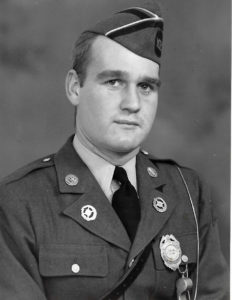 In time – though the details and specific dates are unknown – Dick entered the Army Air Force. Having completed training as an Aviation Cadet, he was commissioned as a Second Lieutenant on the 12th of December (Saturday), 1942. The other significant – if not greater – transition in his life was his marriage the next day to Elizabeth Marie McCaffrey, of Philadelphia.
In time – though the details and specific dates are unknown – Dick entered the Army Air Force. Having completed training as an Aviation Cadet, he was commissioned as a Second Lieutenant on the 12th of December (Saturday), 1942. The other significant – if not greater – transition in his life was his marriage the next day to Elizabeth Marie McCaffrey, of Philadelphia.
Though the details are unknown, Dick spent the Winter and Spring of 1943 doing further training in the southwestern United States. According to Rich, it’s unknown, “…when his crew was assigned or how much stateside “bonding” they got in before leaving for Hawaii.”
In any event, his crew initially – almost certainly – consisted of:
2 Lt. John E. Lowry, Jr. – co-pilot
2 Lt. Carl A. “Mort” Mortenson – navigator
Lt. Lori – bombardier
Technical Sergeant Clarence T. Sopko – Flight Engineer
Staff Sergeant Arnold J. Paradise – Radio Operator
Staff Sergeant Carl N. Dell – gunner
Staff Sergeant Earl D. Neilsen – gunner
Sergeant Del Vickio (spelling uncertain – could be “Del Vechio”, or, “Del Vecchio”) – gunner
Rich notes that each of the enlisted men wore at least four sergeant’s stripes, indicating that they may well have accrued more service time than their own four officers. The crew eventually arrived at Kualoa, Hawaii (specific date unknown – probably mid-June), where they were assigned to the 11th Bomb Group’s (the “Grey Geese”) 42nd Bomb Squadron.
On June 16, 1943, they flew aircraft 42-20688, the WICKED WITCH, as verified from data at the Oak Trust Library. Lt. George W. Smith, who would pilot the ill-fated DOGPATCH EXPRESS six months later, is known to have piloted the WITCH earlier – on June 7 – for a test of the plane’s automatic flight control equipment.
The 11th Bomb Group’s second combat mission since June of 1942 (the first having been a bombing and photo reconnaissance mission, staged from Funafuti (in the Ellice Island Group) to Makin and the Jaluit Islands), scheduled for July 24, 1943, was to be to Wake Island. For this purpose, the 11th staged at Fongafele Island, at Funafuti. Prior to that time the 11th Bomb Group was engaged in organizing itself as a combat organization, and, flying practice and patrol missions around the Hawaiian Islands.
Here’s an image of Dick having briefly “gone native” near the Funafuti Island church…
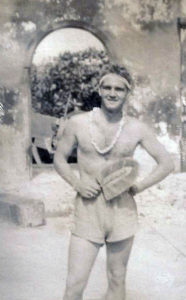 The July 24 mission would be Dick’s first opportunity to fly the WITCH since June 16. As noted by Rich (via historian Bob Livingstone of Brisbane, a member of the Aviation Historical Society of Australia and author of two books on the B-24), “…when a new crew came in with a new plane, the other air crews would “seize” their plane and give the new crew one of the ratty old planes that was pretty well used up. Hard to argue after seeing what happened to the “WITCH” as it did 6 missions in the 5 weeks dad was there but with Lieutenants Deasy, Stay, and Sands.” (In the time intervening since his arrival, Dick had piloted 9 other B-24s on a total of 18 missions.) Rich has also suggested that the allocation of new planes to veteran crews was, “…part of the training for a new crew. If they just got to fly a new plane all the time, they would likely as not have any mechanical issues to deal with. … Flying the older planes, especially during training and sea search missions would give them a chance to think and interact as a team trying to survive under extenuating circumstances. I think this was all by design of the bomb group commander, Colonel William J. Holzapfel, Jr., At this point in the war, he was responsible to ensure his airman were trained in the skills to win the war and he was learning right along with his air crews.”
The July 24 mission would be Dick’s first opportunity to fly the WITCH since June 16. As noted by Rich (via historian Bob Livingstone of Brisbane, a member of the Aviation Historical Society of Australia and author of two books on the B-24), “…when a new crew came in with a new plane, the other air crews would “seize” their plane and give the new crew one of the ratty old planes that was pretty well used up. Hard to argue after seeing what happened to the “WITCH” as it did 6 missions in the 5 weeks dad was there but with Lieutenants Deasy, Stay, and Sands.” (In the time intervening since his arrival, Dick had piloted 9 other B-24s on a total of 18 missions.) Rich has also suggested that the allocation of new planes to veteran crews was, “…part of the training for a new crew. If they just got to fly a new plane all the time, they would likely as not have any mechanical issues to deal with. … Flying the older planes, especially during training and sea search missions would give them a chance to think and interact as a team trying to survive under extenuating circumstances. I think this was all by design of the bomb group commander, Colonel William J. Holzapfel, Jr., At this point in the war, he was responsible to ensure his airman were trained in the skills to win the war and he was learning right along with his air crews.”
As noted by Richard, “in terms of aerial warfare, [the mission to Wake Island] was just one more mission with nothing to distinguish it from others. Conducted by Liberators of the reconstituted 11th, it was a “nuisance raid” ordered by the navy to relieve pressure in the South Pacific and to confuse the enemy as to where the next blow would fall.”
“12 planes were scheduled, 10 took off and eight went over the target to drop seven 500 pound general purpose bombs, 55 fragmentation bomb clusters and three 650 pound depth charges. Hits were scored on Wake’s oil storage areas, barracks and a gun emplacement.”
“When Lt. Richard Thompson’s WICKED WITCH got to Midway from Hawaii to stage for the Wake raid, their tail gunner, S/Sgt. Earl D. Nielsen, required an emergency appendectomy. When … Colonel Holzapfel asked the Marines for a replacement, there were more than 200 volunteers. So, the name of Sgt. William C. Campbell was drawn out of the hat. A Marine Captain offered $1,000 to take the Sergeant’s place, but was refused and Sgt. Campbell took over the tail guns of WICKED WITCH and over Wake, he downed a Zero. (The eight-plane raid claimed nine Zeroes destroyed, four probable and three damaged.)”
The Wake Island mission cost the 11th Bomb Group two B-24s and twelve airmen.
One aircraft, B-24D 42-40676 (Cabin in the Sky), piloted by First Lieutenant James R. Cason, was struck in the port fin and rudder by a Zero (whether accidentally or deliberately will remain unknown), crashing into the sea with no survivors. The plane’s loss is covered in Missing Air Crew Report 314.
Lieutenant Richard W. Lipman, whose detailed, frank, and often moving diary (encompassing November, 1942, through December, 1944) appears in Grey Geese Calling, recorded that, “Cason had his rear stabilizer rammed by a Zero and he spiraled down shooting all the way to explode upon hitting the water. I don’t know but I can’t seem to swallow the fact that the guys I know so well and the ship I flew in from Kualoa to Midway are gone forever. Clean cut Cason, good natured Thompson, “Slick” Moore, McConnell and Kane [?] just out of Cadets. Man, this ain’t for me!”
Along with Cason, the plane’s crew comprised:
1 Lt. Loren E. Thompson – Co-Pilot (Nehama County, Nebraska)
2 Lt. Robert B. McConnell – Navigator (Multnomah County, Oregon)
2 Lt. Ernest W. Moore – Bombardier (Anderson County, South Carolina)
T/Sgt. Lee R. Sterner – Flight Engineer (Muscatine County, Iowa)
S/Sgt. Lloyd R. Taylor – Radio Operator (Wilson County, Kansas)
S/Sgt. James W. Strope – Gunner (Chicago, Illinois)
Sgt. Louis N. Lane – Gunner (Lenawee County, Michigan)
S/Sgt. Harlan G. Davis – Gunner (Harrison County, West Virginia)
Sgt. Robert O. Stephens – Gunner (Los Angeles, California)
Cpl. Walter F. Kowalski – Photographer (Lackawanna County, Pennsylvania)
Here’s a photograph of eight members of James Cason’s crew, reportedly taken a few hours before this mission, from Cason’s FindAGrave biographical profile, provided by contributor Terry Woodward. The image comes from the scrapbook of Bill Morrison. Unfortunately, no names – “who is who?” – are listed.
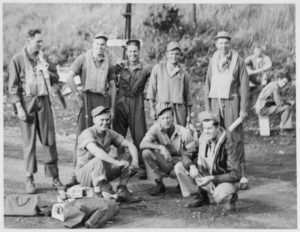 …and, also from Bill Morrison’s scrapbook, we find an image of Lt. Cason, as seen in Hawaii in the summer of 1943 (also contributed by Terry Woodward):
…and, also from Bill Morrison’s scrapbook, we find an image of Lt. Cason, as seen in Hawaii in the summer of 1943 (also contributed by Terry Woodward):
 Aboard another B-24D, 41-23983, 1 Lt. Joseph A. Gall’s Daisy Mae, two crew members were killed and two wounded during attacks by Zero fighters. Lt. Gall and F/O Van Horn crash-landed their bomber at Sand Island, one of the three islands comprising the Midway Atoll (the others are Eastern and Spit Islands).
Aboard another B-24D, 41-23983, 1 Lt. Joseph A. Gall’s Daisy Mae, two crew members were killed and two wounded during attacks by Zero fighters. Lt. Gall and F/O Van Horn crash-landed their bomber at Sand Island, one of the three islands comprising the Midway Atoll (the others are Eastern and Spit Islands).
Included in Lt. Gall’s crew were:
F/O John N. Van Horn – Co-Pilot
2 Lt. Benjamin I. Weiss – Navigator – Wounded
2 Lt. Myron W. Jensen – Bombardier – Died of Wounds (Douglas County, Nebraska)
S/Sgt. Arvid B. Ambur – Flight Engineer / Waist Gunner – Wounded
T/Sgt. Thomas Wyckoff – Top Turret Gunner – Wounded
S/Sgt. Robert L. Patterson – Radio Operator / Waist Gunner
S/Sgt. Francis J. Perkins, Jr. – Gunner
S/Sgt. Robert B. Storts – Nose Gunner
S/Sgt. Earl W. Conley – Tail Gunner
Sgt. Joseph P. Evans – Photographer – Killed in Action (Tom Green County, Texas)
As described by Lt. Lipman, “Gall got shot up plenty. His ship I mean. Jenson [sic] got hit in the gut, shoulder and wrist – has a 50-50 chance of living. Sgt. Evans, photographer, got a gut wound and died before returning. There were 2 other injuries on board. There were 200 holes in “Daisy Mae”. I went over and saw it where Gall pulled to a stop on its nose 2 inches from the ocean at the end of the runway. He came in with 3 engines and no brakes.”
Here’s a view of the Midway Atoll taken on November 24, 1941, 14 days before December 7, 1941. (Image 80-G-451086) Eastern Island is in the foreground, and Sand Island is across the entrance channel, in the center background.
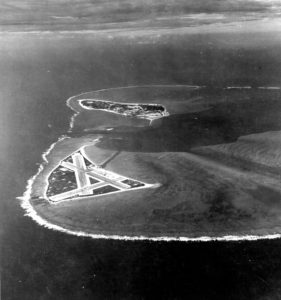 These two images, from B-24 Best Web, show Daisy Mae after her crash-landing, at the water’s edge. Not visible in the lower photograph is the presence of a nose turret (a grafted-on B-24 tail turret) which replaced the bombardier’s “birdcage” typical of B-24Ds.
These two images, from B-24 Best Web, show Daisy Mae after her crash-landing, at the water’s edge. Not visible in the lower photograph is the presence of a nose turret (a grafted-on B-24 tail turret) which replaced the bombardier’s “birdcage” typical of B-24Ds.
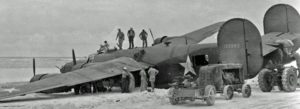
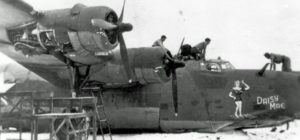 Lt. Jensen’s obituary, from his FindAGrave biographical profile, (contributed by Loren Bender) appears below:
Lt. Jensen’s obituary, from his FindAGrave biographical profile, (contributed by Loren Bender) appears below:
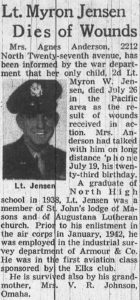 Despite Daisy Mae’s return, Lt. Jensen’s name is commemorated on the Courts of the Missing at the Honolulu Memorial. Quite strangely, it appears that he has no actual grave.
Despite Daisy Mae’s return, Lt. Jensen’s name is commemorated on the Courts of the Missing at the Honolulu Memorial. Quite strangely, it appears that he has no actual grave.
______________________________
And, aboard the WICKED WITCH?
During the attack by intercepting Zero fighters, the aircraft was struck by a projectile which penetrated the left forward fuselage, directly through the location of the painted WITCH’s left arm. (See photo below.) The shell penetrated Dick’s calf left leg and thigh, the pain and loss of blood rendering him unconscious. According to bombardier Lt. Thrasher, another projectile entered the WITCH in front of the nose wheel, passing between his legs and knocking him away from his bombsight.
Lieutenant John Lowry, Dick’s co-pilot, took control of the aircraft, bringing it safely back to Funafuti. After repairs, the WITCH would bear the symbol of one Japanese flag, for the Zero shot down by Sgt. Campbell.
Lt. Thrasher described both projectiles as having been 20mm cannon shells (from the Zeros fighters’ Type 99-1 cannon). Though it’s a point of conjecture, given the destructive explosive power of such shells and the evident (fortunate!) seeming absence of a actual explosions within the aircraft, I wonder if the plane was actually struck by .303 machine-gun bullets. Just an idea. If so, this would be consistent with a letter of 30 July sent to Dick’s wife from Adjutant General J.A. Ulio, which specifically states that, “Lieutenant Thompson sustained gunshot wounds…”
______________________________
This photo, taken some months before the July mission, shows Dick in the cockpit of the WITCH. Note the name “BETTINA” – evidently inspired by the name of his wife, Betty – below the cockpit. A name (“MUGGSIE”) also appeared under the co-pilot’s window, possibly the nickname of John Lowry’s wife, Margaret.
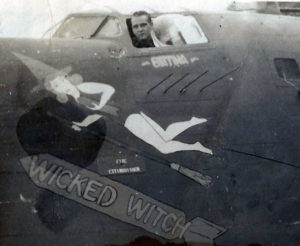 ______________________________
______________________________
The WITCH was destroyed during a Japanese air raid on Funafuti on November 17, 1943, her incinerated remains being the subject of Army Air Force photos 62903AC / 3A43074 and B-62903AC / A43076, shown below, respectively. While most of the plane has been reduced to aluminum cinders, some parts, such as engines, oxygen bottles, landing gear wheel hubs, the supporting truss for the Sperry ball turret, machine guns, as well as belts of .50 caliber ammunition, are identifiable.
With the demise of the WITCH, Dick’s crew were assigned to the DOGPATCH EXPRESS, the subject of the two prior posts.
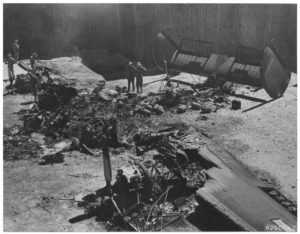
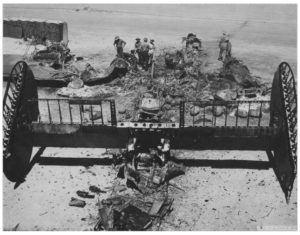 ______________________________
______________________________
The following three photos, via Rich, show Dick being visited by his crew at Oahu. The men were identified through communication with Rich, and, a close examination the these images. Along with Dick, two men in the photo – (Lt. Jim Thrasher, the bombardier, and Sgt. Larson, a gunner) were not aboard the DOGPATCH EXPRESS on December 21.
So, at last and at least, we finally know “who” they are…
______________________________
This “first” picture is identical to the crew photo appearing at Sgt. Roy Gearon’s FindAGrave biographical profile, albeit of much higher resolution. The men are, left to right:
Front row (kneeling):
T/Sgt. Clarence T. Sopko, gunner
Sgt. Larson (first name unknown) – gunner
S/Sgt. Carl N. Dell – tail gunner
Rear row (standing)
T/Sgt. Roy T. Gearon – Radio Operator
S/Sgt. Earl D. Nielsen – waist gunner
2 Lt. Carl. A. “Mort” Mortenson – navigator
Lt. Jim Thrasher – bombardier
S/Sgt. Arnold J. Paradise – gunner / radio operator
2 Lt. John E. “Jack” Lowry, Jr. – co-pilot
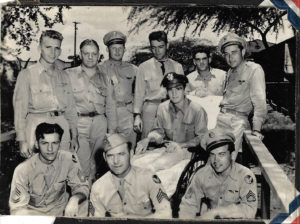 ______________________________
______________________________
In the picture below, the men have shifted positions. Given that all crew members are visible in the image, the picture must have been taken by an anonymous photographer “behind the camera”, perhaps a member of the hospital staff.
All are standing behind Dick, while S/Sgt. Earl D. Nielsen is kneeling in the front. The men are (left to right):
Sgt. Larson
T/Sgt. Clarence T. Sopko
T/Sgt. Roy T. Gearon
2 Lt. Carl. A. “Mort” Mortenson
Lt. Jim Thrasher
S/Sgt. Arnold J. Paradise
2 Lt. John E. “Jack” Lowry, Jr.
S/Sgt. Carl N. Dell
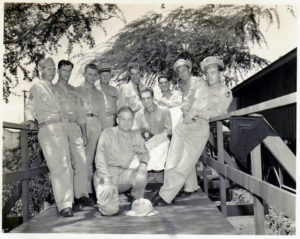 ______________________________
______________________________
Here’s a superb photo of the crew’s officer’s. Behind Dick stand:
Lt. Jim Thrasher
(Further information about Lt. Thrasher is unknown)
2 Lt. Carl. A. “Mort” Mortenson, 0-738872, Navigator
Mr. Harry Walter Mortenson (brother), 1380 Riverside Drive, Lakewood, Oh.
2 Lt. John E. “Jack” Lowry, Jr., 0-800907, Co-Pilot
Mrs. Margaret E. Lowry, Jr. (wife), Spring St., Smyrna, Ga.
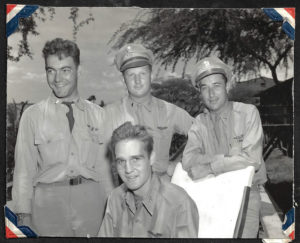 Along with the loss of the Cason and Gall crews, Lt. Lipman made note of Dick’s injury, and, Lt. Lowry’s return of the plane to Midway: “Dick Thompson was wounded in the leg at several places and by now he’s probably back at Oahu via an LB-30. It was only a miracle that Lowry was able to land that one OK and on Midway instead of 200 miles out.”
Along with the loss of the Cason and Gall crews, Lt. Lipman made note of Dick’s injury, and, Lt. Lowry’s return of the plane to Midway: “Dick Thompson was wounded in the leg at several places and by now he’s probably back at Oahu via an LB-30. It was only a miracle that Lowry was able to land that one OK and on Midway instead of 200 miles out.”
______________________________
First Lieutenants George W. Smith and Ralph P. Ortiz, the pilot and bombardier of DOGPATCH EXPRESS on December 21, do not appear in these photos. As such, they were almost certainly shifted from other crews to “fill-in” for Dick and Lt. Jim Thrasher on that date, with Lt. Smith perhaps “taking over” for Dick’s crew after the latter’s July 24 injury. Smith’s receipt of the Air Medal and Purple Heart, and Ortiz’ receipt of the Air Medal, two Oak Leaf Clusters, and Purple Heart, would suggest that they respectively completed from five to ten, and fifteen to twenty, combat missions, prior to December 21.
However, it is known that Smith had been injured almost six months previously. As recorded for June 14, 1943, by Lieutenant Lipman, “Well here’s the big story. Today 3 of our ships were to take off for an important photographic mission in the S.W. Pacific. All three were terrifically loaded down – the first two used every foot of the runway and barely cleared the trees then came #3 with me right alongside the runway in a jeep. About half-way down the runway its nose went down and it skidded for about 100 yards till it swerved off onto the highway. Two of its propellers flying off onto the adjacent beach. Well I can tell you that I spotted my underwear then and there. My first thought was to speed over there to see if I could help any of the crew to get out of the plane or to get to the hospital and off I flew in the jeep towards the plane about when I was 50 feet away flames broke out in engine #2 and off I went in the opposite direction only this time twice as fast because the uncomfortable vision of exploding hi-octane gas and exploding ammunition appeared in my mind.
The fire was put out, however, and the only person really hurt was Smith, the pilot, whose arm was quite smashed by a flying propeller.
Man some experience! I took a lot of pictures but Capt. Peairs of S-2 is going to see them – I hope to get them back.”
______________________________
Dick’s wartime scrapbook includes images of his crew’s enlisted men, possibly taken while his crew was undergoing training in the United States. (Further information may – ?- be forthcoming.) Fortunately, Dick had the foresight to record the names of each enlisted man below that man’s individual portrait.
That scrapbook page, which includes a group photo of the enlisted men, is shown below.
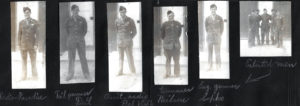 In this group photo, the men are (left to right):
In this group photo, the men are (left to right):
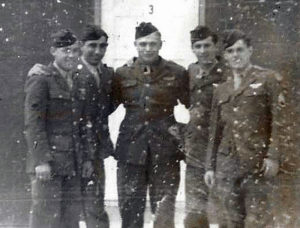 S/Sgt. Carl N. Dell
S/Sgt. Carl N. Dell
Sgt. Del Vickio (“Del Vechio” – “Del Vecchio”?)
S/Sgt. Earl D. Neilsen
T/Sgt. Clarence T. Sopko
S/Sgt. Arnold J. Paradise
The men’s individual portraits follow…
______________________________
S/Sgt. Carl N. Dell, 13038323, Gunner
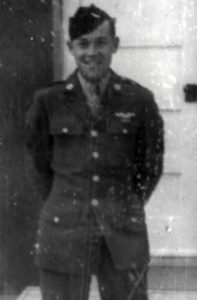 Born 4/19/20
Born 4/19/20
Mr. William J. Dell (father), Route 1, Middle Road, Pittsburgh, Pa.
Memorial Tombstone at Saint Mary’s Cemetery, Pittsburgh, Pa. (Photo by “Genealogy-Detective”)
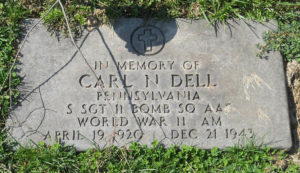 ______________________________
______________________________
Sgt. Del Vickio (“Del Vechio” – “Del Vecchio”?)
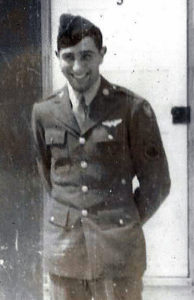 Like Lt. Thrasher and Sgt. Larson, Sgt. Del Vickio was also not a member of the Dogpatch Express crew on December 21.
Like Lt. Thrasher and Sgt. Larson, Sgt. Del Vickio was also not a member of the Dogpatch Express crew on December 21.
______________________________
S/Sgt. Earl Dewayne Nielsen, 39831608, Gunner (Tail Gunner?)
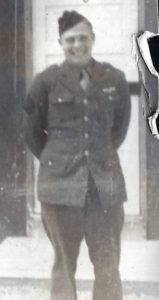 Born 7/29/21, Thatcher, Idaho
Born 7/29/21, Thatcher, Idaho
Mr. and Mrs. Albert (6/5/91 – 2/3/65) and Vera Charlotte (Panter) Nielsen (9/1/97 – 5/11/68) (parents); Albert, Earl, Phyllis, and Wilda (brothers and sisters)
Cleveland, Idaho
Memorial Tombstone at Cleveland Cemetery, Franklin County, Idaho (Photo by Bill E. Doman) Note that the tombstone does not carry the actual date of his death. This date, identical to that appearing on the website of the American Battle Monuments Commission, probably represents the date on which he was declared dead for legal purposes, according to Section 5 of Public Law 490. Such date discrepancies can be found for many servicemen still missing from the Second World War, particularly still-missing airmen and naval personnel who were casualties in the Pacific Theater and Asia. (And sometimes, Europe as well.)
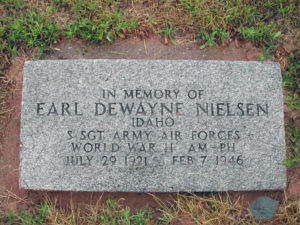 Here are two portraits of Sgt. Nielsen. The first, uploaded by Dianne Roberts to his FindAGrave biographical profile, and the second, at the Nielsen family tree, at Ancestors Family Search.
Here are two portraits of Sgt. Nielsen. The first, uploaded by Dianne Roberts to his FindAGrave biographical profile, and the second, at the Nielsen family tree, at Ancestors Family Search.
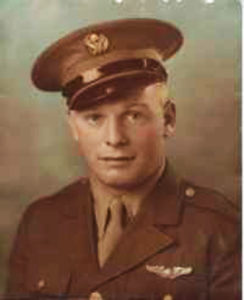
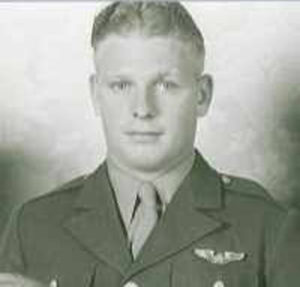 ______________________________
______________________________
T/Sgt. Clarence T. Sopko, 35308715, Flight Engineer
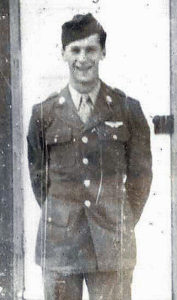
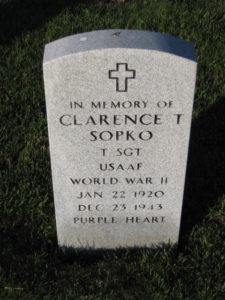 Born 1/22/20
Born 1/22/20
Mrs. Mary S. Sopko (mother), 2138 West 26th St., Cleveland, Oh.
Memorial Tombstone at Ohio Western Reserve National Cemetery – Section M, Plot 6 (Photo by Douglas King)
______________________________
S/Sgt. Arnold J. Paradise, 36264577, Gunner
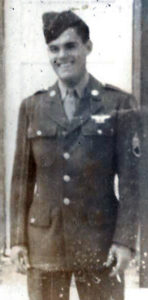
Mrs. Fern Paradise (mother), Garden Acres, Chippewa Falls, Wi.
WW II Memorial – June Havel (sister)
From Dick’s album, here’s a picture of Sergeants Dell and Paradise at the native church on Funafuti, around the time of the 11th’s mission to Makin and Jaluit. They seem to have “gone native”, like their pilot, Dick.
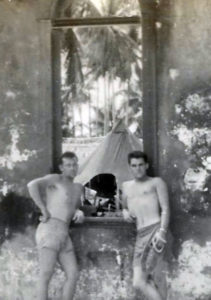 ______________________________
______________________________
S/Sgt. Jesse Harvey Hudman, S/Sgt., 12146959, Assistant Engineer (Gunner)
S/Sgt. Jesse H. Hudman was evidently not a regular member of the Thompson crew, and does not appear in the above photos. However, here’s an image of his memorial tombstone, at Dale Cemetery in Ossining, New York, followed by a news item from the Citizen-Register, of Ossining, N.Y., on May 22, 1946, regarding memorial services in his honor, which were held on Sunday, May 20, of that year.
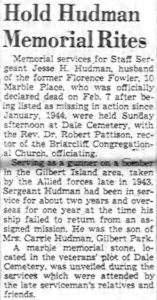
Born 1918
Mrs. Florence L. Hudman (wife), 10 Marble Place, Ossining, N.Y.
Mrs. Carrie Hudman (mother), Gilbert Park, N.Y.
Memorial Tombstone – at Dale Cemetery, Ossining, N.Y. (photo by Jean Sutherland)
Notices about Sgt. Hudman appeared in the Citizen-Register, of Ossining, N.Y., on May 22 (above) and 25, 1946. His name also appeared in an honor roll of WW I, WW II, and Korean War military casualties from Ossining which was published in the Citizen-Register on February 21, 1952.
______________________________
Due to the severity of his wounds, Rick would fly no more combat missions. He faced a very lengthy period of recovery.
This telegraph to his wife, at her family’s Boyer Street address in Philadelphia, dated July 28, informed Elizabeth Thompson of her husband’s injuries:
REGRET TO INFORM YOU YOUR HUSBAND SECOND LIEUTENANT RICHARD S THOMPSON WAS SERIOUSLY WOUNDED IN ACTION ON TWENTY FOUR JULY IN THE PACIFIC AREA REPORT FURTHER STATES MAKING NORMAL IMPROVEMENT YOU WILL BE ADVISED AS REPORTS OF CASUALTIES ARE RECEIVED
ULIO THE ADJUTANT GENERAL
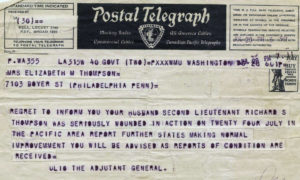 ______________________________
______________________________
Dick’s name appears (top right) in this casualty list published by the Philadelphia Inquirer on August 12, 1943, which represents only a part of the larger, nationwide casualty list released that day by the War Department.
Rich surmises that his father was well enough to travel back to the United States by October of 1943, based on a telegram – from Dick to Elizabeth – dated on the 18th of that month.
Some time around Christmas, 1943, while recovering at Brooke Army Hospital (now Brooke Army Medical Center) at Fort Sam Houston, Texas, Dick was featured in a broadcast on Armed Forces Radio.
In the photo below, the civilian holding the microphone is Dick Smith, the officer is Brooke Army Hospital Commander Brigadier General B.C. Beach, and the nurse is 1 Lt. Florence E. Judd, who made a full career as a military nurse, eventually rising to the rank of Major. According to George E. Omer’s 1957 article in Kansas History (“An Army Hospital: From Horses to Helicopters”), she, “…became the Fort Riley hospital chief nurse following an assignment at Walter Reed Army Hospital. Major Judd earned her R.N. degree in 1934 from Saint Mary’s Hospital in East Saint Louis and her postgraduate studies have earned a B.S. in nursing education from Columbia University and an M.S. in hospital administration from Baylor University.”
An excerpt of this interview follows this image of Dick, who appears to have an understandably pensive expression. Note especially the text…
“[Dick cut this part out: It’s a pretty sight, that flack, red and green fire bursting in the air around you.],” which presumably was never broadcast.
…and…
SMITH: That must have been a wonderful crew you had.
THOMPSON: They were swell. And I have been pretty upset about the latest news I’ve had about them. I got shipped home with this leg but they – they stayed in the fight. I’ve been told recently the plane is missing and that means all of the crew too.
Well, there are some events for which the fewer words, the better.
The transcript of the broadcast follows…
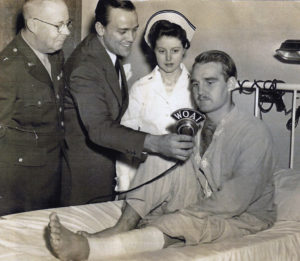 SMITH: Wherever our forces go, the Army Nurses Corps follows. Wherever the fighting is, they are near by – and these boys in this hospital can tell you it is a wonderful thing to have them. When a man is wounded, it is comforting indeed, to know they are present, to be in their capable, responsible hands. Many of the nurses here in Brooke General Hospital have seen duty overseas. For instance, here is First Lieutenant Florence E. Judd. She put in a year’s service in a base hospital in the Fiji Islands. It was a magnificent job you nurses did there, Lt. Judd. I spent some time in that hospital you were in – and I say thank you.
SMITH: Wherever our forces go, the Army Nurses Corps follows. Wherever the fighting is, they are near by – and these boys in this hospital can tell you it is a wonderful thing to have them. When a man is wounded, it is comforting indeed, to know they are present, to be in their capable, responsible hands. Many of the nurses here in Brooke General Hospital have seen duty overseas. For instance, here is First Lieutenant Florence E. Judd. She put in a year’s service in a base hospital in the Fiji Islands. It was a magnificent job you nurses did there, Lt. Judd. I spent some time in that hospital you were in – and I say thank you.
JUDD: You needn’t thank me or any other Nurse. I often think the hard work we did there, night and day, was its own reward. The lives we saved in those hospitals were worth all the work – and we felt that we were actually doing something in this fight for freedom everybody is always talking about.
SMITH: You had to work hard in those hospitals.
JUDD: Yes – everything was difficult because at that time we were starting from scratch. We were rushed there immediately after Pearl Harbor and had with us only such equipment as could be carried quickly. It was a rush job but I’m proud to say that it was also a good job. Some facilities were not comparable to those here at home, but we had the best equipment, best doctors, the best trained corpsmen – and it was amazing to see how rapidly the boys recovered from their injuries.
SMITH: You want to be sent overseas again?
JUDD: Definitely. Once you have seen the war at close hand, you feel strange in the ordinary, peaceful atmosphere of home again. You keep recalling all the suffering you have seen. You want to get back into it to see that you can do to lessen it. You feel guilty enjoying anything when you know how miserable, how dreadful are the things our men must face. Maybe what you do is very little, but at least, you are in it.
SMITH: Don’t you feel you are in it here, serving in this hospital which is receiving overseas casualties?
JUDD: Of course, I do. But this is home. Over there the men are far from home. It is a terrible thing to be wounded far from home.
SMITH: It must be.
JUDD: But we never heard the boys complain. They were the best patients I ever worked with. They were appreciative of even the- least attention.
THOMPSON: And they should have been. They had the best nurses in the world to give them attention.
JUDD: Thank you, sir.
THOMPSON: I’m Lieutenant Richard S. Thompson, Mr. Smith. I want to say a thing or two on this broadcast, if I may.
SMITH: Of course, you may.
THOMPSON: Just something I’ve had on my chest.
SMITH: Go ahead.
THOMPSON: I was in the Air Force, pilot of a bomber on patrols out of Hawaii.
SMITH: Is that where you were wounded?
THOMPSON: Oh, no. I got mine, flying in a nuisance raid over Wake Island.
SMITH: Tell us about that.
THOMPSON: Well, you know Wake is a pretty small island –
SMITH: But a famous one.
THOMPSON: That’s right. It cost the Japs plenty to take it from our Marines, and they have it well defended today. They mean to make it cost us when we take it back. We went over on our raid one day about noon. And we were very lucky. We caught twenty Japanese Zero planus on the ground. I’m pleased to report our aim was good and we put all of them out of commission. But we didn’t get away scot free – at least I didn’t.
SMITH: What happened?
THOMPSON: Well, there were thirty Zeros which weren’t on the ground – and they weren’t out of commission either. They settled on us like hornets. The flack was bad, too. [Dick cut this part out: It’s a pretty sight, that flack, red and green fire bursting in the air around you.] And it scares the devil out of you. It’s meant for you. Just a few more feet in your direction – and it is yours forever.
SMITH: Was it flack which wounded you?
THOMPSON: No – gun fire from one of the Zeros. Ripped right through my leg. I passed out: so I missed most of the excitement. The co-pilot later told me they downed nine of those thirty Zeros.
SMITH: That must have been a wonderful crew you had.
THOMPSON: They were swell. And I have been pretty upset about the latest news I’ve had about them. I got shipped home with this leg but they – they stayed in the fight. I’ve been told recently the plane is missing and that means all of the crew too.
SMITH: That’s not very good news.
THOMPSON: But that isn’t what I had on my mind to say. I’ve get a baby boy, three months old.at home, and I’ve never seen him.
SMITH: Surely you’ll get to see him soon.
THOMPSON: Yes, right away. But think of the thousands of other American men overseas who won’t get to see their children soon – even for a year or so, maybe never. Millions of men, average American fellows like the boys you have talked with tonight, are spending the best years of their life away from the people they love, away from the opportunities they had planned to take advantage of. We all know it’s got to be that way. And you don’t hear those men complaining, though I can tell you they get pretty burned up sometimes at the softness and blindness of certain people back home, people whom the war has never touched and who don’t know what it is like to fight an enemy who isn’t playing a game with you but means to kill you for keeps. Yeah, I’ve got an injured leg, but at that I came out light. Those boys who talked to you a little while ago didn’t tell you all the things they know about that jungle warfare going on – right this minute – in the South Pacific. They talked about foxholes. You know what those foxholes are like? They’re not nice, clean holes in the earth. They are holes that the jungle rains fill with water and mud – and yet those boys have to stay in them. Sometimes they fill up with blood and you are in that, too. Those filthy, muddy holes become a man’s home. And that jungle they talk about. It is as bad as an enemy; it’s no pretty green land of palms and flowers. It is a matted mass of vines and trees and at times the ground beneath your feet is not ground but mud up to your knees and up to your thighs. And worst of all it hides an enemy you can’t see – all around you, sniping at you from a tree top or hiding on the ground right under you. And that enemy – the boys didn’t tell you all they know about him either. They didn’t tell you about those wounded men the Japs had found and slashed to shreds before our medical corpsmen could get them back to the aid stations. I listen to the radio and read the newspapers and they talk about what a good investment War Bonds are and how if you buy them you’re keeping down inflation. Frankly, I don’t get it. Does the government have to beg you to buy War Bonds? If you had seen sore of the things we’ve seen, you’d jump at the chance to get ammunition and other supplies to the men overseas. What is all this begging you to buy War Bonds anyhow? I know a lot of people are buying plenty of War Bonds, but what’s wrong with the rest of you? I don’t get it.
SIIITH: We return you now to our downtown studio.
______________________________
Here’s a wartime article from an un-named (probably Philadelphia-area) neighborhood newspaper, covering the experiences of Dick and his brother Arthur. Note that the story mentions Dick having piloted a “Fortress” (!) back to Funafuti, when the aircraft was actually (!) a B-24, and Lieutenant Lowry took control of the plane.
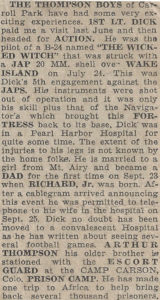 And, here are two photos of the Thompson family, at Brooke Army Hospital. Brother Art and his wife Kay stand at rear, while Dick, Betty, and baby son Richard, Jr. (born in September, 1943) in foreground.
And, here are two photos of the Thompson family, at Brooke Army Hospital. Brother Art and his wife Kay stand at rear, while Dick, Betty, and baby son Richard, Jr. (born in September, 1943) in foreground.
Unfortunately, Dick’s leg would never completely heal. It was amputated in 1946, with Dick being medically retired from the military.
______________________________
Life moves forward.
Here’s a picture of Dick in a 1974 advertisement for the Sun Petroleum Company. However, there’s no actual recollection of how he came to work for Sun. As remembered by Rich, his grandfather [Dick’s father], “…Everett sold Cabot paints so being around a salesman must have turned him into one. His brother Art had a paint store in Long Beach, CA so that sort of thing was in their DNA. … It’s easy for me to say he was very good at it as he was chosen to appear in trade magazines representing Sunoco. …He enjoyed working for Sun for at least most of his career. I seem to remember however, that towards the end of his career, it was like they were trying to push out the good old boys and their way of doing business over 3 martini lunches – but that’s just my take. I think he was about ready for more golf, flying to Myrtle Beach for more golf, visiting his brother in CA and doing things not possible while raising a family.”
 This image, from the late 1970s, was taken at Pearson Airport, Vancouver, Washington. Rich, “lived on the hill behind the airport in late ‘70s and dad really liked being able to sit in the house or porch and look across the field at “Joliet” (“four niner J”) while he was having a martini.”
This image, from the late 1970s, was taken at Pearson Airport, Vancouver, Washington. Rich, “lived on the hill behind the airport in late ‘70s and dad really liked being able to sit in the house or porch and look across the field at “Joliet” (“four niner J”) while he was having a martini.”
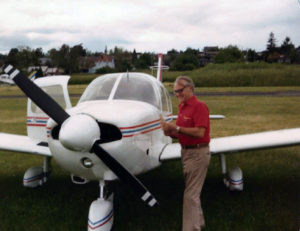 Though the Second World War changed Dick’s life, it did not dominate it. For example, though letters were naturally exchanged with his family after his wound in 1943, he did not keep a diary. According to Dick, “He didn’t have any really bad / negative things to say about his situation or the enemy (e.g. I have one letter where his mother makes mention of “those dirty japs”!)”
Though the Second World War changed Dick’s life, it did not dominate it. For example, though letters were naturally exchanged with his family after his wound in 1943, he did not keep a diary. According to Dick, “He didn’t have any really bad / negative things to say about his situation or the enemy (e.g. I have one letter where his mother makes mention of “those dirty japs”!)”
Similarly, Dick’s discussions of and attitude about the war remained “light”. Rich remembers, “…photos of him shortly after the amputation of him showing off his “stump” at family gatherings and waving it like his arm at folks that were there.
“While growing up, I remember waking up one night when the folks had an adult poker party going and his prostheses was in the center of the table to cover a bet.
“I took him to a party here in Oregon while he was visiting where there was a pool in the back yard. One of the smart-asses among the guests … took the liberty of pushing him into the pool – fully dressed. He could swim like a fish and came back over to the edge of the pool where the ‘perp’ was standing, took off his leg and threw it up in the deck and said – ‘Now look what you’ve done!’ One of the few times I’ve ever known that guest to be speechless.
But, he did seem to have been particularly close to co-pilot, John Lowry, in whose memory he was proud to have named his second son, John. In time, John Thompson attended college in Atlanta, and became friends (“…he was given V.I.P. treatment…”) with Lowry’s wife Margaret, who had remarried and had twin daughters and lived in Smyrna.
As remembered by John, “There were two family ‘reunions’ with Margaret Lowry / Mellon. The first was in 1966 when Mom came down to pick me up after my first year at college. There was a relationship between the two wives which indicates that they were together during some part (training)? of Dad and Jack’s early military career. The second and last reunion … was in 1969 when my parents … drove down for my graduation.”
______________________________
The past remains within the present. In June of 2015, this took the form of a visit by the Collings Foundation Wings of Freedom Tour to Portland, Oregon. Rich, “…got there Sunday afternoon and didn’t even get to see the planes in the air but vowed to return at next opportunity and participate in what they call a “flight experience” and actually take a ride in the B-24 WITCHCRAFT.
“During the visit, the flight engineer found me and three other people up on the flight deck. He wanted us out of there and apologized that they forget to put the ‘NO ENTRY’ rope across the opening. While talking with one of the people – an elderly gentleman accompanied by his family – the engineer learned that this fellow flew B-24s during WW II training pilots, and became very cordial, telling the old pilot, have a seat, stay as long as he liked, and insisted he leave a note and sign his log book.
Then I saw my chance and dug out an old photo of dad with his head out the pilot’s window on the WICKED WITCH. He asked “Who is this”? I said, “My Father”. His jaw dropped to the floor! Once recomposed, he squatted down and looked down the bomb bay catwalk, now crowded with people and told them he had a pilot and the son of another pilot on the flight deck and asked for their patience while we finished up.
I met the engineer later and showed him the photos you’ve been looking at and gave him a big THANK YOU.
Great day!”
The memory of that 2015 day – full circle from July of 1943 – is shown below.
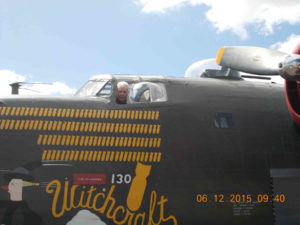 ______________________________
______________________________
Looking back, Rich’s father, “…was always quick to relate how lucky he was to have only lost his leg and that the whole crew went out on the next mission and ended up missing in action.”
And that brings us to a story that, whether true or apocryphal, is deep with meaning, carrying a message universal and perhaps eternal. Curiously, it is a very old Chinese Taoist story about a simple farmer in a poor country village.
While such a tale nature appears – on first reading – to be completely unrelated to aviation and military history, on contemplation, it actually encompasses both, and much more.
For, it is a tale about the nature of life.
______________________________
He [the farmer] was considered very well-to-do, because he owned a horse which he used for plowing and for transportation.
One day his horse ran away.
All the neighbors exclaimed how terrible this was, but the farmer simply said,
“Maybe.”
A few days later the horse returned and brought two wild horses with it.
The neighbors all rejoiced at his good fortune, but the farmer just said,
“Maybe.”
The next day the farmer’s son tried to ride one of the wild horses; the horse threw him and broke his leg.
The neighbors all offered their sympathy for his misfortune, but the farmer again said,
“Maybe.”
The next week conscription officers came to the village to take young men for the army.
They rejected the farmer’s son because of his broken leg.
When the neighbors told him how lucky he was, the farmer replied,
“Maybe.”
(Maybe.)
– February, 2019
Acknowledgements
I’d like to extend my deep appreciation to Rich Thompson and his brother and sister, for sharing the photographs, documents, and information that have made this blog post possible.
References and Suggested Readings
Bell, Dana, Air Force Colors – Pacific and Home Front, 1942-47, Squadron / Signal Publications, Carrollton, Tx., 1997
Birdsall, Steve, B-24 Liberator in Action – Aircraft Number 21, Squadron / Signal Publications Inc., Warren, Mi., 1975
Blue, Allan G., The B-24 Liberator – A Pictorial History, Charles Scribner’s Sons, New York, N.Y., 1975
Cleveland, W.M., Grey Geese Calling : Pacific Air War History of the 11th Bombardment Group (H), 1940-1945, Portsmouth, N.H., 1992
Davis, Larry, B-24 Liberator in Action – Aircraft Number 80, Squadron / Signal Publications Inc., Carrollton, Tx., 1987
Forman, Wallace R., B-24 Nose Art Name Directory – Includes Group, Squadron and Aircraft Serial Numbers and Photo Availability, Specialty Press, North Branch, Mn., 1996
Howard, Clive and Whitley, Joe, One Damned Island After Another, The University of North Carolina Press, Chapel Hill, N.C., 1946
Livingstone, Bob, Under the Southern Cross: The B-24 Liberator in the South Pacific, Turner Publishing Company, Paducah, Ky., 1998
Rust, Kenn C., Seventh Air Force Story, Historical Aviation Album, Temple City, Ca., 1979
Rust, Kenn C. and Bell, Dana, Thirteenth Air Force Story, Historical Aviation Album, Temple City, Ca., 1981 (The Grey Geese were assigned to the 13th AF from January through May of 1943. Subsequently, they were part of the 7th AF.)
By scrolling “down” the post from top to bottom, you’ll see images of the two pages in the Report listing the captions of the photos.
This is followed by a verbatim transcription of the block of the German text in those two pages. The German text is followed by its English-language translation (in italics) which I transcribed from the MACR.
Then, moving “down” through all the pictures…
Each photo has its caption – in both German and English – below it. The English-language translations are presented in italics.
The images and their captions aren’t presented in the same numerical order as in the KU Report. They’re arranged as if you were moving along the plane (or, er, uh…in this case, what’s left of the plane…) from front to rear. I’ve also added comments below some captions.
____________________
DESCRIPTION OF AIRCRAFT 42-63792, AND PHOTO CAPTIONS
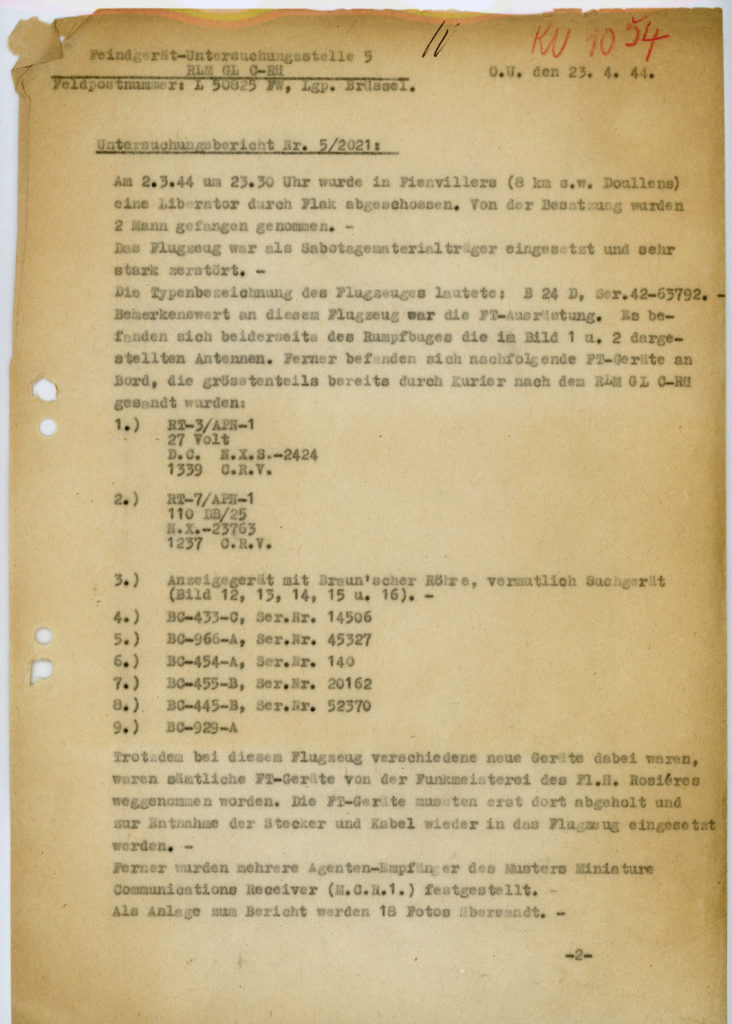
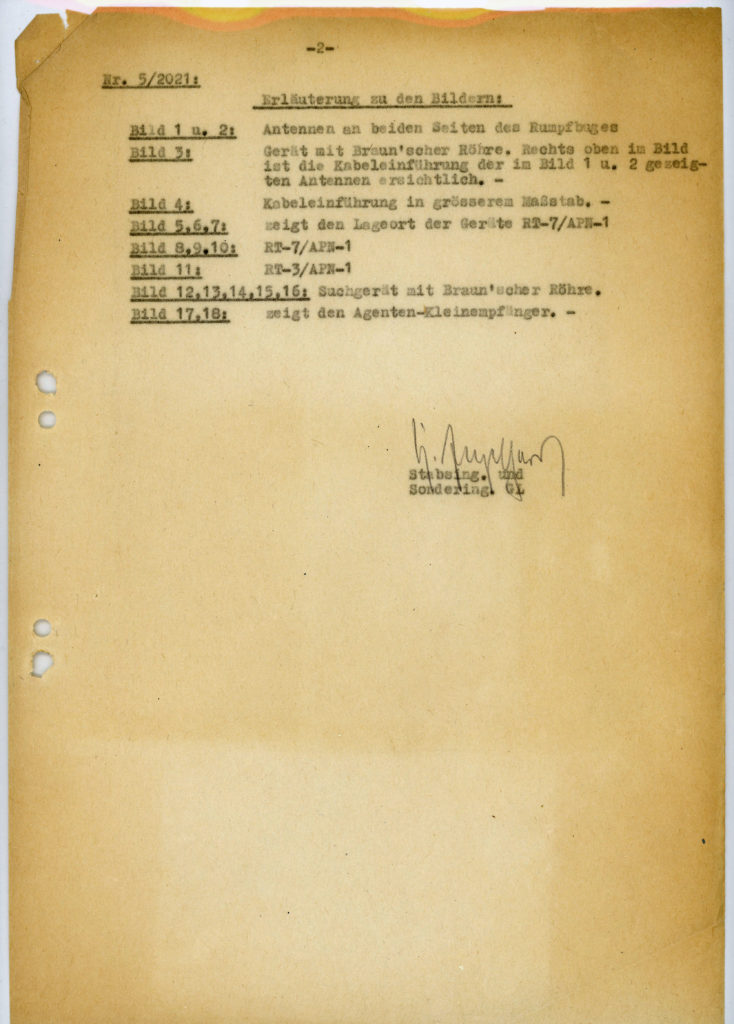 Feindgerät-Untersuchungsstelle 5
Feindgerät-Untersuchungsstelle 5
RLM GL C-Rü O.U. den 23.4.44
Feldpostnummer: L 50825 FW, Lgp. Brüssel.
Untersuchungsbericht Nr. 5/2021:
Am. 2.3.44 um 23.30 Uhr wurde in Fienvillers (8 km s.w. Doullens) eine Liberator durch Flak abgeschossen. Von der Besatzung wurden 2 Mann gefangen genommen.
Das Flugzeug war als Sabotagematerialträger eingesetzt und sehr stark zerstört.
Die Typenbezeichnung des Flugzeuges lautete: B 24 D, Ser. 42-63792. Bemerkenswert an diesem Flugzeug war die FT-Ausrüstung. Es befanden sich beiderseits des Rumpfbuges die im Bild 1 u. 2 dargestellten Antennen. Ferner befanden such nachfolgende FT-Geräte an Bord, die grösstenteils bereits durch Kurier nach dem RLM GL C-Rü gesandt wurden:
1. RT-3 / APN-1
27 Volt
D.C. N.X.S. – 2424
1341 C.R.V.
2. T-7 / APN-1
110 DB / 25
N.X. – 23763
1237 C.R.V.
3. Anzeigegerät mit Braun’scher Röhre, vermutlich Suchgerät (Bild 12, 13, 14, 15 u. 16). –
4. BC-433-C, Ser. Nr. 14506
5. BC-966-A, Ser. Nr. 45327
6. BC-454-A, Ser. Nr. 140
7. BC-455-B, Ser. Nr. 20162
8. BC-445-B, Ser. Nr. 52370
9. BC-929-A
Trotzdem bei diesem Flugzeug verschiedene neue Geräte dabiei waren, waren sämtliche FT-Geräte von der Funkmeisterei des Fl.H. Rosiéres weggenommen worden. Die FT-Geräte mussten erst dort abgeholt und zur Entnahme der Stecker und Kabel wieder in das Flugzeug eingesetzt werden. –
Ferner wurden mehrere Agenten-Empfänger des Musters Miniature Communications Receiver (M.C.R.1.) festgestellt.
Als Anlage zum Bericht werden 18 Fotos übersandt.
Erläutering zu den Bildern:
Bild 1 u. 2: Antennen an beiden Seiten des Rumpfbuges
Bild 3: Gerät mit Braun’scher Röhre. Rechte oben im Bild ist die Kabeleinführung der im Bild 1 u. 2 gezeigten Antennen ersichtlich.
Bild 4: Kabeleinführung in grösserem Masstab.
Bild 5, 6, 7: zeigt den Lageert der Geräte RT-7 / APN-1
Bild 8, 9, 10: RT-7 / APN-1
Bild 11: RT-3 / APN-1
Bild 12, 13, 14, 15, 16: Suchgerät mit Braun’scher Röhre.
Bild 17, 18: zeigt den Agenten-Kleinempfänger.
Engelhard
Stabsing. Und
Sondering. GL
____________________
Enemy equipment investigation center 5 KU 1154
Ministry of the Air Force GL C-Rue Local Quarters, 23 April 1944
Field postal No L 50825 FW
Air District Post Office Brussels
Investigation Report No 5 / 2021
On 2 March 1944 at 2330 a Liberator had been shot down by anti-aircraft over Fienvillers (8 km southwest of Doullens). Two members of the crew had been captured. The plane was equipped as sabotage material-carrier and therefore very seriously damaged.
The type markings of the plane were as follows: B 24 D, Serial No. 42-63792. This plane was equipped with remarkable radio equipment. There were aerials on both sides of the front of the fuselage as pictures 1 and 2 show. Further, there was the following radio equipment on board, the greatest part of which has been sent by messenger to the Ministry of the Air Dorces GL C-Rue.
1. RT-3 / APN-1
27 Volt
D.C. N.X.S. – 2424
1341 C.R.V.
2. RT-7 / APN-1
110 DB / 25
N.X. – 23763
1237 C.R.V.
3. Indicator-set with Bruan’scher tube, probably search-equipment (see picture 12, 13, 14, 15 and 16)
4. BC-433-C, Ser. No. 14506
5. BC-966-A, Ser. No. 45327
6. BC-454-A, Ser. No. 140
7. BC-455-B, Ser. No. 20162
8. BC-445-B, Ser. No. 52370
9. BC-929-A
Though this plane was equipped with different kinds of new radio equipment, all radio equipment had been taken out by the radio office of the Air-base Rosieres. The radio equipment had to be obtained from that office, and for the purpose of the removal of the plugs and cables had to be installed again into the plane. Also, several agent receivers of the type “Miniature Communications Receiver (M.C.R. 1)” were found.
Enclosed in this report 18 photographs.
Photo explanation.
Picture 1 and 2: Antenna on both sides of the front of the fuselage.
3: Equipment with Bruan’scher tube. In the right upper corner of the picture the cable installation of the antenna (shown in picture 1 and 2) can be seen.
4: Cable installation on larger scale.
5, 6, 7: shows the location of the equipment RT-7 / APN-1
8, 9, 10: RT-7 /APN-1
11: RT-3 / APN-1
12, 13, 14, 15, and 16 Search equipment with Braun’scher tube.
17 and 18: Shows the Miniature-Communications-Receiver.
Enclosures:
Instructions for the
“Miniature Communications Receiver”
and 18 photographs.
Signed: Engelhard
Staff-Engineer and Special Engineer
____________________
Photos: Crash Site, APN-1 Antenna, and BC-929-A “Rebecca” Radar Interrogator Unit
____________________
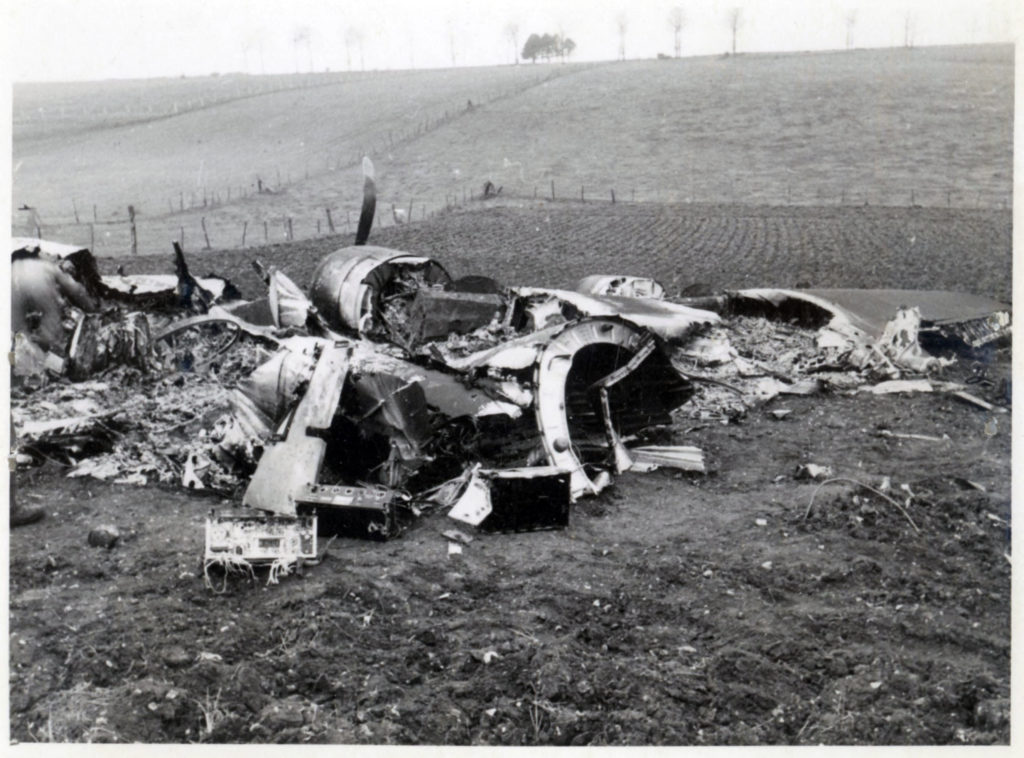
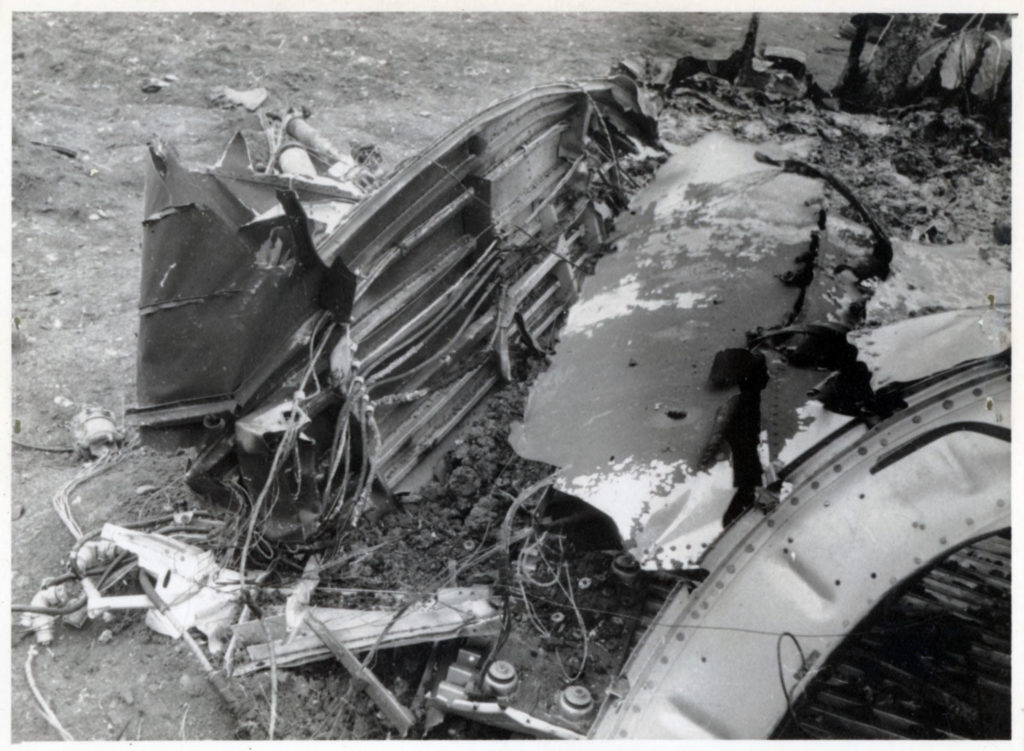
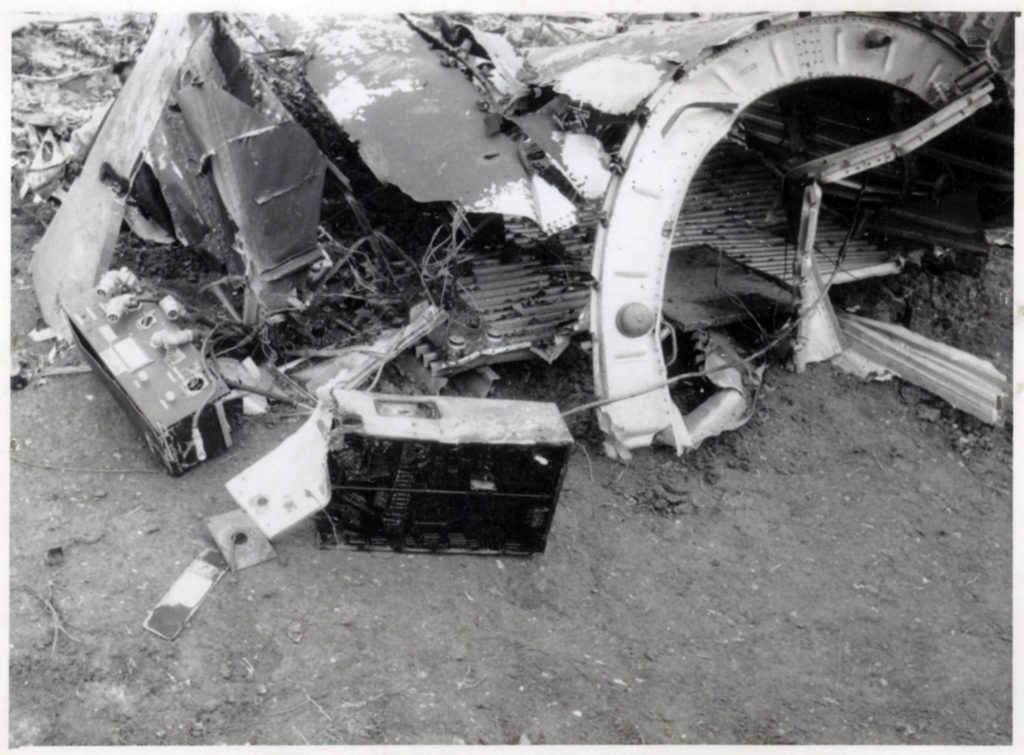 These three un-numbered images show the scope and scene of the plane’s crash. Most of the airframe and wings have been destroyed (the tail and left wing broke off during the crash) but ironically, several components of the plane’s special electronic equipment, situated in the central fuselage and nose, survived relatively or completely intact. These have been extracted from the fuselage and placed in front of the wreckage.
These three un-numbered images show the scope and scene of the plane’s crash. Most of the airframe and wings have been destroyed (the tail and left wing broke off during the crash) but ironically, several components of the plane’s special electronic equipment, situated in the central fuselage and nose, survived relatively or completely intact. These have been extracted from the fuselage and placed in front of the wreckage.
____________________
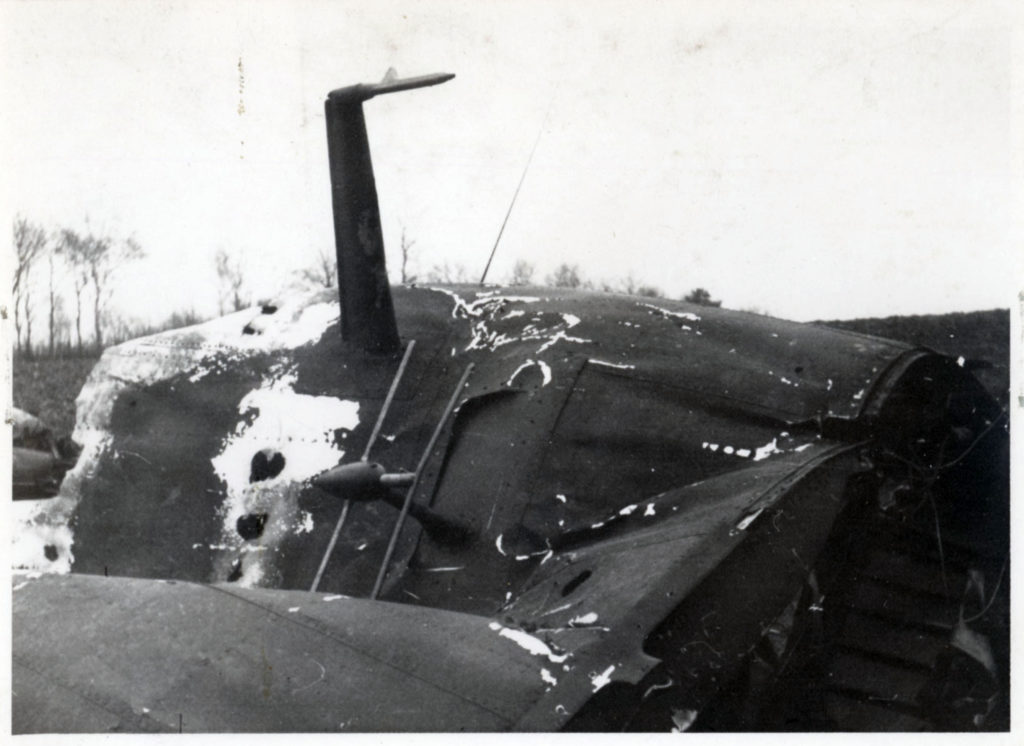 Bild 1 u. 2: Antennen an beiden Seiten des Rumpfbuges
Bild 1 u. 2: Antennen an beiden Seiten des Rumpfbuges
Picture 1 and 2: Antenna on both sides of the front of the fuselage.
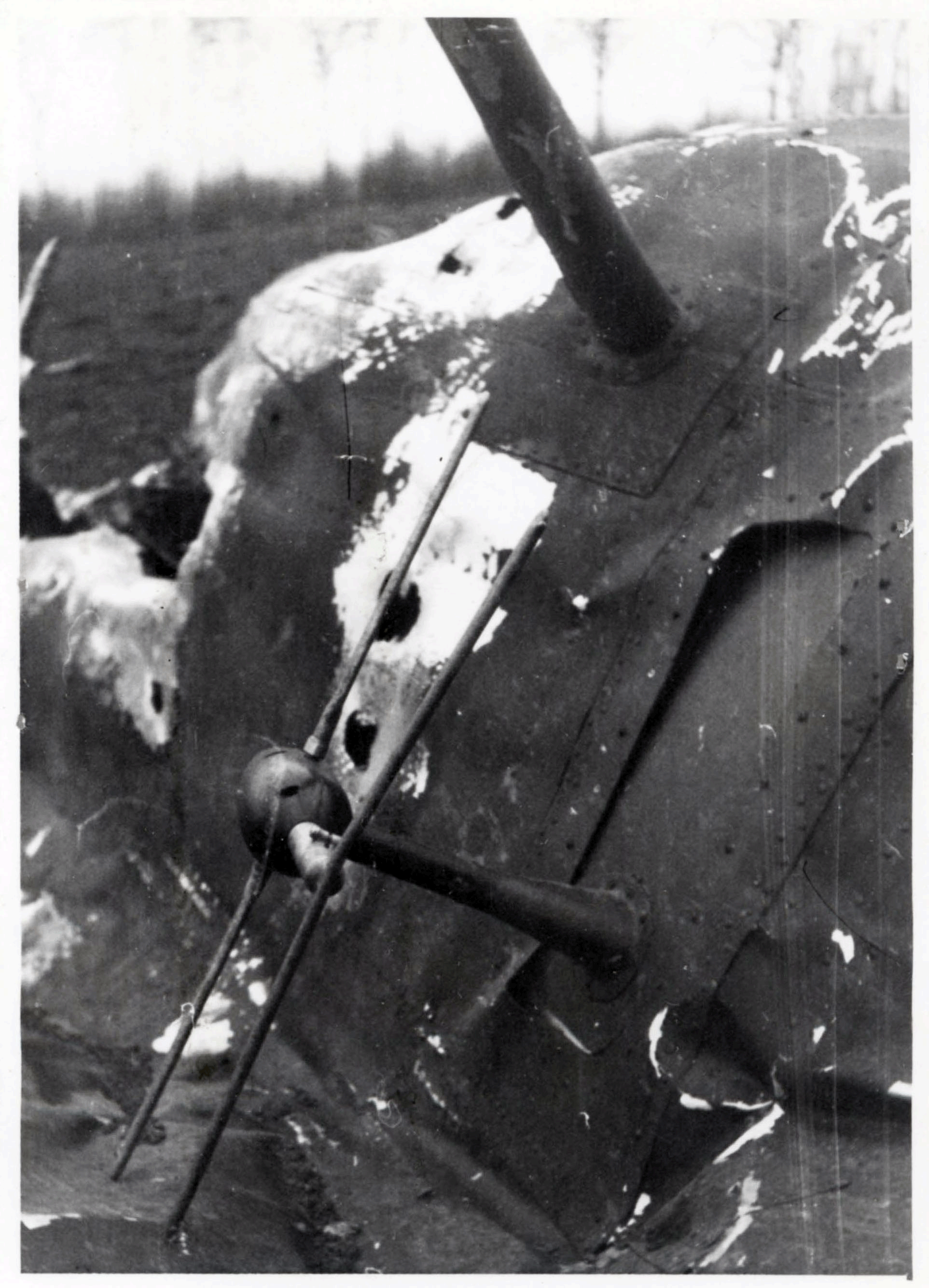 Bild 1 u. 2: Antennen an beiden Seiten des Rumpfbuges
Bild 1 u. 2: Antennen an beiden Seiten des Rumpfbuges
Picture 1 and 2: Antenna on both sides of the front of the fuselage.
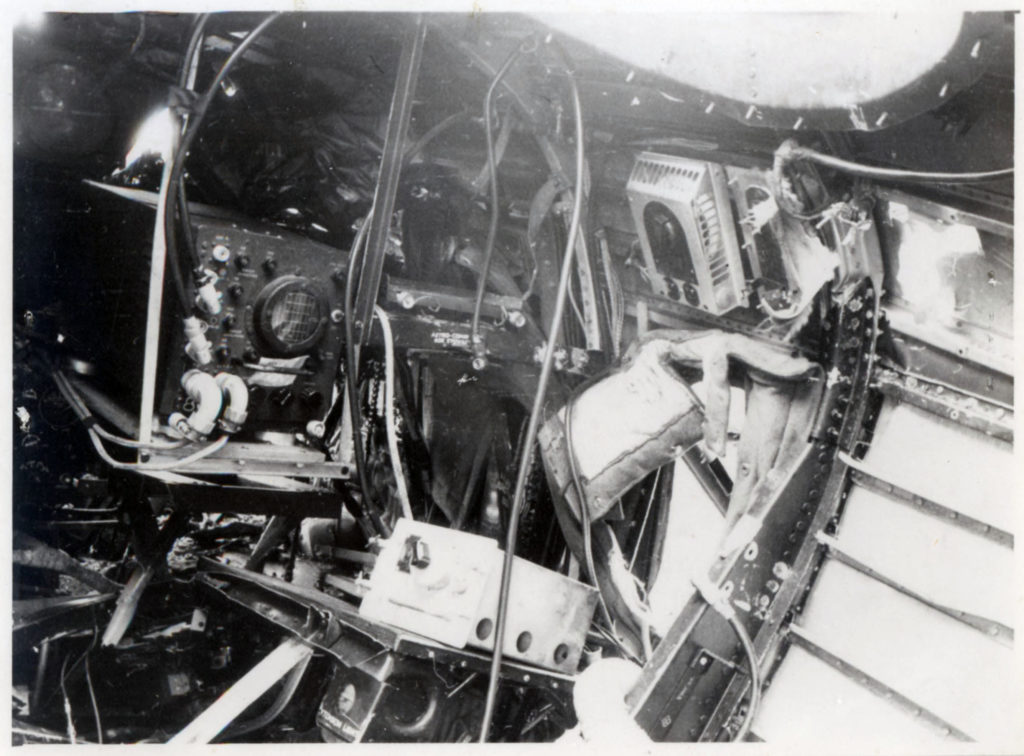 Bild 3: Gerät mit Braun’scher Röhre. Rechte oben im Bild ist die Kabeleinführung der im Bild 1 u. 2 gezeigten Antennen ersichtlich.
Bild 3: Gerät mit Braun’scher Röhre. Rechte oben im Bild ist die Kabeleinführung der im Bild 1 u. 2 gezeigten Antennen ersichtlich.
Picture 3: Equipment with Bruan’scher tube. In the right upper corner of the picture the cable installation of the antenna (shown in picture 1 and 2) can be seen.
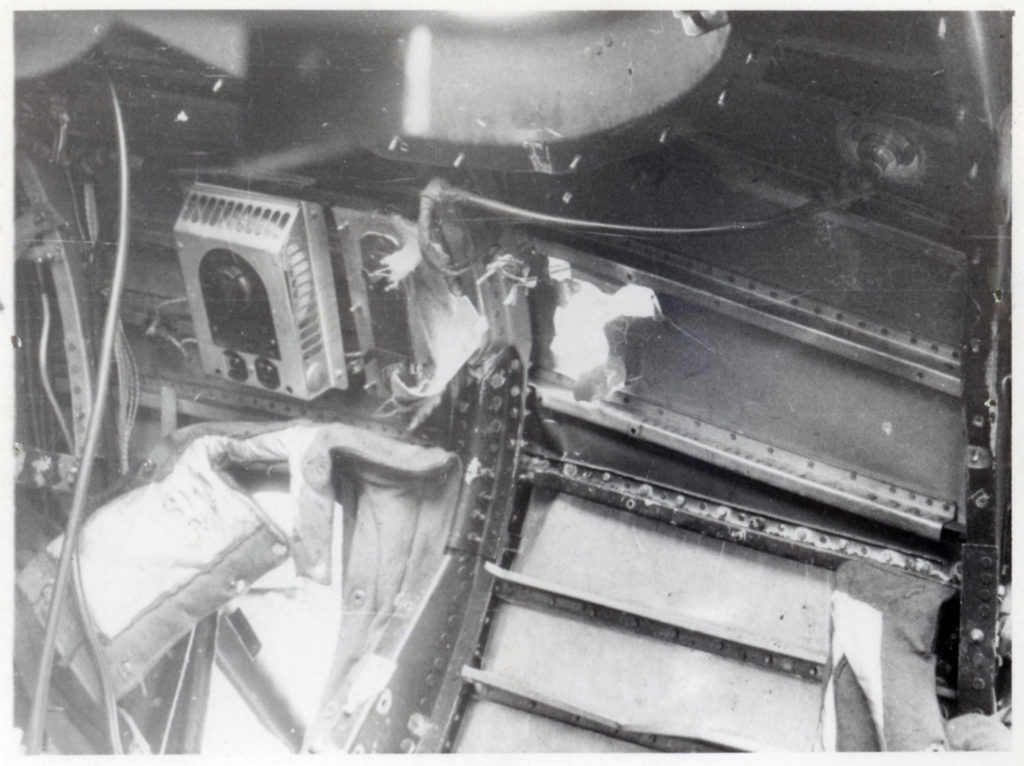 Bild 4: Kabeleinführung in grösserem Masstab.
Bild 4: Kabeleinführung in grösserem Masstab.
Picture 4: Cable installation on larger scale.
Comments for Photos 1, 2, 3, and 4: Close-ups of nose-mounted external receiving antenna associated with the APN-1 radar altimeter, and, the interior electrical connection of an APN-1 antenna within the fuselage. Notably, the nose-mounted BC-929-A “Rebecca” Radar Interrogator unit and its attached cables (in photo 3) are completely intact.
____________________
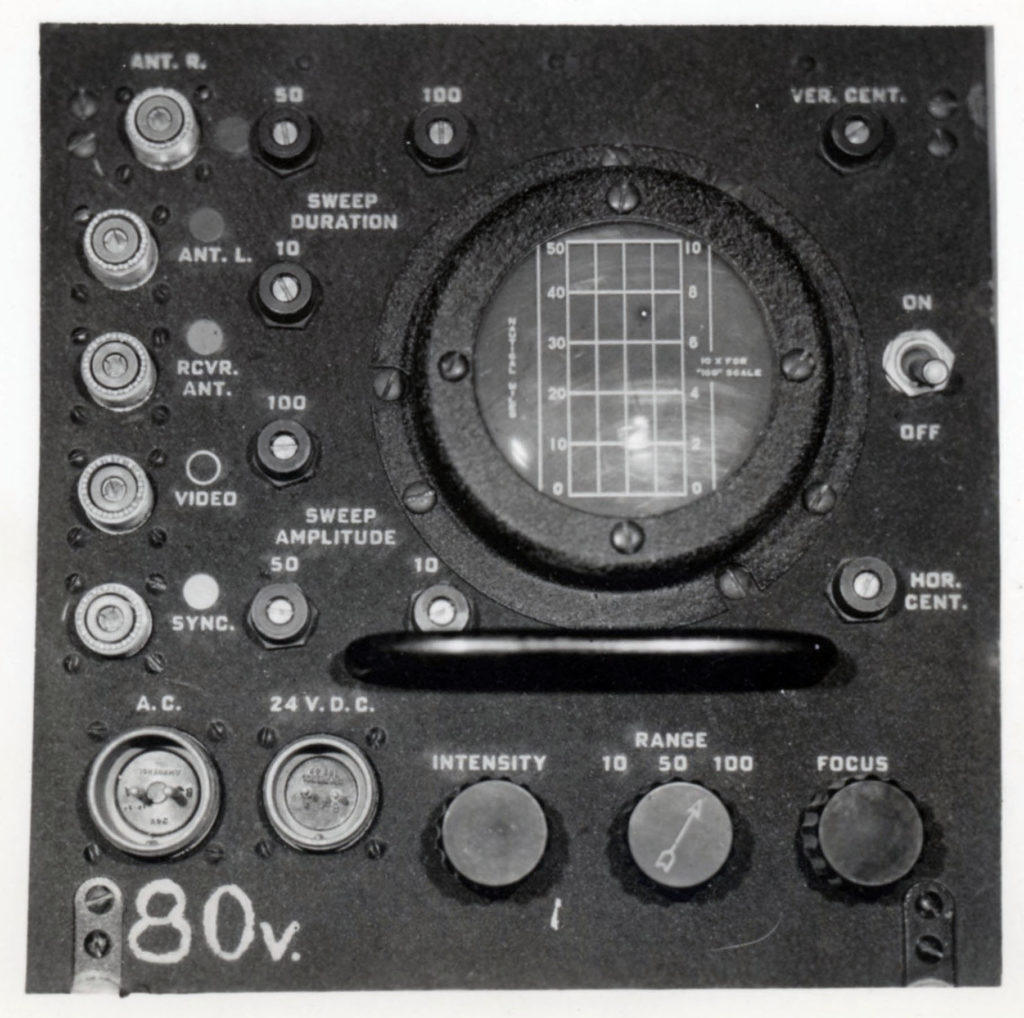 Bild 12, 13, 14, 15, 16: Suchgerät mit Braun’scher Röhre.
Bild 12, 13, 14, 15, 16: Suchgerät mit Braun’scher Röhre.
Pictures 12, 13, 14, 15, and 16: Search equipment with Braun’scher tube.
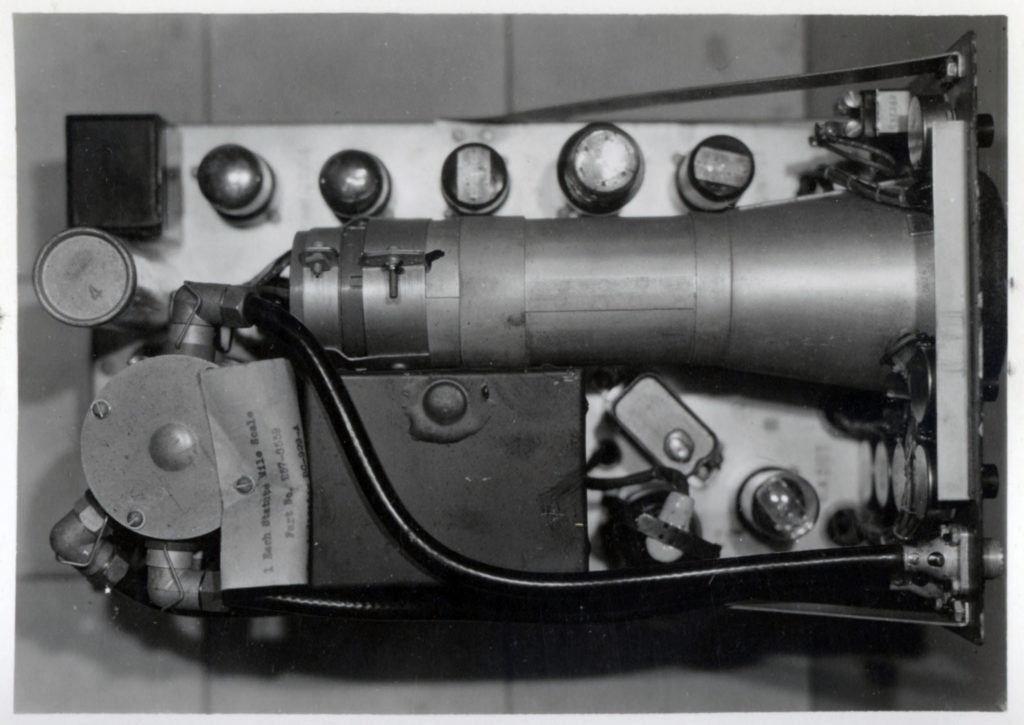 Bild 12, 13, 14, 15, 16: Suchgerät mit Braun’scher Röhre.
Bild 12, 13, 14, 15, 16: Suchgerät mit Braun’scher Röhre.
Pictures 12, 13, 14, 15, and 16: Search equipment with Braun’scher tube.
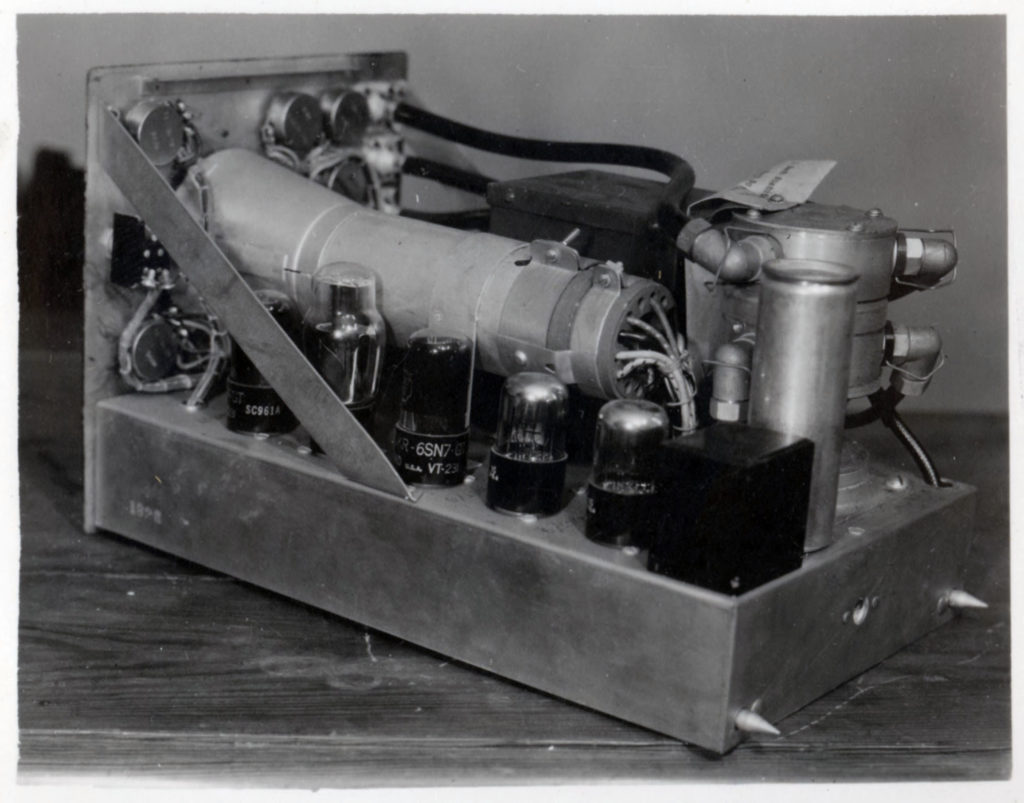 Bild 12, 13, 14, 15, 16: Suchgerät mit Braun’scher Röhre.
Bild 12, 13, 14, 15, 16: Suchgerät mit Braun’scher Röhre.
Pictures 12, 13, 14, 15, and 16: Search equipment with Braun’scher tube.
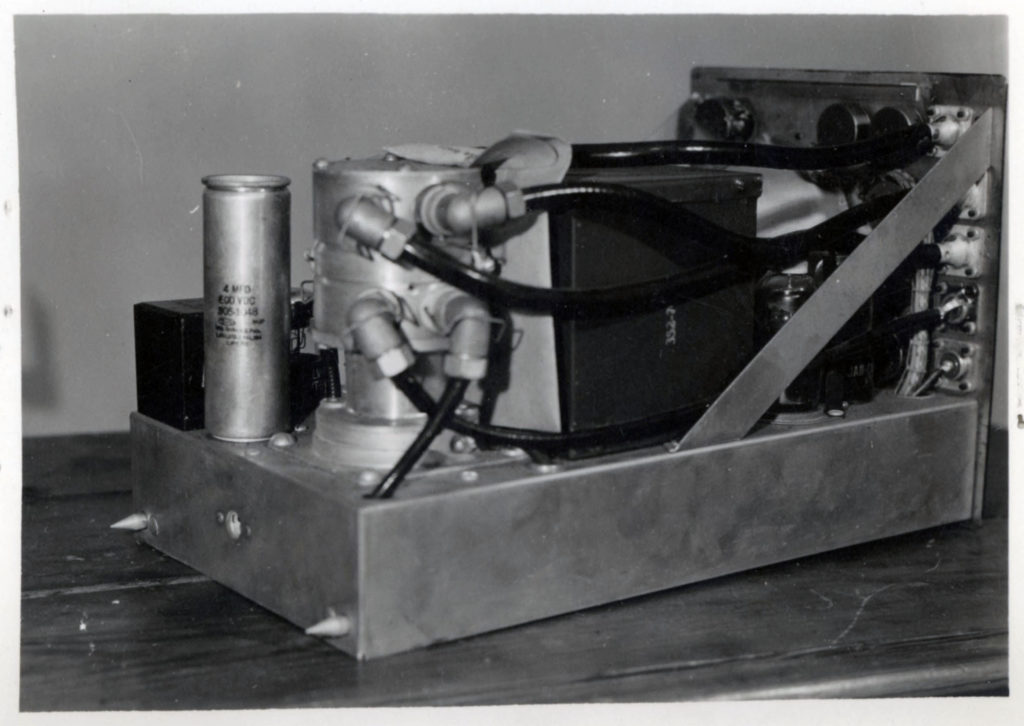 Bild 12, 13, 14, 15, 16: Suchgerät mit Braun’scher Röhre.
Bild 12, 13, 14, 15, 16: Suchgerät mit Braun’scher Röhre.
Pictures 12, 13, 14, 15, and 16: Search equipment with Braun’scher tube.
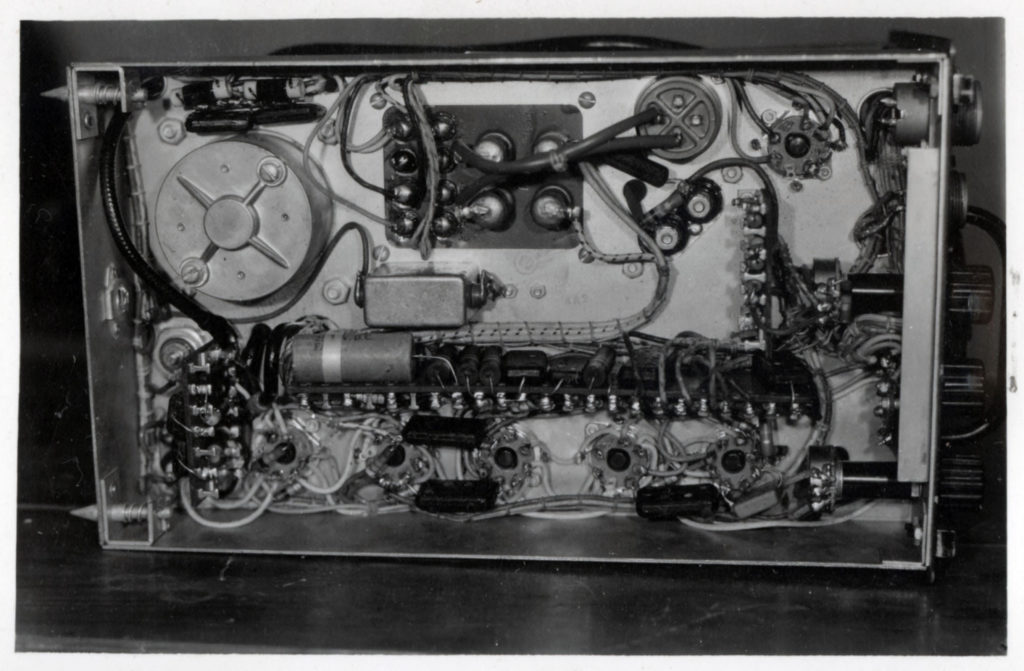 Bild 12, 13, 14, 15, 16: Suchgerät mit Braun’scher Röhre.
Bild 12, 13, 14, 15, 16: Suchgerät mit Braun’scher Röhre.
Pictures 12, 13, 14, 15, and 16: Search equipment with Braun’scher tube.
Comments for photos 12, 13, 14, 15, and 16: These are external and internal views of the BC-929-A Rebecca Radar Interrogator. The phrase “Braun’scher Röhre” (Braun’scher tube) is German for “cathode ray tube”, the first such device having been invented by a Dr. Karl Ferdinand Braun in 1897.
The remaining photographs are presented on the next blog post…
]]>By nature, Luftgaukommando Reports comprise records compiled by the Germans, and not uncommonly, include documents (personal and otherwise) and other items, such as V-Mail and hand-written correspondence, carried or worn (dog tags) by air crewmen.
That “first” post (a multitude of keystrokes ago…!) focused on Luftgaukommando Report J 2525, which covers “Chicago’s Own”, a P-51D Mustang (44-41010) of the 353rd Fighter Squadron of the 354th Fighter Group, which was piloted by Captain Gordon T. McEachron, and served to introduce and describe general aspects of Luftgaukommando Reports.
What makes Luftgaukommando Report J 2525 noteworthy is the presence of several excellent photographs of the downed and mostly intact – albeit no longer quite flyable! – Mustang.
Report J2525 is one of the very few Luftgaukommando Reports containing photographs. Sometimes, like the pictures of Chicago’s Own, such images suggest the features, components, and design aspects of American warplanes that particularly drew the attention of German investigators and technical analysts.
In a large sense, perhaps an apt word for such images is “evocative”. It’s one thing to read “about” the loss of an American military plane in a book, article, or Missing Air Crew Report. It’s quite another to actually see and hold an image of what that aircraft looked like, to those who actually flew within it over seven decades ago.
____________________
This post presents another series of German photographs of a downed American warplane: An entirely intact yet rather broken 8th Air Force B-24 Liberator – ironically nicknamed “Tell Me More” – which was examined by the Germans after force-landing in Holland on April 29, 1944. The 15 images presented here, in Luftgaukommando Report KU 1679, represent the second highest total quantity of images found in any of the Luftgaukommando Reports (whether J, KU, or ME Reports) I’ve thus far examined. (The largest quantity of photographs in a Luftgaukommando Report– 19 – hopefully the subject of a future post!)
“Tell Me More”, a B-24H 41-28754 of the 787th Bomb Squadron, 466th Bomb Group, 8th Air Force, squadron code 6L * N, was piloted by 1 Lt. Carl E. Hitchcock, and was lost during the Group’s mission to Berlin on April 29, 1944. Its loss is covered in MACR 4447. The 466th lost one other Liberator that day (41-29399, “T9 * D”, of the 784th Bomb Squadron, covered in KU 1681) while the 8th Air Force lost 61 other B-17s and B-24s; the 15th Air Force 4 B-24s.
In human costs, approximately six hundred and seventy men.
According to tables of B-24 Liberator serial numbers in Allan Blue’s The B-24 Liberator (pp. 195 and 202), Tell Me More was a B-24H-1DT, and – going by serial numbers alone, rather than calendar date of manufacture and delivery – was the very first ”H” version of all 3,100 B-24H Liberators manufactured.
The crew list from the MACR is shown below:
Neither the MACR nor the KU Report contain information describing the actual cause of the aircraft’s loss. The KU Report simply states that the plane, “made an emergency landing 6 km east of Apeldoorn”, also vaguely mentioning “Liberator Shot Down”. Regardless, as can be seen from the list in the MACR and KU Report, the entire crew of 10 was eventually captured.
Fortunately, all survived the war.
They were:
Pilot – Hitchcock, Carl Edward, 1 Lt., 0-664597
Mrs. Mary Hitchcock (mother), North Bradley St., McKinney, Tx.
Born 1/17/15, Tx.; Died 9/23/95
Buried Sunset Memorial Park, San Antonio, Tx.
POW Stalag 7A (Moosburg)
Captured by 6/22/44
Co-Pilot – Young, Lloyd G., 2 Lt., 0-680791
Mrs. Mary Young (mother), Park View Ave., Knoxville, Tn.
Born 9/25/18, Smith County, Tn.
POW Stalag Luft 3 (Sagan)
Captured May 3, 1944, at Vorort v Tiel, by Officer Heitzwebel
Navigator – Willson, Robert Edwin, 2 Lt., 0-698245
Mrs. Frances (Gardner) Willson (wife), 3026 Lebanon, El Paso, Tx.
Born 9/9/20, Sherman, Tx.; Died 2/3/08
Buried Dallas – Fort Worth National Cemetery, Dallas, Tx.
On tombstone – “Ex-POW – It is well with my soul.”
POW – Camp Unknown
Captured by 6/22/44
Robert Willson’s tombstone, photographed by FindAGrave contributor William Nance, is shown below:
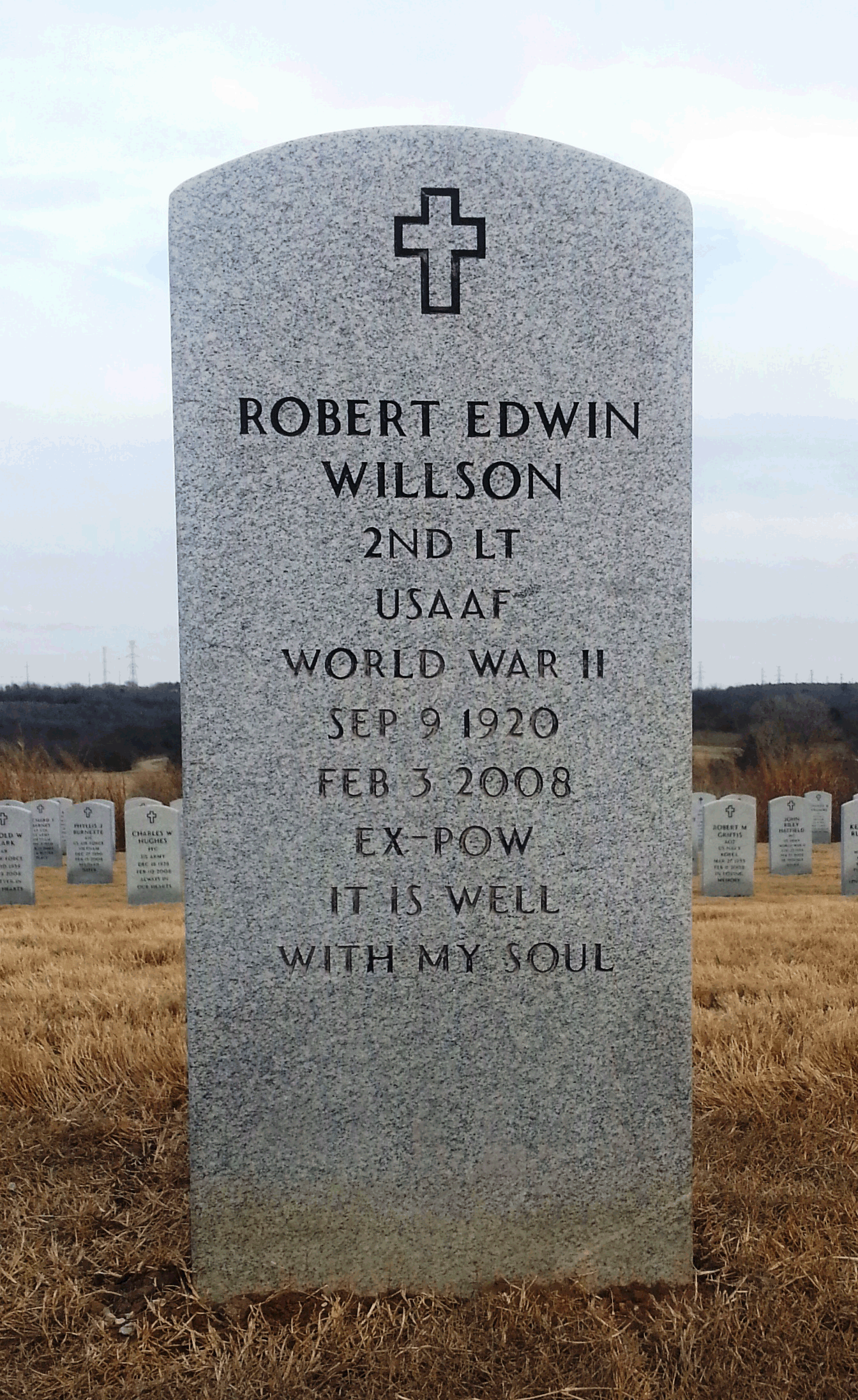 Bombardier – Bochicchio, Vito Joseph, 2 Lt., 0-682047
Bombardier – Bochicchio, Vito Joseph, 2 Lt., 0-682047
Mrs. Margaret Bochicchio (mother), West 21st St., New York, N.Y.
Born 1/1/17, New York, N.Y.; Died 3/23/10
Buried Calverton National Cemetery, Calverton, N.Y.
POW Stalag Luft 3 (Sagan)
Captured May 3, 1944, at Vorort v Tiel, by Officer Heitzwebel
Flight Engineer – DiManno, Carmine Gerard, T/Sgt., 31276739
Mrs. Mary Dimanno (mother), 19 Orchard St., Hartford, Ct.
Born 7/7/23; Died 5/29/77
Buried East Cemetery, Manchester, Ct.
POW Stalag Luft 4 (Gross-Tychow)
Probably Captured April 29, 1944, near Apeldoorn
Radio Operator – McCue, Thomas J. (“Thomas Francis”?), S/Sgt., 12188732
Mrs. Lee V. McCue (mother), 476 Dean St., Brooklyn, N.Y.
POW Stalag Luft 4 (Gross-Tychow)
Captured April 29, 1944, near Apeldoorn
Gunner (Ball Turret) – Browne, Charles Graham, S/Sgt., 19116027
Mrs. Agnes G. Browne (mother), East South Mariposa St., Glendale, Ca.
Born 12/21/19, Twin Falls, Id.
POW Stalag Luft 3 (Sagan)
Captured April 29, 1944, near Apeldoorn
Gunner (Right Waist) – Smith, David Leon, S/Sgt., 18213749
Mrs. Mary Smith (mother), General Delivery, New Franklin, Mo.
POW Stalag Luft 1 (Barth)
Captured by January 5, 1945
Gunner (Left Waist) – Lugosi, Alex Paul, S/Sgt., 36631214
Mrs. Anna Lugosi (mother), 12632 Wallace St., Chicago, Il.
Born 11/11/21, Chicago, Il.
POW – Camp Unknown (numerical indicator is “0”)
Captured April 29, 1944, near Apeldoorn
Gunner (Tail) – Dorrian, Thomas George, S/Sgt., 12121740
Mr. James Dorrian (father), 2541 99th St., East Elmhurst, Long Island, N.Y.
Born New York, N.Y.
POW Stalag Luft 3 (Sagan)
Captured April 29, 1944, near Apeldoorn
____________________
The crew list and other documents in the KU Report imply that the crew split up after landing – the enlisted men in one group, and the four officers in two pairs – in an attempt to evade capture. This is suggested by their dates of capture, which are listed in the KU Report as follows:
Captured on April 29, at Apeldoorn:
T/Sgt. Carmine G. DiManno (flight engineer)
S/Sgt. Thomas J. McCue (Radio Operator)
S/Sgt. Charles G. Browne (Ball Turret Gunner)
S/Sgt. Alex P. Lugosi (Left Waist Gunner)
S/Sgt. Thomas G. Dorrian (Tail Gunner)
Captured May 3, at “Vorort v Tiel”, by an “Officer Heitzwebel”:
2 Lt. Lloyd G. Young (Co-Pilot)
2 Lt. Vito J. Bochicchio (Bombardier)
Captured by June 22, at an unspecified location:
1 Lt. Carl E. Hitchcock (Pilot)
2 Lt. Robert E. Willson (Navigator)
Managed to evade until early January, 1945; location of capture unspecified:
S/Sgt. David L. Smith (Right Waist Gunner)
____________________
The specific location of the aircraft’s landing is presented as follows:
1) The American Air Museum website lists the plane as having crash-landed at Apeldoorn.
2) The Eighth Air Force Historical Society lists the plane as having landed at Wilp-Achterhoek, in Gelderland.
3) The KU Report gives two locations for the plane’s loss:
a) 6 kilometers east of Apeldoorn
b) 4 kilometers south of Touge
Touge is east-northeast, and Wilp-Achterhoek directly east, of the geographic center of Apeldoorn. Based on this information, I’ve created three Oogle maps at successively larger scales, “zooming in” on the location which seems (seems!) to be the best composite of the above-reported locations. This is denoted by the north-south oriented red ovals superimposed on the map, just southwest of Wilp-Achterhoek, and repeated on the Google Earth view of the same locale.
These maps and the aerial photograph are presented below:
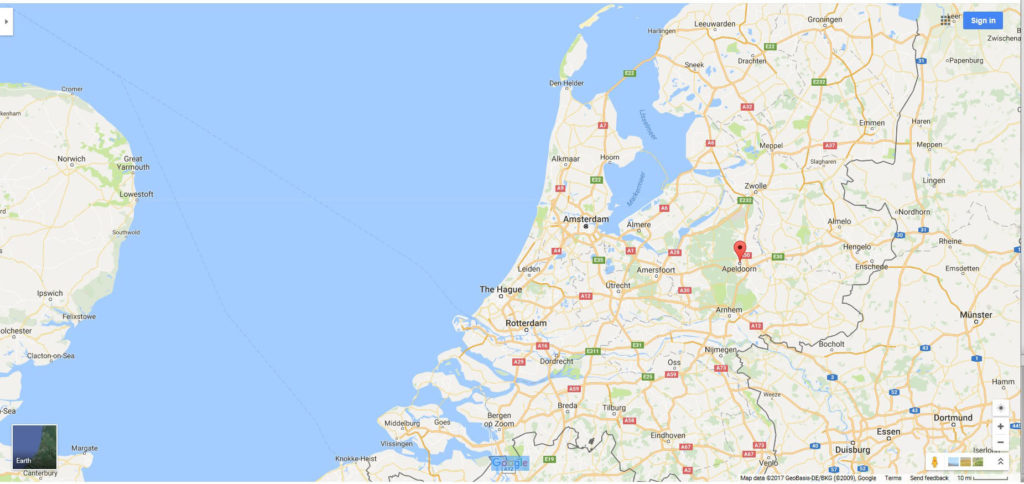
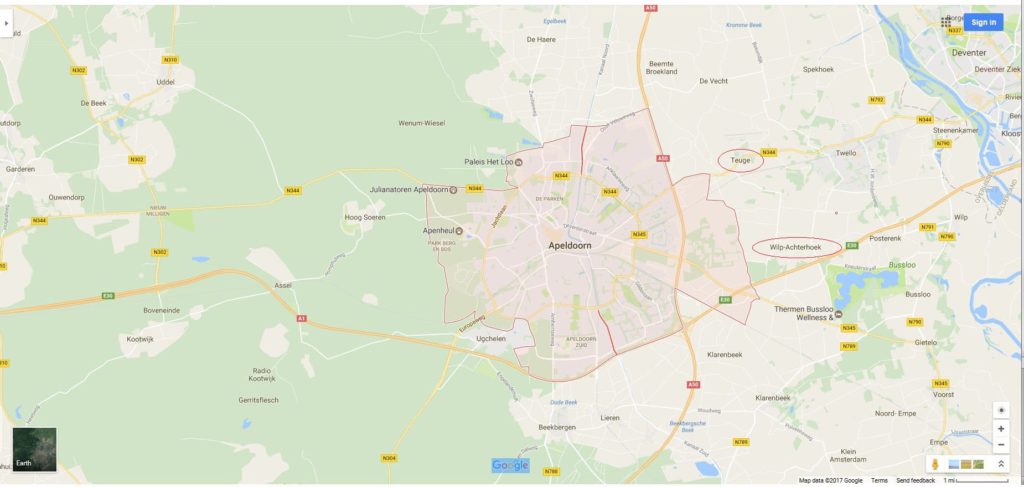
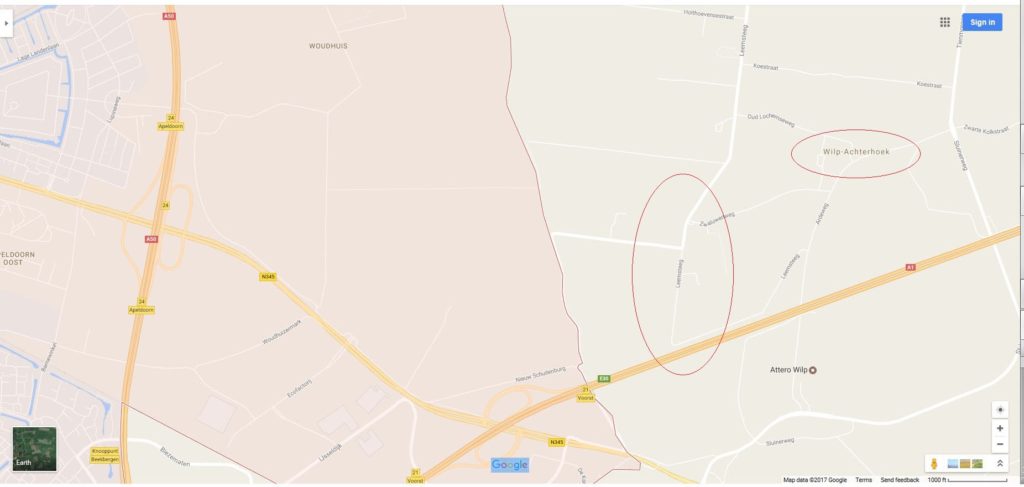
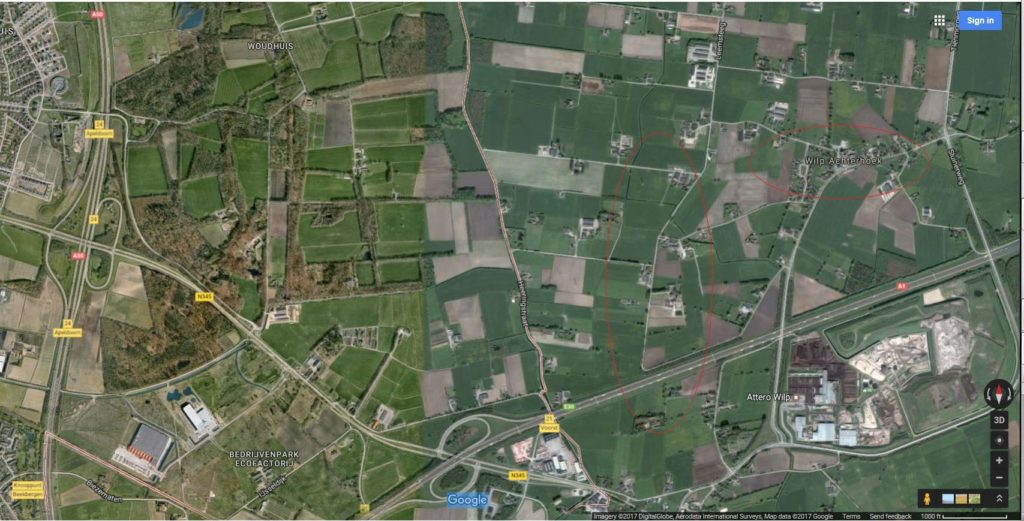 Here is an image of Tell Me More from the American Air Museum website, showing the relatively intact and rather bent B-24 resting on its forward fuselage, on a vacant field. The American Air Museum website includes two other images of the plane, one showing what seems to have been a very hastily applied individual aircraft letter – “N” – on the lower port fin.
Here is an image of Tell Me More from the American Air Museum website, showing the relatively intact and rather bent B-24 resting on its forward fuselage, on a vacant field. The American Air Museum website includes two other images of the plane, one showing what seems to have been a very hastily applied individual aircraft letter – “N” – on the lower port fin.
But, what about the images in the KU Report? To be told more of Tell Me More, refer to the next post…
]]>